JAGUARS and the Wildlife
of the Pantanal
Photo Tour
August-September 2015
Trip Report
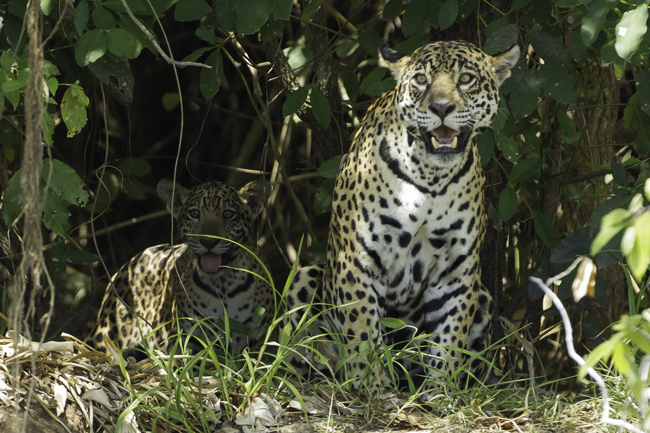
Our first Jaguar, with a cub on the riverbank, just minutes after we started our journey to jaguar country and the first of six days of photographing in Jaguar Land!
All Photos by either Joe or Mary Ann McDonald.
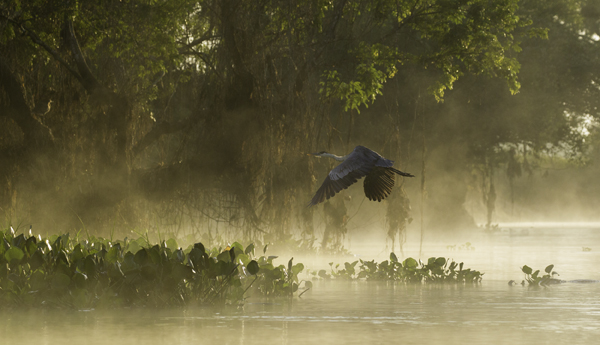
It is so easy to ignore landscapes as one is focused on looking for birds or mammals,
but simply using my 100-400 lens and shooting scenes as we went along,
I caught this iconic image of the Pantanal at dawn.
Jaguar and cub! Tayra! Caiman snapping at Tapir! Wow! Read on!
We only did one trip to the Pantanal this year but it was a great one. One goal we’re still trying to achieve is capturing a Jaguar kill, and although we didn’t get one to our complete satisfaction, we did have three kills, two of which we barely saw, but one, Mary captured well, when the Jaguar climbed up the river bank with a Caiman in its jaws. We had 8 different Jaguars, and probably 12-15 different sightings – after a bit, with the amount of Jaguar activity we were having I simply stopped counting. We missed Jaguars on one day, but on that one we made a special trip up a different river for other subjects, and we were quite successful there.
Our mammal photography was fantastic, with shots of Giant Anteaters, Brazilian Tapirs, a Tayra (a large weasel, an animal I’ve only seen as a roadkill in the Pantanal and alive, once, in Panama), Ocelots (via my Range IR camera trap), Marsh Deer, Brocket Deer, Howler Monkey, Capuchin Monkey, Giant Otter, Neotropical Otter, and of course lots of Jaguars.
Birds were diverse, and although we did not have as much activity with diving Ringed Kingfishers, we did extremely well with Great Black Hawks, Black Collared Hawks, Great Potoos, Capped Herons (always elusive in the past), Agami Herons (the colorful trophy heron), Laughing Falcon, and about forty other species.
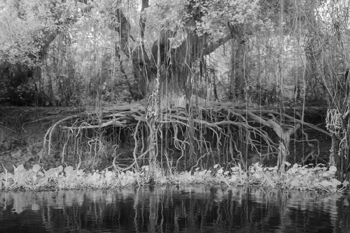 Mary shot a lot with a camera converted to Infrared and loved those scenics, and I, stupidly, realized the potential of my Olympus camera with a pop-out LCD, too late to capitalize on river-level shots of Caimans and Capybaras, although I did some neat stuff with the Capybaras at the very end. Perhaps the Caiman work would have been tricky – hands hanging at water level in Caiman waters …. Smart? We did use GoPros, trying to catch Caimans underwater, but the silt-filled water was so murky that nothing showed. On our last full day I tried doing the same with Piranhas, but got brief, seconds only views for the efforts.
Mary shot a lot with a camera converted to Infrared and loved those scenics, and I, stupidly, realized the potential of my Olympus camera with a pop-out LCD, too late to capitalize on river-level shots of Caimans and Capybaras, although I did some neat stuff with the Capybaras at the very end. Perhaps the Caiman work would have been tricky – hands hanging at water level in Caiman waters …. Smart? We did use GoPros, trying to catch Caimans underwater, but the silt-filled water was so murky that nothing showed. On our last full day I tried doing the same with Piranhas, but got brief, seconds only views for the efforts.
The Pantanal is one of our favorite places, and I was concerned, going into this, that it was getting loved to death, as sometimes as many as 20 boats would be vying for position around a Jaguar. That happened on our trip as well, and on narrow waterways this crowding issue, especially with obnoxious boatmen that pull in front and parallel a jaguar, ruining everyone else’s view as they followed a cat along a river bank. However, for the most part the shooting was quite manageable, and at times, when I felt it was too crowded for a quality experience, we simply left and looked for another jaguar. On several occasions we were the only boats on a cat, and the shooting then, as at other times, was great.
The Pantanal, however, offers so much more than just Jaguars, and although everyone comes there hoping to photograph one, the variety the Pantanal offers makes the experience far richer. We were extremely lucky on our first day in Jaguar Land to have a first – a mother Jaguar and Cub along the riverbank, and I believe everyone got some decent shots of this, a very first experience for us.
On this trip, I used the new Canon 100-400 which I found to be incredibly sharp, which I used for quick shots, flight shots, and for situations where trying to position my heavier lens on a monopod was impractical. I used a 200-400mm mounted on a Really Right Stuff Monopod and Really Right Stuff Pro Monopod head for the times when I was shooting Jaguars with a bit more time (90% of the jaguar shooting. Those two lenses and two camera bodies easily fit inside my Gura Gear Bataflae bags which I kept in the skiff with me as we motored along looking for Jaguars. Mary used basically the same combination, with the 100-400, and a fixed 500mm f4 lens. In the last two trips, Alaska and this one, we've had one photographer on each using the new Sigma 150-600mm image-stabilization lens, and both loved that lens. I used 64 and 32gb Hoodman Cards. When I was shooting on land I used a Wimberley Gimbal II head, mounted on a Really Right Stuff Tripod. I've used the RRS quick release clamps so that I can, when necessary, change from a Wimberley to a BH40 or BH55 head, and I would highly recommend anyone who plans on using two heads on a trip, like a Wimberley and a BH40 oe BH55, use these plates. Just a couple of pieces are involved, and I've listed the pieces for this below, and I can't stress how convenient this system is for switching heads!
TA-LBC: Round lever-release clamp
Round lever-release style quick-release clamp
TH-DVTL-55: Round Dovetail Plate
Round Dovetail Plate
TH-DVTL-40: Round Dovetail Plate
Round Dovetail Plate
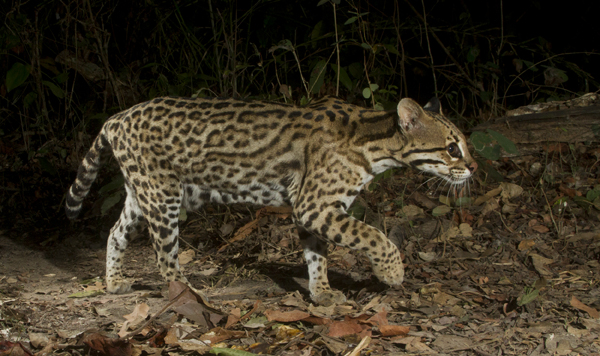
For my remote camera work that I refer to later, I used the RangeIR
camera trigger, and a Really Right Stuff TP-243 Ground 'Pod. I supported my three flashes with 1/4" threaded rods, small ballheads, and Phottix flash slaves, that triggered the flashes from a master mounted on the camera.
Here’s the trip report … which I hope whets your appetite to visit the Pantanal with us, next year! Regarding that, one of the things that struck me was the lack of preparation, or proper gear, I observed with most photographers we saw. I won’t go into details on this, but it was obvious that some folks didn’t have what they should have had, and that pre-trip preparation we give our participants truly set our group apart from a lot of the photographers we saw in the Pantanal. We prepare our folks! Here’s the report:
August 26, 2015. Sao Paulo
We arrived into Brazil and the Sao Paulo Airport in the early morning hours without incident, reaching our overnight stay, the Marriot, by 8, with an early check-in possible by 10. After a breakfast we reached our rooms and slept, until 3 when I visited the exercise room and Mary worked on welcome letters for our upcoming trips. By late afternoon the last of our participants had arrived, putting us in good shape for our flight to Cuiaba the following day with all of our luggage along!
August 27, 2015. Cuiaba to Pouso Curicaca
We didn’t arrive in To Cuiaba until after 2PM, had lunch, and headed west towards the Pantanal, arriving after dark at our first lodge, of one my favorites. It was too late in the evening to attempt a camera trap but Mary and I occupied the time tearing apart our luggage to get ready for the following day’s shoot.
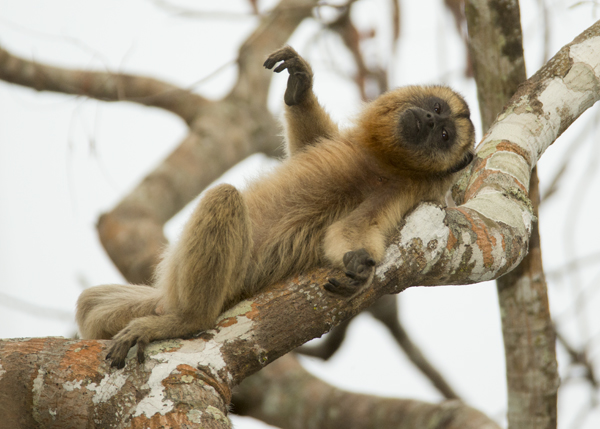
Howler Monkey female, reclining. Male Howler's are black.
August 28, 2015. Curicaca to Puaso Allegre
We awoke around 5:45 with light just coming in to the clearings that surround our cabins. Marcos, our guide, was already at work, and informed us that a group of Coatimundis, long tailed, raccoon relatives, were at the feeder near the dining area. By the time we arrived, just minutes later, the Coatis were gone, but Wood-Rails, Southern Crested Caracaras, Oropendolas, and later, Spectacled Caimans all gathered here for scraps. Eventually the Coatis returned, or one did, a lone male that fearlessly ate nearby.
Near the parking area a pair of Howler Monkeys were visible, although the black male was barely so, hidden in thick leaves. The light brown female was completely in the open, sitting huddled for much of the time but at one point putting on a show, stretching and lying on her back on a branch, before she moved off into thicker cover. Marcos spotted two different Great Pootoos, monstrous nightjars that resemble broken branches as they sit motionless on a limb.
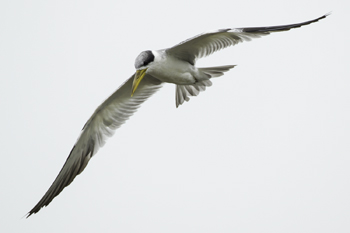
Large-billed Tern
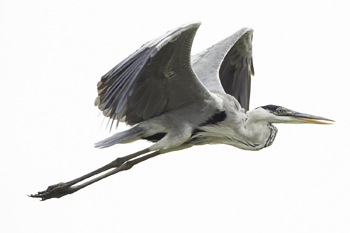
White-necked Heron
After breakfast we headed to the main road to photograph birds, stopping along the way for Black-collared Hawk, White-necked Heron, Amazon and Ringed Kingfishers, and two shy Capped Herons that eluded us. On the main road Large-billed Terns fluttered overhead while the pools were thickly lined with Spectacled Caimans. Last year there had been unusually heavy rains and the Pantanal was still quite wet, and consequently, Caimans were virtually absent. This year, a normal or even exceptionally dry year, Caimans once again line the waterways and ponds, gathered together at the only available water still remaining.
After lunch we headed to our next lodge, Allegre, where we would spend two nights. We arrived by 2:30, and by 4PM we were off, in our open safari vehicle once again, headed to a waterhole where we hoped to find Tapir. 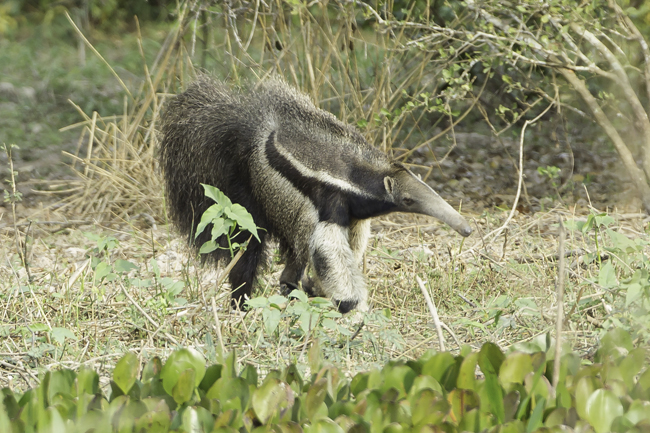
The Giant Anteater at the waterhole.
Shortly after we arrived a Giant Anteater lumbered into view, took a drink, then a U-turn, and headed back the way it had came. A large group of at least 11 Coatimundis visited next, drinking and being threatened by a Sunbittern. No tapirs appeared.
At sunset we headed out on a Night Drive, with Marcos and I using spotlights, and the drive was one of the best, with Collared Peccary, two Brazilian Tapirs – one giving us a very good sighting and some shots, Crab-eating Foxes, and several nightjars. The highlight was another Great Potoo, perched high in a tree. These birds have enormous mouths by which they catch flying insects at night, and I always thought they somehow fed like Whale Sharks, flying mouth open and collecting food. They do not, but instead the bird we watched perched like a hawk and watched the surroundings and, presumably, when a moth flew by, the Pootoo gave chase and caught the moth on the wing. This made perfect sense for such a large bird to sit and wait and watch, and then pursue, rather than flying about as a Nighthawk might.
We reached the lodge close to 9PM for a late lunch and early bed, for a very early departure tomorrow for a predawn game drive.
August 29, 2015. Curicaca to Pouso Allegre
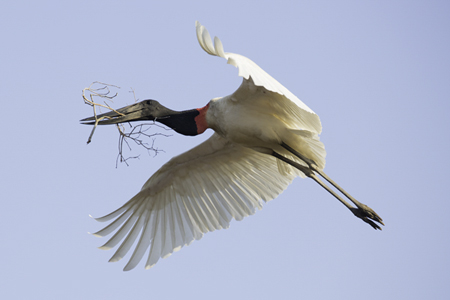
We left the lodge at 4:40AM for a pre-dawn, night game drive, but with the clear skies, ‘super’ moon, and cool temperatures the landscape was shrouded in fog. We spotted nothing of interest before sunrise, and as the sun cleared the trees we stopped at a nice Jabiru Stork nest to photograph the pair in the early light. The birds were collecting nesting material so the activity was constant and we spend nearly 2 hours with the birds. Our safari vehicle drive, Antonio, spotted two Ferringous Pigmy Owls high in a tree, and Bill and Sue, while still in the vehicle, had a good shooting session with a Brocket Deer that passed close by. Coatimundis, skinny, long-nosed relatives to Raccoons, fed in a field close-by when we were driving back to the lodge, a nice treat for the morning shoot.
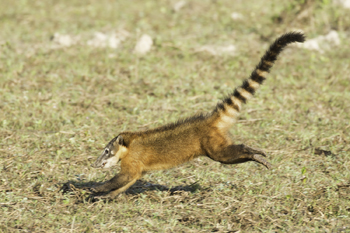
After breakfast we went looking for Marmosets and a roosting Pootoo, and although Mary and I saw the marmosets they were on the run and offered no photos. We couldn’t find the Pootoo, but we have more chances coming up, and we returned to the lodge in late morning to work on birds, download, write, or sleep.
PM. We headed back to the water hole for mammals, while Laurie rode with us as far as a Tiger-Heron nest where she had great luck photographing the normally impossibly elusive Capped Heron. The rest of us parked at the pond, where a Tayra, a large Mustelid (weasel family) trotted by, reminding me more of a prancing Poodle than a loping weasel, their usual gait. The 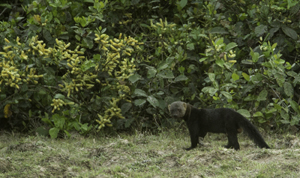 Tayra didn’t stay long but several of us managed a few shots.
Tayra didn’t stay long but several of us managed a few shots.
No giant anteaters arrived and the shooting was slow compared to yesterday, so we headed out for the night game drive and, at first, the drive seemed quite unproductive. As we headed back in to the lodge, however, Marcos spotted a Tapir that was walking towards the road and a roadside pond, where it paused to drink, giving great views. A Caiman glided in, perhaps in defense of its babies, and lunged as the Tapir, and Bob, Sue, and I got shots in varying stages of the lunge – brilliant! The Tapir moved behind us, and we backed up where we had it another nice series, making for a very successful night drive!
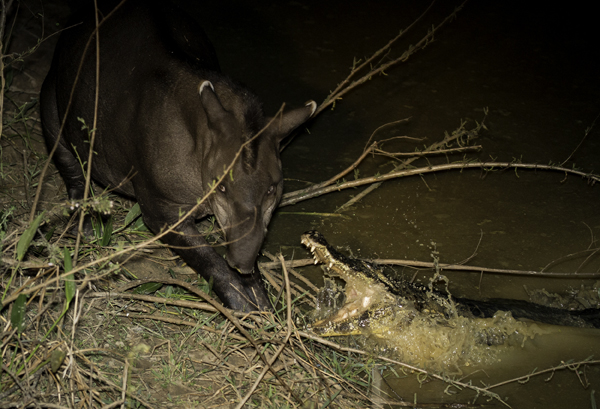
Yacare (spectacled) Caiman lunging at Brazilian Tapir, probably
in defense of her hatchlings in the same small pond.
August 30, 2015. Pouso Allegre to South Wild
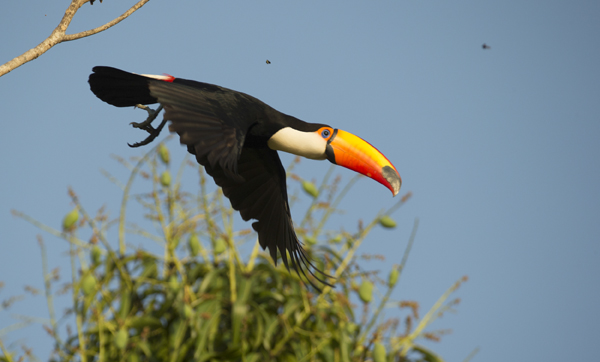
Toco Toucan
We opted to stay around the lodge for the morning shoot, where several people slept in and relaxed, while the rest of us chased Toco Toucans, Hyacinth Macaws, Campo Flickers, Chachalacas, and other birds. Mary spotted a Pigmy Ferruginous Owl, which we managed to shoot before it went into its roost hole, where it stayed before we could summon anyone else to the fleeting opportunity.
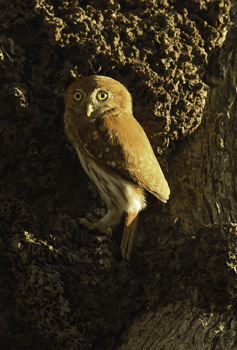
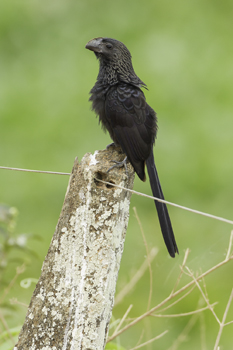
Ferruginous Pigmy Owl; Smooth-billed Ani
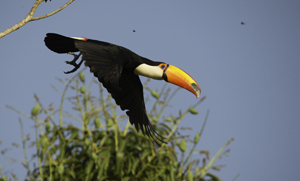
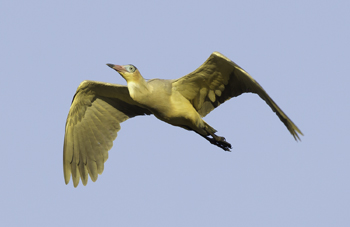
Toco Toucan; Whistling Heron
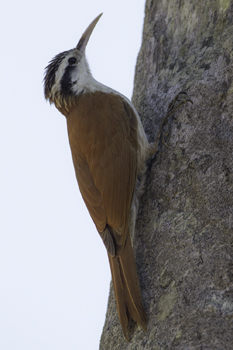
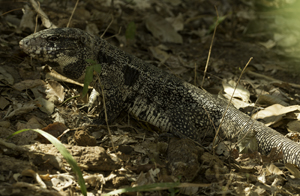
Narrow-billed Woodcreeper; Black and White Tegu
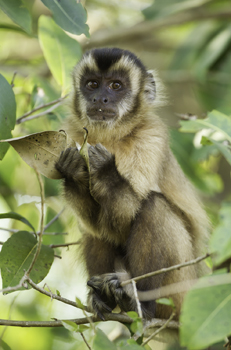 Marcos found a very cooperative troop of Brown Capuchin Monkeys, and Mary and I spent most of the remaining portion of the morning photographing them. Mary managed a trophy shot of the female with a baby on her back, a view that eluded me! Two different hives – one of large colony of Wasps and another of Honeybees – made moving through the forest a little dicey, but the insects ignored us and I shot both hives. A huge Black and White Tegu, a monitor-like lizard, hunted the ground below the monkeys, pausing when it saw me, and giving me a chance for several portraits. Later, I think it caught a snake, for there was much trashing about, but we had to pack to depart and the lizard was in thick undergrowth so I passed.
Marcos found a very cooperative troop of Brown Capuchin Monkeys, and Mary and I spent most of the remaining portion of the morning photographing them. Mary managed a trophy shot of the female with a baby on her back, a view that eluded me! Two different hives – one of large colony of Wasps and another of Honeybees – made moving through the forest a little dicey, but the insects ignored us and I shot both hives. A huge Black and White Tegu, a monitor-like lizard, hunted the ground below the monkeys, pausing when it saw me, and giving me a chance for several portraits. Later, I think it caught a snake, for there was much trashing about, but we had to pack to depart and the lizard was in thick undergrowth so I passed.
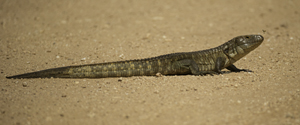 On the way to South Wild another rare lizard, a Caiman Lizard, crossed the road. I’ve only seen one other live specimen, and that was from a boat, so this was a treat. Caiman lizards have powerful jaws and remind me of Savannah Monitors, and they use their thick jaws to crush snails, their normal diet. A bite from one would be extremely painful – imagine the force required for crushing snails daily!
On the way to South Wild another rare lizard, a Caiman Lizard, crossed the road. I’ve only seen one other live specimen, and that was from a boat, so this was a treat. Caiman lizards have powerful jaws and remind me of Savannah Monitors, and they use their thick jaws to crush snails, their normal diet. A bite from one would be extremely painful – imagine the force required for crushing snails daily!
PM. After lunch Marcos, Mary, and I headed into the forest where I would set up a RangeIR camera trap with three flashes. Trying to find a position 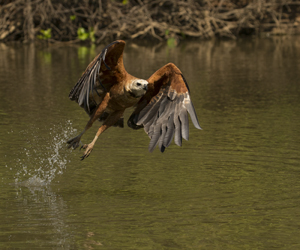 for a back light was difficult, but eventually, with a lot of lashing and another branch as a brace I had that flash, and the others in position. Later, at dusk I’d return to turn on the flashes and camera and hope for the best.
for a back light was difficult, but eventually, with a lot of lashing and another branch as a brace I had that flash, and the others in position. Later, at dusk I’d return to turn on the flashes and camera and hope for the best.
At 3:30 we headed down river trying for flying hawks and kingfishers. Apparently they’d already been fed for although a few Ringed Kingfishers passed by the bait, none hit, and only a few of us were lucky enough to be framed high enough to capture a shot. Three times Black-collared Hawks came in, but only one was reasonably productive – these birds are fast!
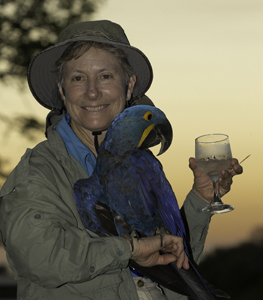
At 5:45 we returned to the lodge to a surprise Sundowner, Caparinis or soft drinks, and appetizers – a nice touch. Shortly afterward, Marcos and I hiked back into the jungle to turn on the flashes and cameras, and the day was complete.
August 31, 2015. South Wild
Several of us, Lori and Bob, and Mary and I, spent a bit of time in the Jabiru Stork tower where four one-third grown chicks attended by an adult. Except for some wing-stretching there was not too much activity, and the mate never flew in to join the group at the nest.
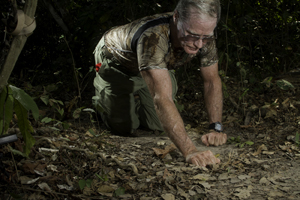
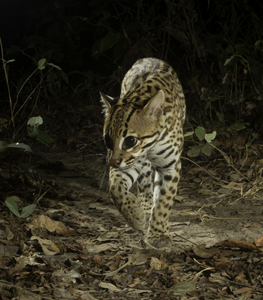
After I set up a RangeIR camera trap I crawl through it to make sure I have the framing, focus, and lighting correct, and perhaps framed so that even a Jaguar will fit in the frame. I positioned one flash closer to the tripping point, backlighted, to create a more three-dimensional scene. I cover ALL of this in our Advanced (Flash) course that we'll hold next summer.
I’d picked up the camera and flashes at first light, and was rewarded with about six shots of an Ocelot that passed by. Another photographer, who manned a baited station from a tower quite close by had stayed until 11PM and had nothing – so I was lucky!
After breakfast we did another run with the hawks and kingfishers, and had great luck with a Great Black Hawk, that came in for fish seven times! We had two very frustrating runs with Black-collared Hawks – one was a perfect opportunity, right at the camera, and my focus went right to the trees beyond – a complete miss! Ringed Kingfishers were cooperative, but only for a few passes.
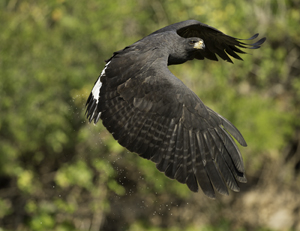
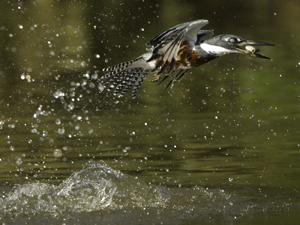
Great Black Hawk; Ringed Kingfisher
After the river birds we stopped at the lodge to gather our tripods and telephotos and headed, by boat, to a Great Potoo roost. I went on ahead with Marcos to make sure we were not repeating another stupid hike in the heat, and the bird was there, and in a perfect position. I set up a Pocket 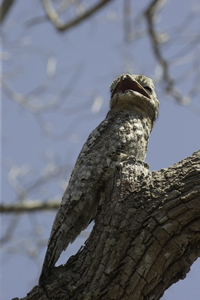 Wizard and returned to the boat to collect the group, then fired shots as we walked back, hoping to catch the Potoo with its eyes open. The bird was closer than I thought and some people were having trouble getting the entire bird in the frame with 500mm lenses, although Mary, using the exact same combination, had no trouble doing so. Amusingly, one person returned to the boat to collect a shorter lens, only to discover that he had the lens in his backpack the entire time – wearing the pack back and forth!
Wizard and returned to the boat to collect the group, then fired shots as we walked back, hoping to catch the Potoo with its eyes open. The bird was closer than I thought and some people were having trouble getting the entire bird in the frame with 500mm lenses, although Mary, using the exact same combination, had no trouble doing so. Amusingly, one person returned to the boat to collect a shorter lens, only to discover that he had the lens in his backpack the entire time – wearing the pack back and forth!
At 1:30 I headed back into the forest to set up the Range IR system again, and right at my setup a troop of Brown Capuchin Monkeys had gathered. They are fed, and these monkeys looked like they were about to mug me for some chow, so I power-walked the quarter mile back to the lodge, grabbed my tripod and lens and flash, and power-walked back. Since no one was about, and probably sleeping, I hadn’t bother raising an alarm, since nearly 15 minutes would pass before I’d be back. When I arrived the 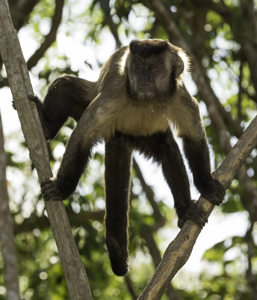 monkeys were gone, but I started shouting ‘Monkey! Monkey’ and the monkeys returned. I brought bananas and with much difficulty baited limbs and ran back to the camera to shoot, missing a lot of opportunities in doing so. The male was particularly bold, and I worried he might jump on me in his eagerness to grab a banana. He did not.
monkeys were gone, but I started shouting ‘Monkey! Monkey’ and the monkeys returned. I brought bananas and with much difficulty baited limbs and ran back to the camera to shoot, missing a lot of opportunities in doing so. The male was particularly bold, and I worried he might jump on me in his eagerness to grab a banana. He did not.
At 3:30 we headed far upriver, where Giant Otters are extremely tame, and in an area I’d not been to before, always stopping far short of this destination. En route we had the best Capped Heron photo opportunity I’ve ever had, and later an absolutely spectacular show with a pair of Giant Otters, that swam around our boat, extremely bold and very curious.
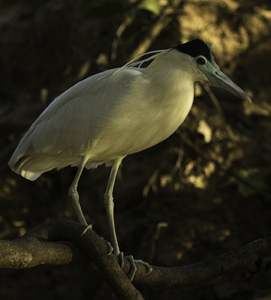
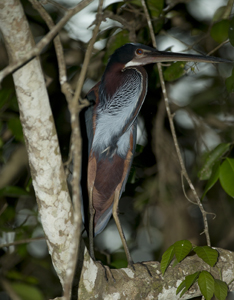
Capped Heron; Agami Heron
Below: Sungrebe
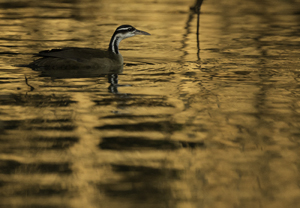
Afterwards, towards dusk, we headed back, and Marcos spotted a rare Agami Heron in a tree. It headed for deeper cover when we stopped, but Marcos’ and my boat circled around, and got shots. Marcos’s boat was in great position and Sue got some super shots, and I did well, too. Bob kept missing focus, and Laurie couldn’t see the bird – it is dark, and blended in, but was in clear view, so it was a frustrating time for her, and for Marcos who was using a laser pointer to try to position the bird for her.
It was dark by the time we returned and Mary, Marcos and I headed back into the jungle to set up the camera and RangeIR for another try.
September 1, 2015. South Wild to the Flotel
I left at 6AM with Marcos to retrieve my RangeIR setup, not wishing to leave the gear unattended for the six days we’d be at the Flotel and in Jaguar country. Once again, I had luck with an Ocelot (the same one?) passing by. The photographer in the scaffold, with a bait site illuminated by a bright focusing light, had nothing, and left his stake out at 11PM. I was asleep!
Toco Toucans and Tropials were around the various feeders at South Wild, so the bird shooters had some opportunities before breakfast. Afterwards we boarded our bus for an uneventful drive to Porto Joffre. En route, we met our two wonderful friends and puma guides from Chile, Rodrigo and Christina, and we had a few minute chat before continuing on.

By 11 we were on the river and headed upriver to the Flotel, but only five minutes out we found a mother Jaguar and her half-grown cub. She paused along the river bank and the cub was visible, setting a record for us for the shortest time in seeing a Jaguar. Two other boats came in, with one briefly cutting us off, but the driver was only trying to position his people and had to pass us in doing so. One of our participants growled a complaint, but Marcos asked me to tell everyone to keep their cool, so that guide fights wouldn’t start up. Guides are trying to cooperate with one another on an increasingly busy river.
PM. We left at 2PM and had a relatively uneventful afternoon. We were rather far up river when we received word that a Jaguar had been spotted on Picare River, up from our house boat. We raced to the location, and Marcos’s boat, with Sue and Tom, were already there, and had about five minutes of good Jaguar shooting. As we arrived, with several other boats, the Jaguar yawned and got up and walked into the brush. It moved downriver, and we followed, getting a few glimpses but no photos.
Afterwards, we backtracked and returned to the main channel, getting as far as the Caiman Island before turning back for home. It was a slow afternoon.
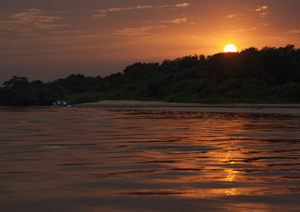 September 2, 2015. Jaguar Land
September 2, 2015. Jaguar Land
We left at 5:55AM and had the river to ourselves for nearly two hours. A family of Giant Otters had gathered at a log by their den, but the light was too low for shooting and the otters swam off. We didn’t bother following. Instead, we moved up the main channel to a wonderful side channel with low water, where we tried to photograph Spectacled Caiman doing the ‘Bubble Dance’ where males vibrate their chest cavity and create a 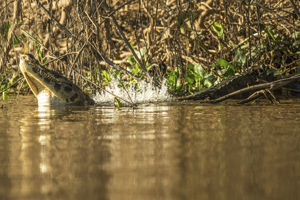 cascade or fountain of water above their back. One of our Caimans did so, but its back was so low in the water that the water itself only looked disturbed, and no spray rose above the surface. Mary, on the Black Lagoon, had one very cooperative Caiman and did get the dance, and later also had great shots of a Caiman eating an armoured catfish.
cascade or fountain of water above their back. One of our Caimans did so, but its back was so low in the water that the water itself only looked disturbed, and no spray rose above the surface. Mary, on the Black Lagoon, had one very cooperative Caiman and did get the dance, and later also had great shots of a Caiman eating an armoured catfish.
Marcos’s boat had a good Crane Hawk, the African Gymnogene ecological equivalent, and we had a very cooperative family of Capybara feeding upon water hyacinths. A female Green Tree Iguana was either laying eggs, or having already done so, filling in the nest hole, and her work was visible, and obvious, from over a hundred yards away, a pyramid of darker sand whose apex led directly to the hole. We passed the area about two hours later and the disturbed sand that had been scooped out was still visible as a darker shade, but the female had filled in the hole with dry sand that came from around or above the nest hole.
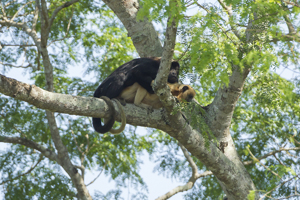 Mary also had a pair of Howler Monkeys in good view that were mating, a process she said went on for several minutes. My boat had a very good Southern Screamer, a huge turkey-like bird distinguished by a pair of sharp, bony spurs that project from the wing joint. As a defensive weapon, especially if the bird flew past and clipped an intruder with the wing, the spurs would be formidable.
Mary also had a pair of Howler Monkeys in good view that were mating, a process she said went on for several minutes. My boat had a very good Southern Screamer, a huge turkey-like bird distinguished by a pair of sharp, bony spurs that project from the wing joint. As a defensive weapon, especially if the bird flew past and clipped an intruder with the wing, the spurs would be formidable.
We returned to the boat by 11:40, for a quick lunch before a 2PM departure.
PM. We left at 1:50 in very hot conditions and headed upriver. We were exploring the Black Lagoon when we received a call that a Jaguar had been sighted on the Cuiaba River, and we headed there, fast. When we arrived the cat was lying in the open, mostly sleeping but occasionally lifting its head, but several boats were converging and we were jockeying for position, with me dropping anchor or tying off to another boat – net result, I didn’t get any shots. The cat, meanwhile, got up and stepped out of view, where it resettled. Laurie and Bob got some shots, but it was bouncy and the window was narrow, so it was a frustrating several minutes.
We waited, in the sun and the heat, and sweated. Finally, around 4:45, we decided to look downriver for the mother and cub we’d seen yesterday. All of our boats headed downstream, but saw no Jaguars. My boat turned back first, while Mary’s and Tom’s boat stopped for some Capybaras on the beach. I had just decided to continue on, if the Jaguar wasn’t visible, since we’d have good light if we would find something. Luckily, we didn’t follow through I my decision, as the Jaguar had just awoke and had begun walking downriver as we reached her area. For the next thirty minutes or so we 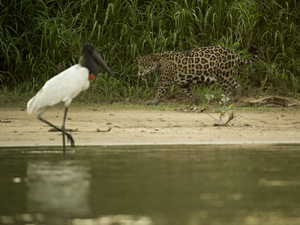 followed her downriver, as she hunted the shoreline, swam, struggled through thick tangles of floating hyacinths, and finally walked the beach. The shooting views were excellent, but with as many as 15 boats often powering past those boats already in position, there were frequent wakes, and some of the best shots or positions, especially as she walked down the beach, were missed because of all the bounce. Still, I shot around 600 frames, and Bill said he shot over 1,200, so there HAS to be a lot of good ones in the bunch. We were shooting into the sun-side, in deep shade, so ISOs ranged from 1000 to 3200, at shutter speeds around 1/500th at times.
followed her downriver, as she hunted the shoreline, swam, struggled through thick tangles of floating hyacinths, and finally walked the beach. The shooting views were excellent, but with as many as 15 boats often powering past those boats already in position, there were frequent wakes, and some of the best shots or positions, especially as she walked down the beach, were missed because of all the bounce. Still, I shot around 600 frames, and Bill said he shot over 1,200, so there HAS to be a lot of good ones in the bunch. We were shooting into the sun-side, in deep shade, so ISOs ranged from 1000 to 3200, at shutter speeds around 1/500th at times.
It ended up to be a very great day!
A Bird Portfolio
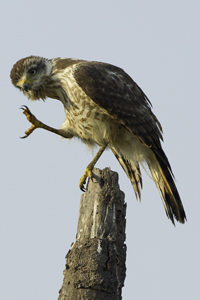
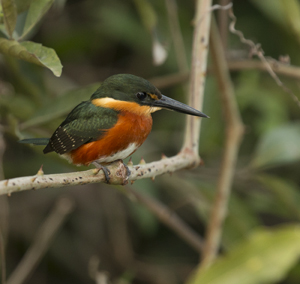
Roadside Hawk; American Pigmy Kingfisher
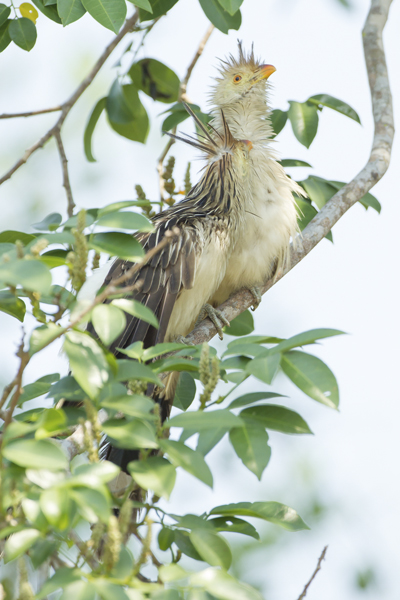
Guira Cuckoo
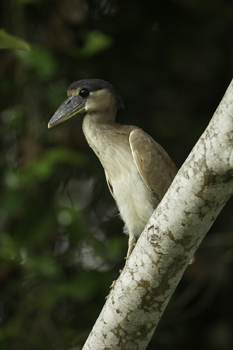
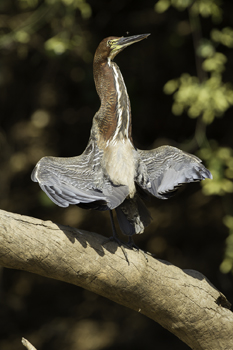
Boat-billed Heron; Rufescent Tiger-Heron
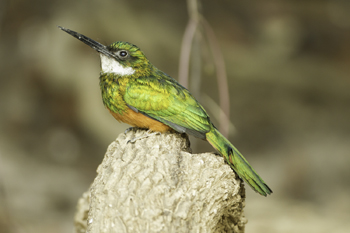
Rufous-tailed Jacamar
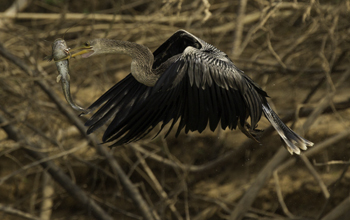
Anhinga with Catfish
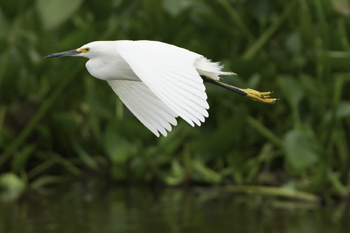
Snowy Egret
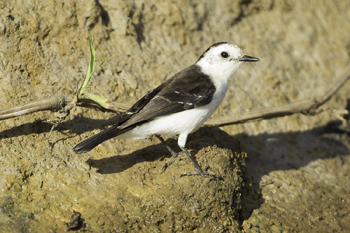
Black-backed Water Tyrant
September 3, 2015. Jaguar Land
We left at 6, with Mary, Laurie, and Bob going up the Black Lagoon, while Tom, Bill, and I went up the main channel and to the Charles Creek, where we hoped to find Caimans doing the bubble dance. Caimans were quite inactive, and the shooting was rather slow. Meanwhile, Mary’s boatman pushed through the vegetation-choked narrows and went far up the lagoon, to areas where we reached last year with high water. They did well with birds.
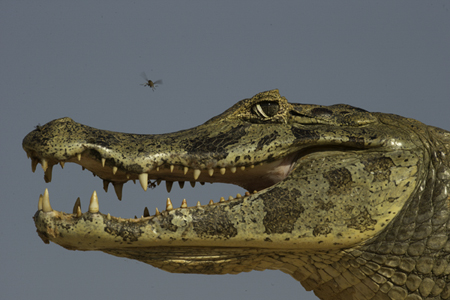
At 7:30 they were returning into the main lagoon and found several boats already gathered as McJaguar, a dominant and famous male, was spotted. Meanwhile, we were at Caiman Island, photographing Caimans basking, with one framed against a blue sky. We got the call while there and hurried to the lagoon, where we joined in a rather orderly cluster of boats that followed the Jaguar down river.
McJaguar was hunting, walking the shoreline and going into the water, stomping through hyacinth clusters and grasses, or moving so silently through both that we could barely see its progress via moving vegetation. At 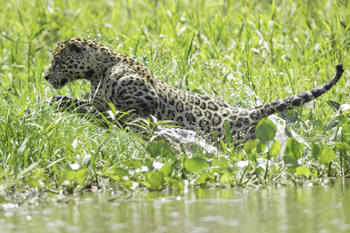 one point the Jaguar charged ahead, then leaped, but missed whatever he was after. I also completely missed the shot, with the wrong exposure (I was resetting at the time), wrong framing, and wrong focus! Mary got two of the three peak action shots, only missing the last.
one point the Jaguar charged ahead, then leaped, but missed whatever he was after. I also completely missed the shot, with the wrong exposure (I was resetting at the time), wrong framing, and wrong focus! Mary got two of the three peak action shots, only missing the last.
At one point, as McJaguar moved through the aquatic vegetation he must have disturbed something, for he lunged and dove beneath the water but came up empty. That was a great observation, however, as it showed how the Jaguars work almost like Raccoons, sometimes feeling prey with their feet and then responding. That cat dove underwater and stayed down for a few seconds – it was trying to snatch something, and we were sure it had been successful, but it wasn’t.
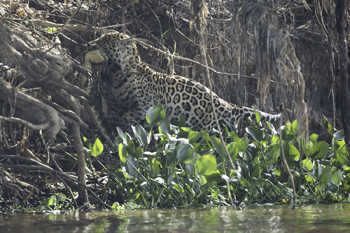
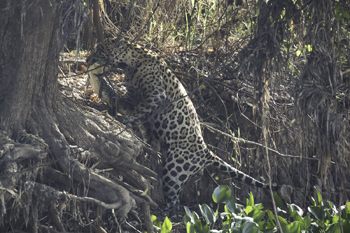
At one point mid-morning McJaguar did capture a three foot long Caiman, although all most of us could see was splashing water. Mary’s boat was in a good position for when the cat left the water, and she nailed several shots of the Jaguar carrying the Caiman ashore. Oddly, instead of retreating for the usual hundred yards or so away from the water, the cat simply went to the nearest trees and ate the caiman there.
We waited, hoping that the Jaguar would come to the water to drink, and eventually it did. After it returned, another, larger Caiman swam towards the shore, and the Jaguar, although just having completed one meal, went into an active stalk. It paused at the water’s edge about 10 yards or so from
the Caiman, which was facing away, and just waited. Unfortunately the cat’s tail twitched constantly, and I think that’s what alerted the Caiman, that dashed away with a big splash.
We waited, and as it was approaching lunch time we were thinking of moving, since the cat looked fairly settled. But we lingered, and just as we decided to go, and had begun to pull out to start motoring, McJaguar got up and started hunting down the river. That’s when we had the near kills described above!
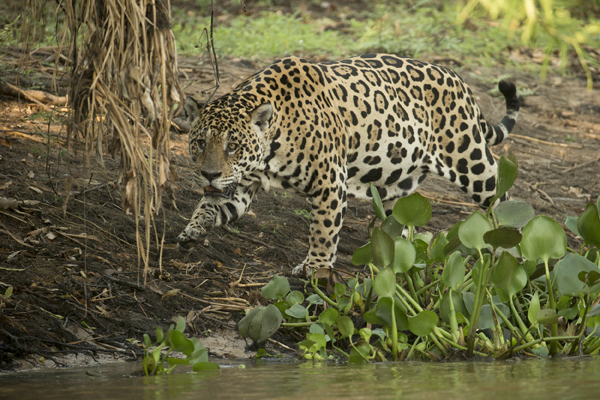
We followed the cat for at least a half hour, with only our boats, and one other with just one passenger aboard, and obtained great shots. As the cat neared the end of the lagoon it moved off into the interior, and we suspected it might hunt the Three Brothers river, which has a stronger current. We headed to lunch.
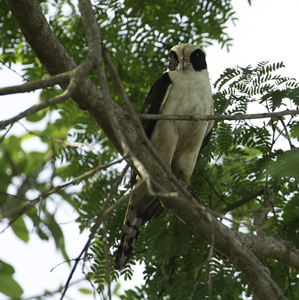 PM. We headed up the Three Brothers, Charles Creek, and the branch that divides Peter’s Island, but the afternoon was fairly slow. I had a reasonable Laughing Falcon, and later, in the same area, Mary had a group of Howler Monkeys come to the river to drink. Although we covered some great jaguar country, and we were the only boats on this stretch of river, nothing of note materialized, making this a pleasant but slow afternoon.
PM. We headed up the Three Brothers, Charles Creek, and the branch that divides Peter’s Island, but the afternoon was fairly slow. I had a reasonable Laughing Falcon, and later, in the same area, Mary had a group of Howler Monkeys come to the river to drink. Although we covered some great jaguar country, and we were the only boats on this stretch of river, nothing of note materialized, making this a pleasant but slow afternoon.
September 4, 2015. Jaguar Land to the Fish Camp
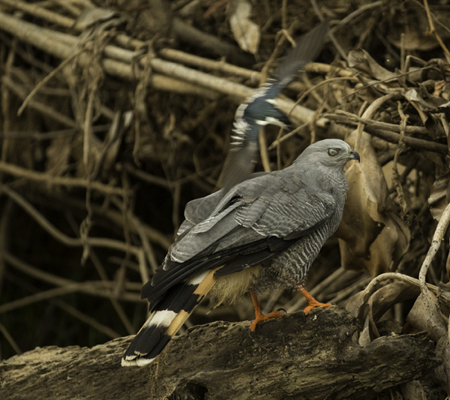
Crane Hawk, harassed by a swallow.
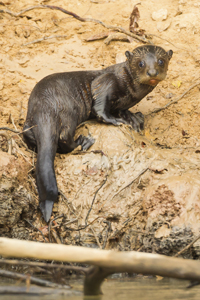 We left at 6 for an excursion up the Picare River to a remote fish camp where Yellow Armadillo are frequently seen, and Hyacinth Macaws are abundant. Our journey upriver , a trip that takes about 50 minutes in a direct ride, took over three hours, as we had a den of Giant Otters (I missed these, tied up with a Rufous and Green Kingfisher, but the other boats had great shooting), a Crane Hawk that was bombarded by White-rumped Swallows as the Hawk foraged along a pile of tree trunks wedged into a river bank, a Pied Plover, and the Kingfisher. The Otter family really performed, occasionally playing with a one-third grown baby, and scent marking and rolling at the top of the river bank.
We left at 6 for an excursion up the Picare River to a remote fish camp where Yellow Armadillo are frequently seen, and Hyacinth Macaws are abundant. Our journey upriver , a trip that takes about 50 minutes in a direct ride, took over three hours, as we had a den of Giant Otters (I missed these, tied up with a Rufous and Green Kingfisher, but the other boats had great shooting), a Crane Hawk that was bombarded by White-rumped Swallows as the Hawk foraged along a pile of tree trunks wedged into a river bank, a Pied Plover, and the Kingfisher. The Otter family really performed, occasionally playing with a one-third grown baby, and scent marking and rolling at the top of the river bank.
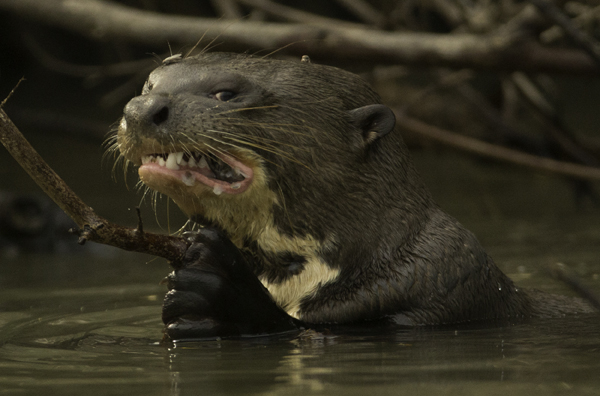
Giant Otter feeding on a fish
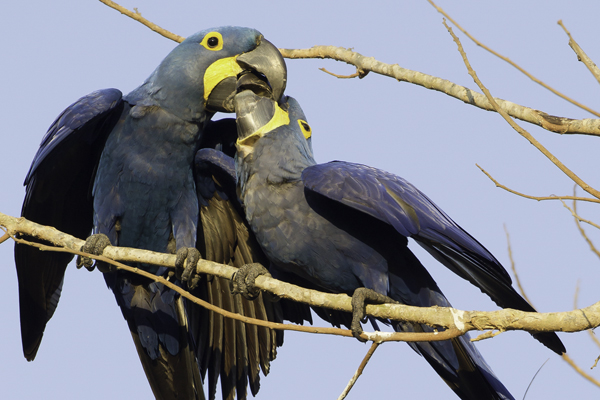
Romantic Hyacinth Macaws
At the Fish Camp we did very well with Hyacinth Macaws, including a pair that Mary photographed mating. Unlike the usual and quick cloacal kiss, these birds stayed together for a short time, and actually ended up facing away from each other, reminiscent of the ‘tie’ of mating dogs. Shortly after coming ashore we had a great shooting opportunity with Yellow-rumped 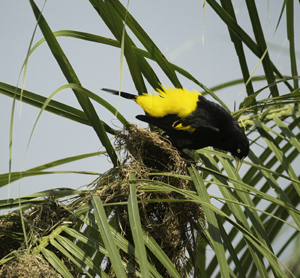 Casiques, oriole-like birds that build a nest somewhat between a weaver’s and an oropendola’s. Males were coming and going with nesting material and, I suspect, after securing a female probably leaving the raising of the young to the female alone – but I am not sure of this!
Casiques, oriole-like birds that build a nest somewhat between a weaver’s and an oropendola’s. Males were coming and going with nesting material and, I suspect, after securing a female probably leaving the raising of the young to the female alone – but I am not sure of this!
PM. To avoid the heat we left at 2:30, with my boat first exploring the Black Lagoon, which offered nothing to shoot. We headed up the Three Brothers River, finally reaching the now vegetation-choked San Pedro, where two Jaguars had been seen mating today, but far off. We continued on, then had a radio call that a Jaguar had been sighted about a half mile downriver from Caiman Island. We arrived, but saw nothing.
After about an hour’s wait we headed up to Caiman Island, searching the 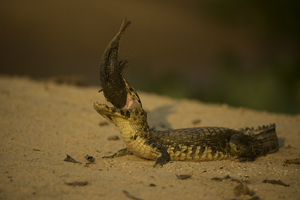 river bank in case the Jaguar had moved up river. At one point we pulled into the beach, and as we did so I spotted a two foot long Caiman in the process of trying to swallow a six inch long Armored Catfish. We were on the wrong side of the light so after a few insurance shots we moved to the sunny side, where we waited for the Caiman to relax and to try to swallow this disproportionately huge meal. It tried several times, juggling the fish into various positions, which I thought would attract the attention of a nearby Tiger Heron, that might steal it. Oddly, the Heron ignored the activity.
river bank in case the Jaguar had moved up river. At one point we pulled into the beach, and as we did so I spotted a two foot long Caiman in the process of trying to swallow a six inch long Armored Catfish. We were on the wrong side of the light so after a few insurance shots we moved to the sunny side, where we waited for the Caiman to relax and to try to swallow this disproportionately huge meal. It tried several times, juggling the fish into various positions, which I thought would attract the attention of a nearby Tiger Heron, that might steal it. Oddly, the Heron ignored the activity.
A Southern Crested Caracara did see the action and flew in, and circled the Caiman. I thought it would be more aggressive but it kept its distance. A Black Vulture flew in next, perched somewhat close to the Caracara. Another Caracara flew in, and knocked the Black Vulture over, into a real tumble, as it flew over. Now, with two Caracaras around the Caiman I figured it would lose the fish. It did not, and eventually both Caracaras flew off.
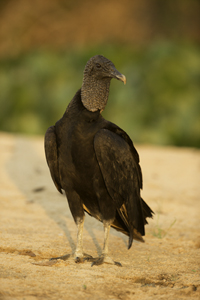 The Black Vulture approached, and the annoyed hissing that I thought was from the Caiman was, I discovered, from the Vulture! Later, the same bird gave low, somewhat quiet dog-like barks, a quite surprising sound. The Vulture spread its wings and advanced, then hopped into the air – perhaps because of our camera clicks, while the Caiman trotted across the sand with the fish still clasped in its jaws.
The Black Vulture approached, and the annoyed hissing that I thought was from the Caiman was, I discovered, from the Vulture! Later, the same bird gave low, somewhat quiet dog-like barks, a quite surprising sound. The Vulture spread its wings and advanced, then hopped into the air – perhaps because of our camera clicks, while the Caiman trotted across the sand with the fish still clasped in its jaws.
The Vulture was so close that my shadow covered the bird, so I got out of the boat to shoot, while the Caiman continued walking away. With the shooting over I peed, and as I returned to the boat spotted a FRESH Jaguar track right at the wet sand line, so fresh that the rough crusty edges were sharp, and raised, as if the cat had been in a hurry. Considering how many boats pass by, creating big wakes that roll waves on to the beach, this track had to be only minutes old. As I was standing, peeing, I had heard leaves and branches cracking, and I figured it was a bird or capybara, but who knows? It may have been within yards of me. Earlier, just ten minutes or less, Mary had passed by the same spot, and cruised inside the bay looking for cats, and other photo boats had passed as well, so it had to have happened almost right before we arrived. Pretty exciting, for 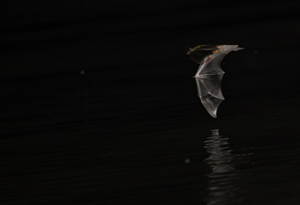 a close call on what would have been a fantastic sighting, in great light and in the open. We cruised the bay as well, then slowly moved downstream, but had nothing.
a close call on what would have been a fantastic sighting, in great light and in the open. We cruised the bay as well, then slowly moved downstream, but had nothing.
On the way back I played ‘bat baseball,’ trying to catch a Fishing Bat with the flash in the dim light. I did manage one good one, although the wing blocked the bat’s head.
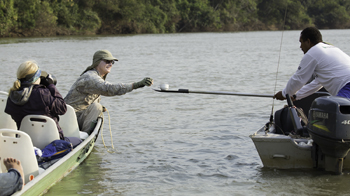
A desperate, coffee-craving Joe being served,
via a paddle from Marcos's skiff!
September 5, 2015. Jaguar Land
Hoping to get more shots of the baby Giant Otter and den activity, we headed up the Picare River once again, leaving at 6. En route, Marcos’s boat had a Tapir that appeared about to cross the river, but headed back into the forest when it heard the boats. We reached the den site just as the sun clearing the low clouds hugging the eastern horizon, but the Otter den was 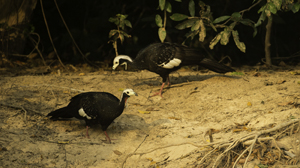 quite. Chachalacas and Piping Guans picked at bugs or otter droppings at the toilet site, and two Otters swam down river, climbing the bank and smelling leaves, but not scent marking before they left. Marcos thought they were not a part of the family group, or if they were, they had abandoned the site, and hence no scent marking. We stayed about an hour without activity, then headed back towards the Three Brothers.
quite. Chachalacas and Piping Guans picked at bugs or otter droppings at the toilet site, and two Otters swam down river, climbing the bank and smelling leaves, but not scent marking before they left. Marcos thought they were not a part of the family group, or if they were, they had abandoned the site, and hence no scent marking. We stayed about an hour without activity, then headed back towards the Three Brothers.
We stopped to look for the Green and Rufous Kingfisher, where Laurie and Bob had some luck with Boat-billed Herons, and Bob saw a Black Vulture riding the back of a Capybara, apparently picking ticks from its fur. He said the Capybara arched its neck as if in ecstasy. I looked for the Kingfisher with Bill and Sue but the bird was gone, but a Green Kingfisher was in the open and we did some portraits, continuing on to try to shoot a Sunbittern that 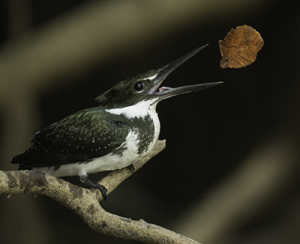 proved to be shy. Turning back, we had another Kingfisher that was very tame and we watched, from only a short distance away, as the bird repeatedly dove into the water, returning with twigs or leaves which it would juggle in its beak or beat against its perch, as it would to stun a fish. Another one joined it and did the same, and I believe we were watching two fledglings that were practicing and learning how to fish for themselves. It was a really instructive moment for me, as I’d never seen birds practice before, and certainly fun to watch.
proved to be shy. Turning back, we had another Kingfisher that was very tame and we watched, from only a short distance away, as the bird repeatedly dove into the water, returning with twigs or leaves which it would juggle in its beak or beat against its perch, as it would to stun a fish. Another one joined it and did the same, and I believe we were watching two fledglings that were practicing and learning how to fish for themselves. It was a really instructive moment for me, as I’d never seen birds practice before, and certainly fun to watch.
We continued on, and our boatman, Jaguar John, completely amazed us as we were traveling at a normal cruising speed when he suddenly slowed down and did a U-turn, saying he spotted a Snake. I assumed he’d seen an anaconda on the bank, and so as we motored back and close to the river bank I searched the tree roots for a large snake, and saw nothing. Finally, 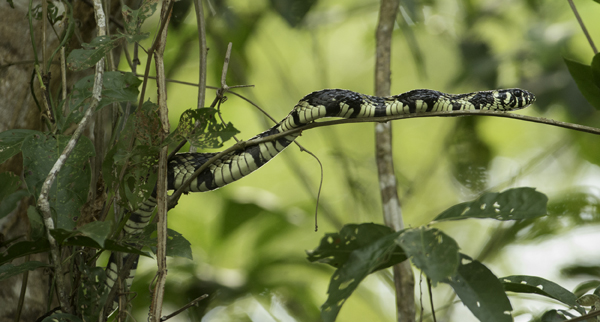
Tiger Rat Snake
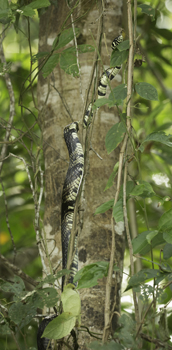 John made it clear to me to look higher up, where I spotted a small section of black, that could have been an old hose washed ashore. That was the snake, and how he saw it was simply incredible. The snake climbed a lliana and eventually gave us a good view, showing its ventral surface, banded yellow, and the back end, all black. The snake was a Tiger Rat Snake, a nonvenomous species that is quite colorful and quite laterally compressed.
John made it clear to me to look higher up, where I spotted a small section of black, that could have been an old hose washed ashore. That was the snake, and how he saw it was simply incredible. The snake climbed a lliana and eventually gave us a good view, showing its ventral surface, banded yellow, and the back end, all black. The snake was a Tiger Rat Snake, a nonvenomous species that is quite colorful and quite laterally compressed.
We continued, stopping at a sand bank where Giant Otters were playing, but most ran into the tall grasses and we had word that two Jaguars had been spotted. Marcos had found McJaguar and another, Maximus, that may have been fighting, perhaps over a third? cat, a female perhaps. McJ was actually running away, with the other cat lopng, head held high, in pursuit, which surprised Marcos. When the pursuit ended McJ went through a rather lengthy scent-marking ritual, rubbing grasses and leaves and rolling around in the vegetation.
The cats had crossed over to the Charles Creek area, and Marcos’s boat headed there, where they found the two cats – one on either side of the very narrow stream. He said that was a tense moment because he wasn’t sure if they’d fight.
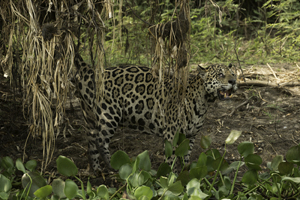 We arrived soon afterwards, one of the last of perhaps 20 boats to arrive, and the cats had disappeared, but soon afterwards McJ showed, walking down the riverbank towards us. The cat passed by close, swam in the hyacinths, and continued on, eventually walking over a sandy beach that I’ve always thought would be the perfect place to shoot a Jaguar. Unfortunately, we were not on the front end of the line of boats, and all I shot was the back end of the cat as it walked over the beach.
We arrived soon afterwards, one of the last of perhaps 20 boats to arrive, and the cats had disappeared, but soon afterwards McJ showed, walking down the riverbank towards us. The cat passed by close, swam in the hyacinths, and continued on, eventually walking over a sandy beach that I’ve always thought would be the perfect place to shoot a Jaguar. Unfortunately, we were not on the front end of the line of boats, and all I shot was the back end of the cat as it walked over the beach.
Soon afterwards the cat was again in hyacinths, made a leap, and captured another Caiman. Bill, in my boat, got a shot of the cat carrying its prey, but I missed it. McJ disappeared in the brush and we headed to the main river, where we were marveling at our morning when my boatman and Mary’s simultaneously spotted another Jaguar, Maximus, laying in the open right beside us! What followed was a massive boat jam as boats jockeyed in position for a shot of the cat lying in the shade. I had my neck stabbed by the pointed end of a boat that rammed us, and felt lucky I didn’t get my teeth knocked out when the boat hit us. We got our shots – one of the better positions, and moved off for others to get in, and motored over to a shady spot where we could watch the cat.
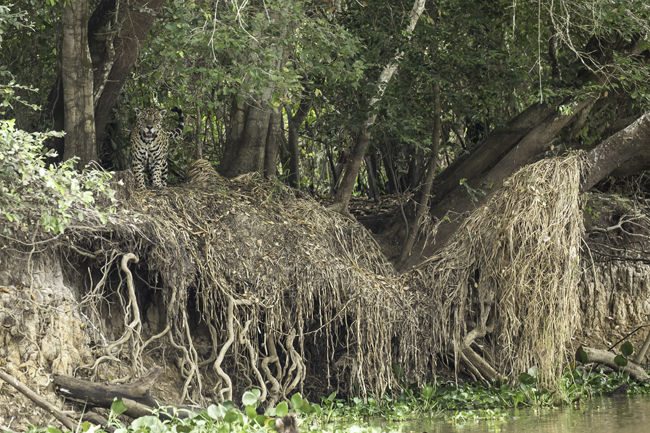
After all the ruckus, things settled down and eventually we did several more passes of the Jaguar, without a motor or the wake of any other boats. Oddly, only our boats did this, the rest just stayed tied on to shore. We were hoping that McJ might finish his caiman and show himself again, but Mary’s boat had left, and had encountered the Giant Otters we had earlier, reporting they were great.
We left, and arrived for about two minutes of very rewarding shooting as two Otters kicked up sand and three or four groomed along the shoreline, before finally slipping into the river and swimming off. We headed to lunch.
PM. We left at 2:30, heading up the Three Brothers River, passing where earlier we had McJaguar and the other male, named Adriano. After we left, we were told that Adriano swam back across the river and stole the Caiman kill from McJaguar. Obviously, McJaguar is no longer the top cat on this section of the rivers!
 At Caiman Island, where yesterday I’d seen the fresh Jaguar track, we were told that a cat was lying on the opposite side of the sand bank. Marcos went through the channel to check, and while he was doing that I spotted the Jaguar on the far end of the bay. We headed inside, and positioned ourselves to be in line when the cat, a female named Patricia, passed by. She did, and we got nice shots, and then she disappeared.
At Caiman Island, where yesterday I’d seen the fresh Jaguar track, we were told that a cat was lying on the opposite side of the sand bank. Marcos went through the channel to check, and while he was doing that I spotted the Jaguar on the far end of the bay. We headed inside, and positioned ourselves to be in line when the cat, a female named Patricia, passed by. She did, and we got nice shots, and then she disappeared.
We moved back to the main channel when another guide that we once had told us that another Jaguar, a male, Romero(?) was upriver. When we arrived there was a cluster of at least 15 boats, all watching a cat that was either sitting Sphinx-like or sleeping. We took a few shots, waited, and then I had my boatman turn back to see if Patricia had reappeared. John, our boatman, spotted her, and we got a great shot when she went to the river’s edge and looked back to us, then climbed the bank and disappeared again.
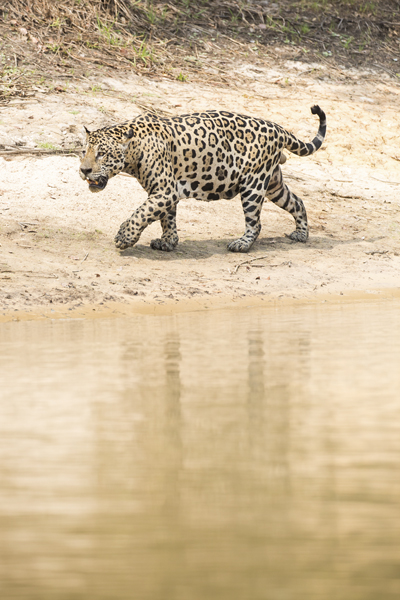 We moved up river, to find that the male Jaguar had begun walking, and for the next hour or more we followed the cat downriver. Several times he entered the water to escape the biting flies, which were obviously tormenting the cat, making him snap at the air, shake his head, and sometimes even run to try to escape. At one point we were lined up for a wonderful water-level shot of the Jaguar swimming towards us, but other boats, zipping by too fast, created such a wake that we were tossed about, and getting a shot was impossible. Frustrating!
We moved up river, to find that the male Jaguar had begun walking, and for the next hour or more we followed the cat downriver. Several times he entered the water to escape the biting flies, which were obviously tormenting the cat, making him snap at the air, shake his head, and sometimes even run to try to escape. At one point we were lined up for a wonderful water-level shot of the Jaguar swimming towards us, but other boats, zipping by too fast, created such a wake that we were tossed about, and getting a shot was impossible. Frustrating!
Eventually the Jaguar disappeared into the interior, and we spent the last light of the day chatting, and drinking some beers as a Sundowner to celebrate a great day.
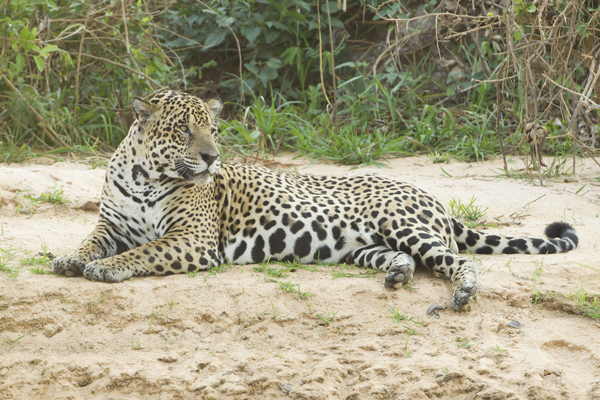
September 6, 2015. Jaguar Land
We left at 6 for a very long excursion, up the Three Brothers until we met the Cuiaba River, then down a different branch of the Brothers to rejoin the main river. We were hoping to encounter some new Jaguars and few people, and we succeeded only in the latter.
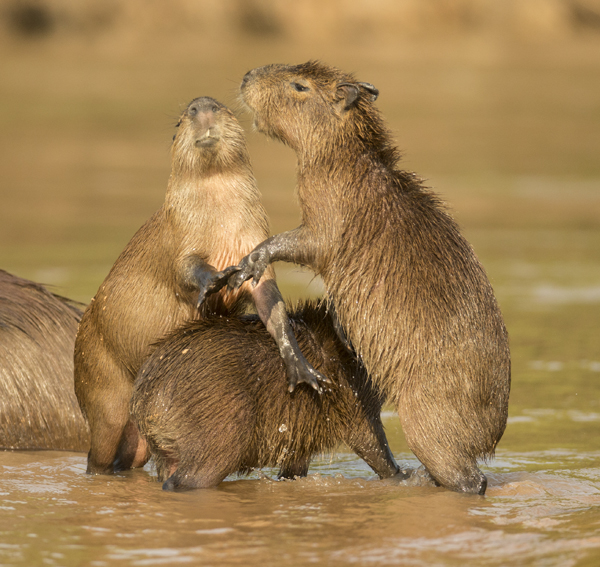
Along the way, however, we did find the youngest, largest family of Capybara I’ve seen on the river this year. When we first spotted the family two young ones were on their hind legs boxing, and backlighted by the sun, it was a striking scene, but not a shot, as other Capybaras were in front. We circled around, and for the next hour stayed with these huge rodents, and one time, early on, two climbed onto the back of a third youngster and began to box, but the action lasted just seconds. A Choppi Blackbird flew down and hunted insects off the backs of several Capybaras, and apparently pulled a tick off one, leaving a large red spot on the hide – open flesh, but the Capybara never flinched. With a harem Male on one end, and another adult at the other end of the group, this family group was well-guarded, which might account for the six babies that were still surviving. At one point, all of the young nursed from one female, making we wonder if they communally suckle. Several were chewing, too, as if chewing a cud, a behavior I’ve seen before but haven’t verified.
We did the circuit, having nothing until heading back when we were told Adriano, the Jaguar, had been spotted again. Two of our boats missed it, but Sue and Bill, with Marcos, got some nice shots of the Jaguar lying out on the beach. They also had a brief but productive encounter with a Giant Otter feeding upon a large catfish.
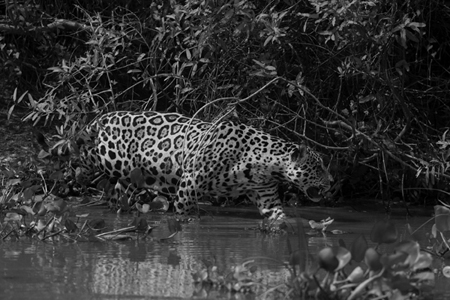
While we waited we received word of another Jaguar on the Cuiaba River, and we headed there, where we spent the remainder of the morning as we followed the cat upriver, where it gave us several short shooting opportunities in clearings, before the cat moved into the Black Lagoon and the thick water vegetation that blocked any further viewing. We headed to lunch.
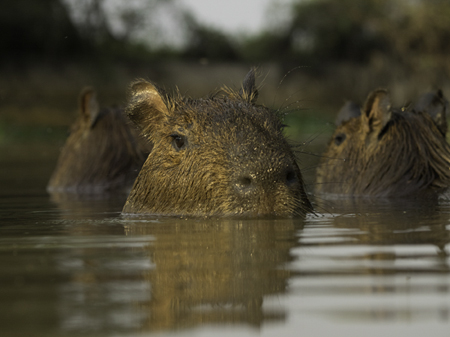
PM. We left at 2:30, heading up the Three Brothers and Charles Creek, where we photographed Rufous-tailed Jacamars. Afterwards, we had a radio call that Adriano, the male Jaguar, was spotted again, and we headed back onto the Three Brothers, following the cat as it moved to the very end of the peninsula. The shooting was marginal, but it was still fun to get still another jaguar.On the way back we tried photographing bats, unsuccessfully, but a Great Potoo flew by and I managed a poorly focused shot.
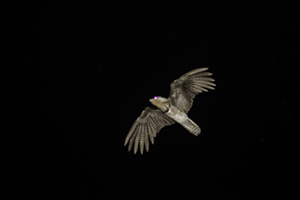
September 7, 2015. Jaguar Land to South Wild.
We left at 6 and headed to the Black Lagoon, where we hoped to photograph Caiman doing the Bubble Dance. After several near misses we finally had one male in a good position and with a good bubble dance. This is generated, somehow, by vibrations in the body cavity of the Caiman, 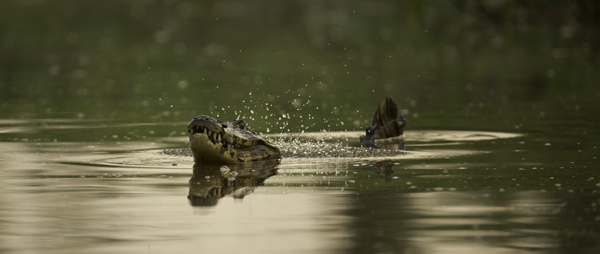
creating a thrumming roar that you can practically feel, both through the boat and in the air, and a second or two later, the bubbles begin. Actually, it is water droplets springing in the air, like a great fountain, and backlighted, with the head and tail of the Caiman arched, it is a supple and beautiful image.
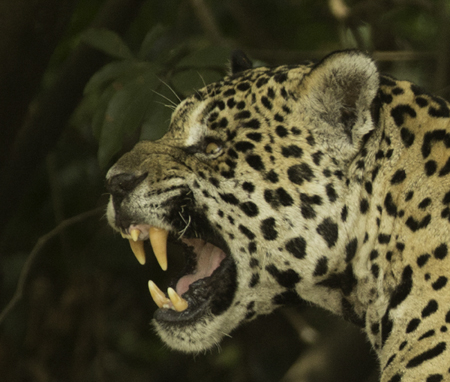
We continued up the Lagoon, but were soon called back as a Jaguar was spotted on the Charles Creek. When we arrived at least 15 boats were in the narrow channel, but we positioned ourselves, and then waited, when the Jaguar disappeared. All of the boats left – another Jaguar was spotted on the main channel, but we remained behind, and as other boats started to return the Jaguar, McJaguar, appeared, and walked along the opening. Later the cat rested on a river bank, with 20 or 25 boats jammed along the river, and 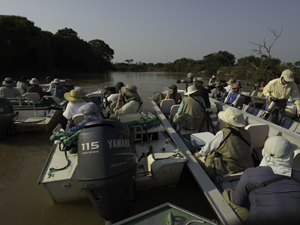 after the cat moved on, we left, heading back to the lagoon for more caiman shots – which eluded us. Mary stayed on, for a bit, and reported that it became obscene, with two boats trailing the Jaguar, and their boatman actually videoing with a cell phone, and dogging the jaguar, while also getting into everyone else’s way. A Japanese film crew followed, compounding the offense, and with that Mary and our other boat headed out and returned to the Flotel. Meanwhile, my boat went far up the lagoon, but nothing materialized, and we arrived back at the Flotel late, with nothing to show for it.
after the cat moved on, we left, heading back to the lagoon for more caiman shots – which eluded us. Mary stayed on, for a bit, and reported that it became obscene, with two boats trailing the Jaguar, and their boatman actually videoing with a cell phone, and dogging the jaguar, while also getting into everyone else’s way. A Japanese film crew followed, compounding the offense, and with that Mary and our other boat headed out and returned to the Flotel. Meanwhile, my boat went far up the lagoon, but nothing materialized, and we arrived back at the Flotel late, with nothing to show for it.
After a slide show of our work, for our boatmen, we headed to Porto Joffre 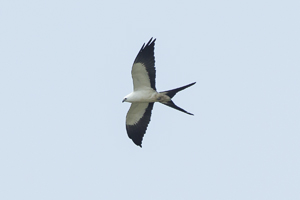 and our ride to South Wild, Santa Tereza, where we had a relaxing afternoon and a sundowner in celebration of Tom’s birthday. Along the way we had two Swallow-tailed Kites, one swooping down to the river in front of us. Mary got her 500mm up in time and got a nice shot of this bird, the only time we saw one on the trip!
and our ride to South Wild, Santa Tereza, where we had a relaxing afternoon and a sundowner in celebration of Tom’s birthday. Along the way we had two Swallow-tailed Kites, one swooping down to the river in front of us. Mary got her 500mm up in time and got a nice shot of this bird, the only time we saw one on the trip!
Marcos and I headed into the forest so that I could set up the RangeIR setup, enduring some mosquitos, and returned just before dark.
September 8, 2015. South Wild
At 6 I headed out into the forest with Mary to check the Range IR camera trap, and was disappointed to find only one shot of the back end of an Ocelot. I had brought along bananas, and extra batteries, as I planned to run the camera through the morning in case Currasows or deer moved through. At 8 we did another boat ride for kingfishers and hawks, but strangely we did not find a single cooperative kingfisher.
We did do quite well with Great Black Hawks, and two or three passes with Black-collared Hawks, none of the latter actually dropping down to grab a fish. A weird, hot wind blew throughout the morning, and by 11 we headed back to the lodge. I grabbed a GoPro and Marcos and I did a little experimenting, baiting Piranhas in a shallow bay with sausages. Unfortunately the water was so incredibly murky that fish were visible as mere flashes, and only within two inches or so of the camera. Later, I checked another video I had made at Caiman Island, where I brought a GoPro underwater right up to a Caiman, and I was within inches – and nothing but brown, murky water showed in the video. Afterwards, I immediately headed out to check the RangeIR camera trap, and found to 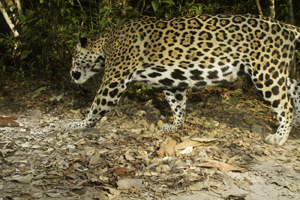 my surprise that, in addition to the Black and White Tegus, the Purplish Jays, and the White-tipped Doves, a female Jaguar walked by! The cat passed somewhere between when I changed the batteries and camera and a group of bird-watchers walked by, at 7:30AM. That was exciting!
my surprise that, in addition to the Black and White Tegus, the Purplish Jays, and the White-tipped Doves, a female Jaguar walked by! The cat passed somewhere between when I changed the batteries and camera and a group of bird-watchers walked by, at 7:30AM. That was exciting!
PM. After lunch I headed back into the forest to try one final camera trap, this time setting up the system by an inclined log. With this elevated set I had to improvise, and when Marcos later saw it he said ‘McGyver,’ after the TV character that improvised whatever, as I had long limbs lashed together as make-shift tripod lightstands, a boom to support the Range IR, and flashes rigges about.
Caimans and Jaguar Portfolio
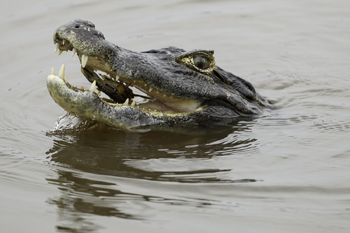
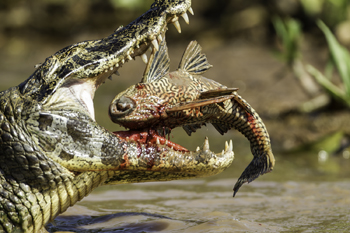
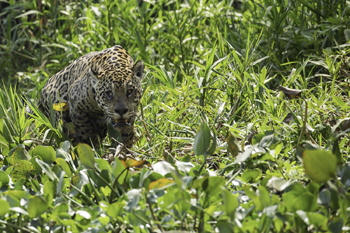
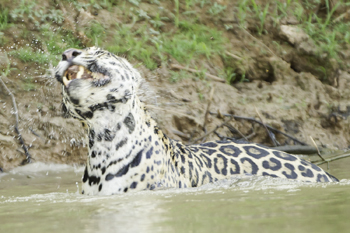
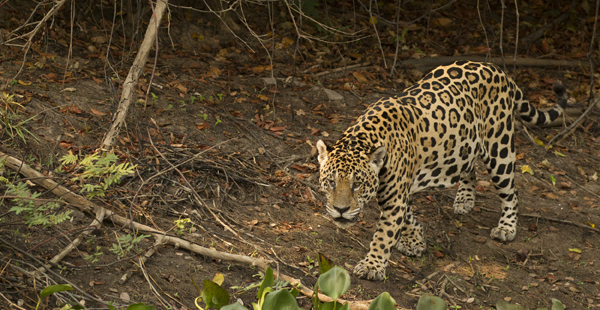
At 3:30 we headed upriver where we hoped to find the very tame and cooperative Giant Otters, but they had vanished. To the south and west black clouds loomed and threatened storms, and the light level soon fell dramatically. At 4:45 we called it quits and headed back to the lodge, giving people some extra time to get their final images to us for a group slide show. I headed out to the forest to turn on the flashes, and to water-proof the gear in case the storm came in our direction.
While I was gone, a massive windstorm blew into the lodge, and Laurie, out in a field, was enveloped with dust and had a hard time working against the wind to return. Mary was outside, trying to get her help, and the window shutters of our room blew off from the winds. Meanwhile, except for a dust devil near my setup, and some scattered drops of rain, the weather was calm.
While we had dinner, after our Participants Portfolio slide show, the storm did hit us, blowing rain nearly horizontally, and making me wonder how my gear survived. The front of the lens I was using would now be rain splattered, so unless I had luck early on, I was in for a disappointment tomorrow morning. Provided the gear even held up against the winds!
By 9 the rain was finished or lightly sprinkling, but the air was filled with odd, whistle-like, flute-ish calls, and we couldn’t tell if it was birds, like Whistling Herons, Nightjars, Bats, or songbirds … it was eery, but not in a frightening way. I checked around to see if any staff member was about, as I was going to go back into the jungle to retrieve the gear for packing, but the lodge was quiet.
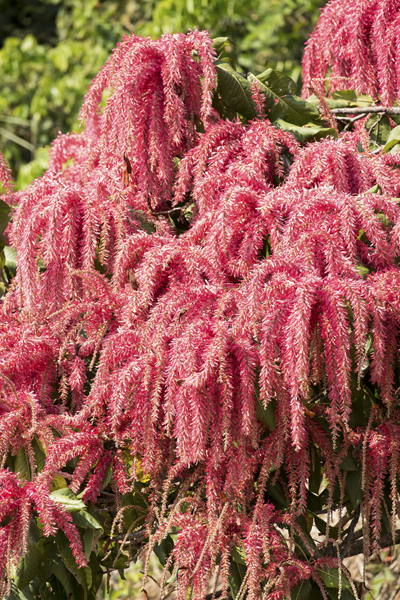
The Devil Tree, a colorful tree whose limbs and trunk
are protected by fierce, biting ants in a symbiotic relationship.
The tree is common, lining the river banks.
Infrareds by Mary
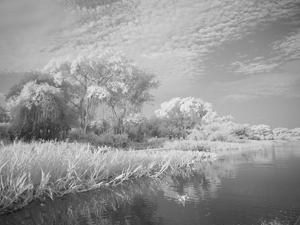
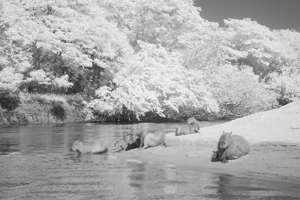 i
i
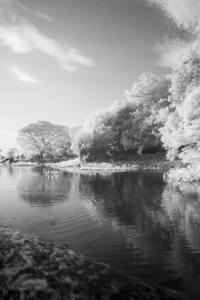
September 9, 2015. South Wild to Cuiaba to home
It rained throughout the night, and sometimes the rain was heavy. Once, around 3:30AM, lightning must have struck close, for the thunder boom woke most of us up. I didn’t sleep well, worried that three flash units, a Range IR, and a L Canon lens on a Mark IV might be ruined by rain, or blown down and broken in the storm. At 5:45 I headed into the gloomy and wet forest, slipping here and there on trails now slick with mud. Miraculously, my gear survived – nothing was wet, thanks in part to Tom’s ziplock bags, and the plastic bags Mary had prudently brought along (I misplaced the ones I thought I packed!) Unfortunately the wind had moved the Range IR and I recorded nothing for the efforts, and after 20 minutes of untying ropes and straps, I returned to the lodge to finish Mary’s packing.
It began to rain again, and Marcos told us that the bus we’d be using for our trip to Cuiaba would meet us at the main road, at the Matamosa Hotel, requiring us to take a boat ride upriver. Considering we had nearly two days of travel ahead of us that was depressing, but as luck would have it the rain stopped and the river ride, though fast, was pleasant and we would like to do that leg more often.
A British birding group had left hours earlier, and their transport vehicle had been stuck on the lodge’s road, requiring the entire camp staff to push them out. We wondered if they’d miss their connections, but they were gone by the time we arrived in Cuiaba, so they were lucky, too. We drove on to Cuiaba without incident, although at the Three Bridges area, near our first lodge, a huge feeding concentration of Great Egrets, Jabiru Storks, Wood Storks, and assorted other waders were congregated en masse, and we figured the water level was now perfect for concerted feeding there.
We had several hours in Cuiaba before we flew on to Sao Paulo, and with a delayed departure we missed the THREE HOUR deadline for upgrading using miles, so we made the uncomfortable journey on to Atlanta in coach, in a rather sleepless night. There, in Sao Paulo, our group parted, as only Tom and Mary and I continued on to Atlanta, with John and Sue heading to the Dakotas for a college reunion, and Bill, Bob, and Laurie, headed home.
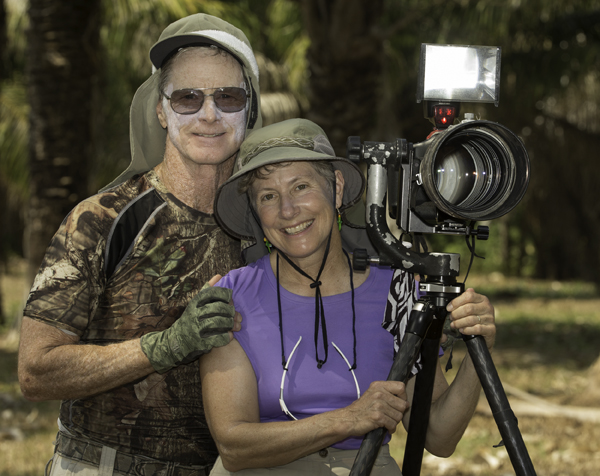
Join us in 2016 -- we'll be doing two trips like the one described above,
and after the second tour we'll be doing a special extension to the
Southern Pantanal - for macaws, giant anteaters, ocelots, and more!
Check out the 2014 and 2012 trip reports!
Read our 2015 brochure. Information applies for 2016,
for reference, although exact dates and prices will differ.








Sign up for our Constant Contact Newsletter to receive the latest information on our up coming tours and safaris, immediate opening offerings, and other news. We do not share this list with any other source.
Join us on Facebook at: Follow Hoot Hollow
JAGUARS and the Wildlife
of the Pantanal
Photo Tour
August-September 2015
Trip Report

Our first Jaguar, with a cub on the riverbank, just minutes after we started our journey to jaguar country and the first of six days of photographing in Jaguar Land!
All Photos by either Joe or Mary Ann McDonald.

It is so easy to ignore landscapes as one is focused on looking for birds or mammals,
but simply using my 100-400 lens and shooting scenes as we went along,
I caught this iconic image of the Pantanal at dawn.
Jaguar and cub! Tayra! Caiman snapping at Tapir! Wow! Read on!
We only did one trip to the Pantanal this year but it was a great one. One goal we’re still trying to achieve is capturing a Jaguar kill, and although we didn’t get one to our complete satisfaction, we did have three kills, two of which we barely saw, but one, Mary captured well, when the Jaguar climbed up the river bank with a Caiman in its jaws. We had 8 different Jaguars, and probably 12-15 different sightings – after a bit, with the amount of Jaguar activity we were having I simply stopped counting. We missed Jaguars on one day, but on that one we made a special trip up a different river for other subjects, and we were quite successful there.
Our mammal photography was fantastic, with shots of Giant Anteaters, Brazilian Tapirs, a Tayra (a large weasel, an animal I’ve only seen as a roadkill in the Pantanal and alive, once, in Panama), Ocelots (via my Range IR camera trap), Marsh Deer, Brocket Deer, Howler Monkey, Capuchin Monkey, Giant Otter, Neotropical Otter, and of course lots of Jaguars.
Birds were diverse, and although we did not have as much activity with diving Ringed Kingfishers, we did extremely well with Great Black Hawks, Black Collared Hawks, Great Potoos, Capped Herons (always elusive in the past), Agami Herons (the colorful trophy heron), Laughing Falcon, and about forty other species.
 Mary shot a lot with a camera converted to Infrared and loved those scenics, and I, stupidly, realized the potential of my Olympus camera with a pop-out LCD, too late to capitalize on river-level shots of Caimans and Capybaras, although I did some neat stuff with the Capybaras at the very end. Perhaps the Caiman work would have been tricky – hands hanging at water level in Caiman waters …. Smart? We did use GoPros, trying to catch Caimans underwater, but the silt-filled water was so murky that nothing showed. On our last full day I tried doing the same with Piranhas, but got brief, seconds only views for the efforts.
Mary shot a lot with a camera converted to Infrared and loved those scenics, and I, stupidly, realized the potential of my Olympus camera with a pop-out LCD, too late to capitalize on river-level shots of Caimans and Capybaras, although I did some neat stuff with the Capybaras at the very end. Perhaps the Caiman work would have been tricky – hands hanging at water level in Caiman waters …. Smart? We did use GoPros, trying to catch Caimans underwater, but the silt-filled water was so murky that nothing showed. On our last full day I tried doing the same with Piranhas, but got brief, seconds only views for the efforts.
The Pantanal is one of our favorite places, and I was concerned, going into this, that it was getting loved to death, as sometimes as many as 20 boats would be vying for position around a Jaguar. That happened on our trip as well, and on narrow waterways this crowding issue, especially with obnoxious boatmen that pull in front and parallel a jaguar, ruining everyone else’s view as they followed a cat along a river bank. However, for the most part the shooting was quite manageable, and at times, when I felt it was too crowded for a quality experience, we simply left and looked for another jaguar. On several occasions we were the only boats on a cat, and the shooting then, as at other times, was great.
The Pantanal, however, offers so much more than just Jaguars, and although everyone comes there hoping to photograph one, the variety the Pantanal offers makes the experience far richer. We were extremely lucky on our first day in Jaguar Land to have a first – a mother Jaguar and Cub along the riverbank, and I believe everyone got some decent shots of this, a very first experience for us.
On this trip, I used the new Canon 100-400 which I found to be incredibly sharp, which I used for quick shots, flight shots, and for situations where trying to position my heavier lens on a monopod was impractical. I used a 200-400mm mounted on a Really Right Stuff Monopod and Really Right Stuff Pro Monopod head for the times when I was shooting Jaguars with a bit more time (90% of the jaguar shooting. Those two lenses and two camera bodies easily fit inside my Gura Gear Bataflae bags which I kept in the skiff with me as we motored along looking for Jaguars. Mary used basically the same combination, with the 100-400, and a fixed 500mm f4 lens. In the last two trips, Alaska and this one, we've had one photographer on each using the new Sigma 150-600mm image-stabilization lens, and both loved that lens. I used 64 and 32gb Hoodman Cards. When I was shooting on land I used a Wimberley Gimbal II head, mounted on a Really Right Stuff Tripod. I've used the RRS quick release clamps so that I can, when necessary, change from a Wimberley to a BH40 or BH55 head, and I would highly recommend anyone who plans on using two heads on a trip, like a Wimberley and a BH40 oe BH55, use these plates. Just a couple of pieces are involved, and I've listed the pieces for this below, and I can't stress how convenient this system is for switching heads!
TA-LBC: Round lever-release clamp
Round lever-release style quick-release clamp
TH-DVTL-55: Round Dovetail Plate
Round Dovetail Plate
TH-DVTL-40: Round Dovetail Plate
Round Dovetail Plate

For my remote camera work that I refer to later, I used the RangeIR
camera trigger, and a Really Right Stuff TP-243 Ground 'Pod. I supported my three flashes with 1/4" threaded rods, small ballheads, and Phottix flash slaves, that triggered the flashes from a master mounted on the camera.
Here’s the trip report … which I hope whets your appetite to visit the Pantanal with us, next year! Regarding that, one of the things that struck me was the lack of preparation, or proper gear, I observed with most photographers we saw. I won’t go into details on this, but it was obvious that some folks didn’t have what they should have had, and that pre-trip preparation we give our participants truly set our group apart from a lot of the photographers we saw in the Pantanal. We prepare our folks! Here’s the report:
August 26, 2015. Sao Paulo
We arrived into Brazil and the Sao Paulo Airport in the early morning hours without incident, reaching our overnight stay, the Marriot, by 8, with an early check-in possible by 10. After a breakfast we reached our rooms and slept, until 3 when I visited the exercise room and Mary worked on welcome letters for our upcoming trips. By late afternoon the last of our participants had arrived, putting us in good shape for our flight to Cuiaba the following day with all of our luggage along!
August 27, 2015. Cuiaba to Pouso Curicaca
We didn’t arrive in To Cuiaba until after 2PM, had lunch, and headed west towards the Pantanal, arriving after dark at our first lodge, of one my favorites. It was too late in the evening to attempt a camera trap but Mary and I occupied the time tearing apart our luggage to get ready for the following day’s shoot.

Howler Monkey female, reclining. Male Howler's are black.
August 28, 2015. Curicaca to Puaso Allegre
We awoke around 5:45 with light just coming in to the clearings that surround our cabins. Marcos, our guide, was already at work, and informed us that a group of Coatimundis, long tailed, raccoon relatives, were at the feeder near the dining area. By the time we arrived, just minutes later, the Coatis were gone, but Wood-Rails, Southern Crested Caracaras, Oropendolas, and later, Spectacled Caimans all gathered here for scraps. Eventually the Coatis returned, or one did, a lone male that fearlessly ate nearby.
Near the parking area a pair of Howler Monkeys were visible, although the black male was barely so, hidden in thick leaves. The light brown female was completely in the open, sitting huddled for much of the time but at one point putting on a show, stretching and lying on her back on a branch, before she moved off into thicker cover. Marcos spotted two different Great Pootoos, monstrous nightjars that resemble broken branches as they sit motionless on a limb.

Large-billed Tern

White-necked Heron
After breakfast we headed to the main road to photograph birds, stopping along the way for Black-collared Hawk, White-necked Heron, Amazon and Ringed Kingfishers, and two shy Capped Herons that eluded us. On the main road Large-billed Terns fluttered overhead while the pools were thickly lined with Spectacled Caimans. Last year there had been unusually heavy rains and the Pantanal was still quite wet, and consequently, Caimans were virtually absent. This year, a normal or even exceptionally dry year, Caimans once again line the waterways and ponds, gathered together at the only available water still remaining.
After lunch we headed to our next lodge, Allegre, where we would spend two nights. We arrived by 2:30, and by 4PM we were off, in our open safari vehicle once again, headed to a waterhole where we hoped to find Tapir. 
The Giant Anteater at the waterhole.
Shortly after we arrived a Giant Anteater lumbered into view, took a drink, then a U-turn, and headed back the way it had came. A large group of at least 11 Coatimundis visited next, drinking and being threatened by a Sunbittern. No tapirs appeared.
At sunset we headed out on a Night Drive, with Marcos and I using spotlights, and the drive was one of the best, with Collared Peccary, two Brazilian Tapirs – one giving us a very good sighting and some shots, Crab-eating Foxes, and several nightjars. The highlight was another Great Potoo, perched high in a tree. These birds have enormous mouths by which they catch flying insects at night, and I always thought they somehow fed like Whale Sharks, flying mouth open and collecting food. They do not, but instead the bird we watched perched like a hawk and watched the surroundings and, presumably, when a moth flew by, the Pootoo gave chase and caught the moth on the wing. This made perfect sense for such a large bird to sit and wait and watch, and then pursue, rather than flying about as a Nighthawk might.
We reached the lodge close to 9PM for a late lunch and early bed, for a very early departure tomorrow for a predawn game drive.
August 29, 2015. Curicaca to Pouso Allegre

We left the lodge at 4:40AM for a pre-dawn, night game drive, but with the clear skies, ‘super’ moon, and cool temperatures the landscape was shrouded in fog. We spotted nothing of interest before sunrise, and as the sun cleared the trees we stopped at a nice Jabiru Stork nest to photograph the pair in the early light. The birds were collecting nesting material so the activity was constant and we spend nearly 2 hours with the birds. Our safari vehicle drive, Antonio, spotted two Ferringous Pigmy Owls high in a tree, and Bill and Sue, while still in the vehicle, had a good shooting session with a Brocket Deer that passed close by. Coatimundis, skinny, long-nosed relatives to Raccoons, fed in a field close-by when we were driving back to the lodge, a nice treat for the morning shoot.

After breakfast we went looking for Marmosets and a roosting Pootoo, and although Mary and I saw the marmosets they were on the run and offered no photos. We couldn’t find the Pootoo, but we have more chances coming up, and we returned to the lodge in late morning to work on birds, download, write, or sleep.
PM. We headed back to the water hole for mammals, while Laurie rode with us as far as a Tiger-Heron nest where she had great luck photographing the normally impossibly elusive Capped Heron. The rest of us parked at the pond, where a Tayra, a large Mustelid (weasel family) trotted by, reminding me more of a prancing Poodle than a loping weasel, their usual gait. The  Tayra didn’t stay long but several of us managed a few shots.
Tayra didn’t stay long but several of us managed a few shots.
No giant anteaters arrived and the shooting was slow compared to yesterday, so we headed out for the night game drive and, at first, the drive seemed quite unproductive. As we headed back in to the lodge, however, Marcos spotted a Tapir that was walking towards the road and a roadside pond, where it paused to drink, giving great views. A Caiman glided in, perhaps in defense of its babies, and lunged as the Tapir, and Bob, Sue, and I got shots in varying stages of the lunge – brilliant! The Tapir moved behind us, and we backed up where we had it another nice series, making for a very successful night drive!

Yacare (spectacled) Caiman lunging at Brazilian Tapir, probably
in defense of her hatchlings in the same small pond.
August 30, 2015. Pouso Allegre to South Wild

Toco Toucan
We opted to stay around the lodge for the morning shoot, where several people slept in and relaxed, while the rest of us chased Toco Toucans, Hyacinth Macaws, Campo Flickers, Chachalacas, and other birds. Mary spotted a Pigmy Ferruginous Owl, which we managed to shoot before it went into its roost hole, where it stayed before we could summon anyone else to the fleeting opportunity.


Ferruginous Pigmy Owl; Smooth-billed Ani


Toco Toucan; Whistling Heron


Narrow-billed Woodcreeper; Black and White Tegu
 Marcos found a very cooperative troop of Brown Capuchin Monkeys, and Mary and I spent most of the remaining portion of the morning photographing them. Mary managed a trophy shot of the female with a baby on her back, a view that eluded me! Two different hives – one of large colony of Wasps and another of Honeybees – made moving through the forest a little dicey, but the insects ignored us and I shot both hives. A huge Black and White Tegu, a monitor-like lizard, hunted the ground below the monkeys, pausing when it saw me, and giving me a chance for several portraits. Later, I think it caught a snake, for there was much trashing about, but we had to pack to depart and the lizard was in thick undergrowth so I passed.
Marcos found a very cooperative troop of Brown Capuchin Monkeys, and Mary and I spent most of the remaining portion of the morning photographing them. Mary managed a trophy shot of the female with a baby on her back, a view that eluded me! Two different hives – one of large colony of Wasps and another of Honeybees – made moving through the forest a little dicey, but the insects ignored us and I shot both hives. A huge Black and White Tegu, a monitor-like lizard, hunted the ground below the monkeys, pausing when it saw me, and giving me a chance for several portraits. Later, I think it caught a snake, for there was much trashing about, but we had to pack to depart and the lizard was in thick undergrowth so I passed.
 On the way to South Wild another rare lizard, a Caiman Lizard, crossed the road. I’ve only seen one other live specimen, and that was from a boat, so this was a treat. Caiman lizards have powerful jaws and remind me of Savannah Monitors, and they use their thick jaws to crush snails, their normal diet. A bite from one would be extremely painful – imagine the force required for crushing snails daily!
On the way to South Wild another rare lizard, a Caiman Lizard, crossed the road. I’ve only seen one other live specimen, and that was from a boat, so this was a treat. Caiman lizards have powerful jaws and remind me of Savannah Monitors, and they use their thick jaws to crush snails, their normal diet. A bite from one would be extremely painful – imagine the force required for crushing snails daily!
PM. After lunch Marcos, Mary, and I headed into the forest where I would set up a RangeIR camera trap with three flashes. Trying to find a position  for a back light was difficult, but eventually, with a lot of lashing and another branch as a brace I had that flash, and the others in position. Later, at dusk I’d return to turn on the flashes and camera and hope for the best.
for a back light was difficult, but eventually, with a lot of lashing and another branch as a brace I had that flash, and the others in position. Later, at dusk I’d return to turn on the flashes and camera and hope for the best.
At 3:30 we headed down river trying for flying hawks and kingfishers. Apparently they’d already been fed for although a few Ringed Kingfishers passed by the bait, none hit, and only a few of us were lucky enough to be framed high enough to capture a shot. Three times Black-collared Hawks came in, but only one was reasonably productive – these birds are fast!

At 5:45 we returned to the lodge to a surprise Sundowner, Caparinis or soft drinks, and appetizers – a nice touch. Shortly afterward, Marcos and I hiked back into the jungle to turn on the flashes and cameras, and the day was complete.
August 31, 2015. South Wild
Several of us, Lori and Bob, and Mary and I, spent a bit of time in the Jabiru Stork tower where four one-third grown chicks attended by an adult. Except for some wing-stretching there was not too much activity, and the mate never flew in to join the group at the nest.


After I set up a RangeIR camera trap I crawl through it to make sure I have the framing, focus, and lighting correct, and perhaps framed so that even a Jaguar will fit in the frame. I positioned one flash closer to the tripping point, backlighted, to create a more three-dimensional scene. I cover ALL of this in our Advanced (Flash) course that we'll hold next summer.
I’d picked up the camera and flashes at first light, and was rewarded with about six shots of an Ocelot that passed by. Another photographer, who manned a baited station from a tower quite close by had stayed until 11PM and had nothing – so I was lucky!
After breakfast we did another run with the hawks and kingfishers, and had great luck with a Great Black Hawk, that came in for fish seven times! We had two very frustrating runs with Black-collared Hawks – one was a perfect opportunity, right at the camera, and my focus went right to the trees beyond – a complete miss! Ringed Kingfishers were cooperative, but only for a few passes.


Great Black Hawk; Ringed Kingfisher
After the river birds we stopped at the lodge to gather our tripods and telephotos and headed, by boat, to a Great Potoo roost. I went on ahead with Marcos to make sure we were not repeating another stupid hike in the heat, and the bird was there, and in a perfect position. I set up a Pocket  Wizard and returned to the boat to collect the group, then fired shots as we walked back, hoping to catch the Potoo with its eyes open. The bird was closer than I thought and some people were having trouble getting the entire bird in the frame with 500mm lenses, although Mary, using the exact same combination, had no trouble doing so. Amusingly, one person returned to the boat to collect a shorter lens, only to discover that he had the lens in his backpack the entire time – wearing the pack back and forth!
Wizard and returned to the boat to collect the group, then fired shots as we walked back, hoping to catch the Potoo with its eyes open. The bird was closer than I thought and some people were having trouble getting the entire bird in the frame with 500mm lenses, although Mary, using the exact same combination, had no trouble doing so. Amusingly, one person returned to the boat to collect a shorter lens, only to discover that he had the lens in his backpack the entire time – wearing the pack back and forth!
At 1:30 I headed back into the forest to set up the Range IR system again, and right at my setup a troop of Brown Capuchin Monkeys had gathered. They are fed, and these monkeys looked like they were about to mug me for some chow, so I power-walked the quarter mile back to the lodge, grabbed my tripod and lens and flash, and power-walked back. Since no one was about, and probably sleeping, I hadn’t bother raising an alarm, since nearly 15 minutes would pass before I’d be back. When I arrived the  monkeys were gone, but I started shouting ‘Monkey! Monkey’ and the monkeys returned. I brought bananas and with much difficulty baited limbs and ran back to the camera to shoot, missing a lot of opportunities in doing so. The male was particularly bold, and I worried he might jump on me in his eagerness to grab a banana. He did not.
monkeys were gone, but I started shouting ‘Monkey! Monkey’ and the monkeys returned. I brought bananas and with much difficulty baited limbs and ran back to the camera to shoot, missing a lot of opportunities in doing so. The male was particularly bold, and I worried he might jump on me in his eagerness to grab a banana. He did not.
At 3:30 we headed far upriver, where Giant Otters are extremely tame, and in an area I’d not been to before, always stopping far short of this destination. En route we had the best Capped Heron photo opportunity I’ve ever had, and later an absolutely spectacular show with a pair of Giant Otters, that swam around our boat, extremely bold and very curious.


Capped Heron; Agami Heron
Below: Sungrebe

Afterwards, towards dusk, we headed back, and Marcos spotted a rare Agami Heron in a tree. It headed for deeper cover when we stopped, but Marcos’ and my boat circled around, and got shots. Marcos’s boat was in great position and Sue got some super shots, and I did well, too. Bob kept missing focus, and Laurie couldn’t see the bird – it is dark, and blended in, but was in clear view, so it was a frustrating time for her, and for Marcos who was using a laser pointer to try to position the bird for her.
It was dark by the time we returned and Mary, Marcos and I headed back into the jungle to set up the camera and RangeIR for another try.
September 1, 2015. South Wild to the Flotel
I left at 6AM with Marcos to retrieve my RangeIR setup, not wishing to leave the gear unattended for the six days we’d be at the Flotel and in Jaguar country. Once again, I had luck with an Ocelot (the same one?) passing by. The photographer in the scaffold, with a bait site illuminated by a bright focusing light, had nothing, and left his stake out at 11PM. I was asleep!
Toco Toucans and Tropials were around the various feeders at South Wild, so the bird shooters had some opportunities before breakfast. Afterwards we boarded our bus for an uneventful drive to Porto Joffre. En route, we met our two wonderful friends and puma guides from Chile, Rodrigo and Christina, and we had a few minute chat before continuing on.

By 11 we were on the river and headed upriver to the Flotel, but only five minutes out we found a mother Jaguar and her half-grown cub. She paused along the river bank and the cub was visible, setting a record for us for the shortest time in seeing a Jaguar. Two other boats came in, with one briefly cutting us off, but the driver was only trying to position his people and had to pass us in doing so. One of our participants growled a complaint, but Marcos asked me to tell everyone to keep their cool, so that guide fights wouldn’t start up. Guides are trying to cooperate with one another on an increasingly busy river.
PM. We left at 2PM and had a relatively uneventful afternoon. We were rather far up river when we received word that a Jaguar had been spotted on Picare River, up from our house boat. We raced to the location, and Marcos’s boat, with Sue and Tom, were already there, and had about five minutes of good Jaguar shooting. As we arrived, with several other boats, the Jaguar yawned and got up and walked into the brush. It moved downriver, and we followed, getting a few glimpses but no photos.
Afterwards, we backtracked and returned to the main channel, getting as far as the Caiman Island before turning back for home. It was a slow afternoon.
 September 2, 2015. Jaguar Land
September 2, 2015. Jaguar Land
We left at 5:55AM and had the river to ourselves for nearly two hours. A family of Giant Otters had gathered at a log by their den, but the light was too low for shooting and the otters swam off. We didn’t bother following. Instead, we moved up the main channel to a wonderful side channel with low water, where we tried to photograph Spectacled Caiman doing the ‘Bubble Dance’ where males vibrate their chest cavity and create a  cascade or fountain of water above their back. One of our Caimans did so, but its back was so low in the water that the water itself only looked disturbed, and no spray rose above the surface. Mary, on the Black Lagoon, had one very cooperative Caiman and did get the dance, and later also had great shots of a Caiman eating an armoured catfish.
cascade or fountain of water above their back. One of our Caimans did so, but its back was so low in the water that the water itself only looked disturbed, and no spray rose above the surface. Mary, on the Black Lagoon, had one very cooperative Caiman and did get the dance, and later also had great shots of a Caiman eating an armoured catfish.
Marcos’s boat had a good Crane Hawk, the African Gymnogene ecological equivalent, and we had a very cooperative family of Capybara feeding upon water hyacinths. A female Green Tree Iguana was either laying eggs, or having already done so, filling in the nest hole, and her work was visible, and obvious, from over a hundred yards away, a pyramid of darker sand whose apex led directly to the hole. We passed the area about two hours later and the disturbed sand that had been scooped out was still visible as a darker shade, but the female had filled in the hole with dry sand that came from around or above the nest hole.
 Mary also had a pair of Howler Monkeys in good view that were mating, a process she said went on for several minutes. My boat had a very good Southern Screamer, a huge turkey-like bird distinguished by a pair of sharp, bony spurs that project from the wing joint. As a defensive weapon, especially if the bird flew past and clipped an intruder with the wing, the spurs would be formidable.
Mary also had a pair of Howler Monkeys in good view that were mating, a process she said went on for several minutes. My boat had a very good Southern Screamer, a huge turkey-like bird distinguished by a pair of sharp, bony spurs that project from the wing joint. As a defensive weapon, especially if the bird flew past and clipped an intruder with the wing, the spurs would be formidable.
We returned to the boat by 11:40, for a quick lunch before a 2PM departure.
PM. We left at 1:50 in very hot conditions and headed upriver. We were exploring the Black Lagoon when we received a call that a Jaguar had been sighted on the Cuiaba River, and we headed there, fast. When we arrived the cat was lying in the open, mostly sleeping but occasionally lifting its head, but several boats were converging and we were jockeying for position, with me dropping anchor or tying off to another boat – net result, I didn’t get any shots. The cat, meanwhile, got up and stepped out of view, where it resettled. Laurie and Bob got some shots, but it was bouncy and the window was narrow, so it was a frustrating several minutes.
We waited, in the sun and the heat, and sweated. Finally, around 4:45, we decided to look downriver for the mother and cub we’d seen yesterday. All of our boats headed downstream, but saw no Jaguars. My boat turned back first, while Mary’s and Tom’s boat stopped for some Capybaras on the beach. I had just decided to continue on, if the Jaguar wasn’t visible, since we’d have good light if we would find something. Luckily, we didn’t follow through I my decision, as the Jaguar had just awoke and had begun walking downriver as we reached her area. For the next thirty minutes or so we  followed her downriver, as she hunted the shoreline, swam, struggled through thick tangles of floating hyacinths, and finally walked the beach. The shooting views were excellent, but with as many as 15 boats often powering past those boats already in position, there were frequent wakes, and some of the best shots or positions, especially as she walked down the beach, were missed because of all the bounce. Still, I shot around 600 frames, and Bill said he shot over 1,200, so there HAS to be a lot of good ones in the bunch. We were shooting into the sun-side, in deep shade, so ISOs ranged from 1000 to 3200, at shutter speeds around 1/500th at times.
followed her downriver, as she hunted the shoreline, swam, struggled through thick tangles of floating hyacinths, and finally walked the beach. The shooting views were excellent, but with as many as 15 boats often powering past those boats already in position, there were frequent wakes, and some of the best shots or positions, especially as she walked down the beach, were missed because of all the bounce. Still, I shot around 600 frames, and Bill said he shot over 1,200, so there HAS to be a lot of good ones in the bunch. We were shooting into the sun-side, in deep shade, so ISOs ranged from 1000 to 3200, at shutter speeds around 1/500th at times.
It ended up to be a very great day!
A Bird Portfolio


Roadside Hawk; American Pigmy Kingfisher

Guira Cuckoo


Boat-billed Heron; Rufescent Tiger-Heron

Rufous-tailed Jacamar

Anhinga with Catfish

Snowy Egret

Black-backed Water Tyrant
September 3, 2015. Jaguar Land
We left at 6, with Mary, Laurie, and Bob going up the Black Lagoon, while Tom, Bill, and I went up the main channel and to the Charles Creek, where we hoped to find Caimans doing the bubble dance. Caimans were quite inactive, and the shooting was rather slow. Meanwhile, Mary’s boatman pushed through the vegetation-choked narrows and went far up the lagoon, to areas where we reached last year with high water. They did well with birds.

At 7:30 they were returning into the main lagoon and found several boats already gathered as McJaguar, a dominant and famous male, was spotted. Meanwhile, we were at Caiman Island, photographing Caimans basking, with one framed against a blue sky. We got the call while there and hurried to the lagoon, where we joined in a rather orderly cluster of boats that followed the Jaguar down river.
McJaguar was hunting, walking the shoreline and going into the water, stomping through hyacinth clusters and grasses, or moving so silently through both that we could barely see its progress via moving vegetation. At  one point the Jaguar charged ahead, then leaped, but missed whatever he was after. I also completely missed the shot, with the wrong exposure (I was resetting at the time), wrong framing, and wrong focus! Mary got two of the three peak action shots, only missing the last.
one point the Jaguar charged ahead, then leaped, but missed whatever he was after. I also completely missed the shot, with the wrong exposure (I was resetting at the time), wrong framing, and wrong focus! Mary got two of the three peak action shots, only missing the last.
At one point, as McJaguar moved through the aquatic vegetation he must have disturbed something, for he lunged and dove beneath the water but came up empty. That was a great observation, however, as it showed how the Jaguars work almost like Raccoons, sometimes feeling prey with their feet and then responding. That cat dove underwater and stayed down for a few seconds – it was trying to snatch something, and we were sure it had been successful, but it wasn’t.


At one point mid-morning McJaguar did capture a three foot long Caiman, although all most of us could see was splashing water. Mary’s boat was in a good position for when the cat left the water, and she nailed several shots of the Jaguar carrying the Caiman ashore. Oddly, instead of retreating for the usual hundred yards or so away from the water, the cat simply went to the nearest trees and ate the caiman there.
We waited, hoping that the Jaguar would come to the water to drink, and eventually it did. After it returned, another, larger Caiman swam towards the shore, and the Jaguar, although just having completed one meal, went into an active stalk. It paused at the water’s edge about 10 yards or so from
the Caiman, which was facing away, and just waited. Unfortunately the cat’s tail twitched constantly, and I think that’s what alerted the Caiman, that dashed away with a big splash.
We waited, and as it was approaching lunch time we were thinking of moving, since the cat looked fairly settled. But we lingered, and just as we decided to go, and had begun to pull out to start motoring, McJaguar got up and started hunting down the river. That’s when we had the near kills described above!

We followed the cat for at least a half hour, with only our boats, and one other with just one passenger aboard, and obtained great shots. As the cat neared the end of the lagoon it moved off into the interior, and we suspected it might hunt the Three Brothers river, which has a stronger current. We headed to lunch.
 PM. We headed up the Three Brothers, Charles Creek, and the branch that divides Peter’s Island, but the afternoon was fairly slow. I had a reasonable Laughing Falcon, and later, in the same area, Mary had a group of Howler Monkeys come to the river to drink. Although we covered some great jaguar country, and we were the only boats on this stretch of river, nothing of note materialized, making this a pleasant but slow afternoon.
PM. We headed up the Three Brothers, Charles Creek, and the branch that divides Peter’s Island, but the afternoon was fairly slow. I had a reasonable Laughing Falcon, and later, in the same area, Mary had a group of Howler Monkeys come to the river to drink. Although we covered some great jaguar country, and we were the only boats on this stretch of river, nothing of note materialized, making this a pleasant but slow afternoon.
September 4, 2015. Jaguar Land to the Fish Camp

Crane Hawk, harassed by a swallow.
 We left at 6 for an excursion up the Picare River to a remote fish camp where Yellow Armadillo are frequently seen, and Hyacinth Macaws are abundant. Our journey upriver , a trip that takes about 50 minutes in a direct ride, took over three hours, as we had a den of Giant Otters (I missed these, tied up with a Rufous and Green Kingfisher, but the other boats had great shooting), a Crane Hawk that was bombarded by White-rumped Swallows as the Hawk foraged along a pile of tree trunks wedged into a river bank, a Pied Plover, and the Kingfisher. The Otter family really performed, occasionally playing with a one-third grown baby, and scent marking and rolling at the top of the river bank.
We left at 6 for an excursion up the Picare River to a remote fish camp where Yellow Armadillo are frequently seen, and Hyacinth Macaws are abundant. Our journey upriver , a trip that takes about 50 minutes in a direct ride, took over three hours, as we had a den of Giant Otters (I missed these, tied up with a Rufous and Green Kingfisher, but the other boats had great shooting), a Crane Hawk that was bombarded by White-rumped Swallows as the Hawk foraged along a pile of tree trunks wedged into a river bank, a Pied Plover, and the Kingfisher. The Otter family really performed, occasionally playing with a one-third grown baby, and scent marking and rolling at the top of the river bank.

Giant Otter feeding on a fish

Romantic Hyacinth Macaws
At the Fish Camp we did very well with Hyacinth Macaws, including a pair that Mary photographed mating. Unlike the usual and quick cloacal kiss, these birds stayed together for a short time, and actually ended up facing away from each other, reminiscent of the ‘tie’ of mating dogs. Shortly after coming ashore we had a great shooting opportunity with Yellow-rumped  Casiques, oriole-like birds that build a nest somewhat between a weaver’s and an oropendola’s. Males were coming and going with nesting material and, I suspect, after securing a female probably leaving the raising of the young to the female alone – but I am not sure of this!
Casiques, oriole-like birds that build a nest somewhat between a weaver’s and an oropendola’s. Males were coming and going with nesting material and, I suspect, after securing a female probably leaving the raising of the young to the female alone – but I am not sure of this!
PM. To avoid the heat we left at 2:30, with my boat first exploring the Black Lagoon, which offered nothing to shoot. We headed up the Three Brothers River, finally reaching the now vegetation-choked San Pedro, where two Jaguars had been seen mating today, but far off. We continued on, then had a radio call that a Jaguar had been sighted about a half mile downriver from Caiman Island. We arrived, but saw nothing.
After about an hour’s wait we headed up to Caiman Island, searching the  river bank in case the Jaguar had moved up river. At one point we pulled into the beach, and as we did so I spotted a two foot long Caiman in the process of trying to swallow a six inch long Armored Catfish. We were on the wrong side of the light so after a few insurance shots we moved to the sunny side, where we waited for the Caiman to relax and to try to swallow this disproportionately huge meal. It tried several times, juggling the fish into various positions, which I thought would attract the attention of a nearby Tiger Heron, that might steal it. Oddly, the Heron ignored the activity.
river bank in case the Jaguar had moved up river. At one point we pulled into the beach, and as we did so I spotted a two foot long Caiman in the process of trying to swallow a six inch long Armored Catfish. We were on the wrong side of the light so after a few insurance shots we moved to the sunny side, where we waited for the Caiman to relax and to try to swallow this disproportionately huge meal. It tried several times, juggling the fish into various positions, which I thought would attract the attention of a nearby Tiger Heron, that might steal it. Oddly, the Heron ignored the activity.
A Southern Crested Caracara did see the action and flew in, and circled the Caiman. I thought it would be more aggressive but it kept its distance. A Black Vulture flew in next, perched somewhat close to the Caracara. Another Caracara flew in, and knocked the Black Vulture over, into a real tumble, as it flew over. Now, with two Caracaras around the Caiman I figured it would lose the fish. It did not, and eventually both Caracaras flew off.
 The Black Vulture approached, and the annoyed hissing that I thought was from the Caiman was, I discovered, from the Vulture! Later, the same bird gave low, somewhat quiet dog-like barks, a quite surprising sound. The Vulture spread its wings and advanced, then hopped into the air – perhaps because of our camera clicks, while the Caiman trotted across the sand with the fish still clasped in its jaws.
The Black Vulture approached, and the annoyed hissing that I thought was from the Caiman was, I discovered, from the Vulture! Later, the same bird gave low, somewhat quiet dog-like barks, a quite surprising sound. The Vulture spread its wings and advanced, then hopped into the air – perhaps because of our camera clicks, while the Caiman trotted across the sand with the fish still clasped in its jaws.
The Vulture was so close that my shadow covered the bird, so I got out of the boat to shoot, while the Caiman continued walking away. With the shooting over I peed, and as I returned to the boat spotted a FRESH Jaguar track right at the wet sand line, so fresh that the rough crusty edges were sharp, and raised, as if the cat had been in a hurry. Considering how many boats pass by, creating big wakes that roll waves on to the beach, this track had to be only minutes old. As I was standing, peeing, I had heard leaves and branches cracking, and I figured it was a bird or capybara, but who knows? It may have been within yards of me. Earlier, just ten minutes or less, Mary had passed by the same spot, and cruised inside the bay looking for cats, and other photo boats had passed as well, so it had to have happened almost right before we arrived. Pretty exciting, for  a close call on what would have been a fantastic sighting, in great light and in the open. We cruised the bay as well, then slowly moved downstream, but had nothing.
a close call on what would have been a fantastic sighting, in great light and in the open. We cruised the bay as well, then slowly moved downstream, but had nothing.
On the way back I played ‘bat baseball,’ trying to catch a Fishing Bat with the flash in the dim light. I did manage one good one, although the wing blocked the bat’s head.

A desperate, coffee-craving Joe being served,
via a paddle from Marcos's skiff!
September 5, 2015. Jaguar Land
Hoping to get more shots of the baby Giant Otter and den activity, we headed up the Picare River once again, leaving at 6. En route, Marcos’s boat had a Tapir that appeared about to cross the river, but headed back into the forest when it heard the boats. We reached the den site just as the sun clearing the low clouds hugging the eastern horizon, but the Otter den was  quite. Chachalacas and Piping Guans picked at bugs or otter droppings at the toilet site, and two Otters swam down river, climbing the bank and smelling leaves, but not scent marking before they left. Marcos thought they were not a part of the family group, or if they were, they had abandoned the site, and hence no scent marking. We stayed about an hour without activity, then headed back towards the Three Brothers.
quite. Chachalacas and Piping Guans picked at bugs or otter droppings at the toilet site, and two Otters swam down river, climbing the bank and smelling leaves, but not scent marking before they left. Marcos thought they were not a part of the family group, or if they were, they had abandoned the site, and hence no scent marking. We stayed about an hour without activity, then headed back towards the Three Brothers.
We stopped to look for the Green and Rufous Kingfisher, where Laurie and Bob had some luck with Boat-billed Herons, and Bob saw a Black Vulture riding the back of a Capybara, apparently picking ticks from its fur. He said the Capybara arched its neck as if in ecstasy. I looked for the Kingfisher with Bill and Sue but the bird was gone, but a Green Kingfisher was in the open and we did some portraits, continuing on to try to shoot a Sunbittern that  proved to be shy. Turning back, we had another Kingfisher that was very tame and we watched, from only a short distance away, as the bird repeatedly dove into the water, returning with twigs or leaves which it would juggle in its beak or beat against its perch, as it would to stun a fish. Another one joined it and did the same, and I believe we were watching two fledglings that were practicing and learning how to fish for themselves. It was a really instructive moment for me, as I’d never seen birds practice before, and certainly fun to watch.
proved to be shy. Turning back, we had another Kingfisher that was very tame and we watched, from only a short distance away, as the bird repeatedly dove into the water, returning with twigs or leaves which it would juggle in its beak or beat against its perch, as it would to stun a fish. Another one joined it and did the same, and I believe we were watching two fledglings that were practicing and learning how to fish for themselves. It was a really instructive moment for me, as I’d never seen birds practice before, and certainly fun to watch.
We continued on, and our boatman, Jaguar John, completely amazed us as we were traveling at a normal cruising speed when he suddenly slowed down and did a U-turn, saying he spotted a Snake. I assumed he’d seen an anaconda on the bank, and so as we motored back and close to the river bank I searched the tree roots for a large snake, and saw nothing. Finally, 
Tiger Rat Snake
 John made it clear to me to look higher up, where I spotted a small section of black, that could have been an old hose washed ashore. That was the snake, and how he saw it was simply incredible. The snake climbed a lliana and eventually gave us a good view, showing its ventral surface, banded yellow, and the back end, all black. The snake was a Tiger Rat Snake, a nonvenomous species that is quite colorful and quite laterally compressed.
John made it clear to me to look higher up, where I spotted a small section of black, that could have been an old hose washed ashore. That was the snake, and how he saw it was simply incredible. The snake climbed a lliana and eventually gave us a good view, showing its ventral surface, banded yellow, and the back end, all black. The snake was a Tiger Rat Snake, a nonvenomous species that is quite colorful and quite laterally compressed.
We continued, stopping at a sand bank where Giant Otters were playing, but most ran into the tall grasses and we had word that two Jaguars had been spotted. Marcos had found McJaguar and another, Maximus, that may have been fighting, perhaps over a third? cat, a female perhaps. McJ was actually running away, with the other cat lopng, head held high, in pursuit, which surprised Marcos. When the pursuit ended McJ went through a rather lengthy scent-marking ritual, rubbing grasses and leaves and rolling around in the vegetation.
The cats had crossed over to the Charles Creek area, and Marcos’s boat headed there, where they found the two cats – one on either side of the very narrow stream. He said that was a tense moment because he wasn’t sure if they’d fight.
 We arrived soon afterwards, one of the last of perhaps 20 boats to arrive, and the cats had disappeared, but soon afterwards McJ showed, walking down the riverbank towards us. The cat passed by close, swam in the hyacinths, and continued on, eventually walking over a sandy beach that I’ve always thought would be the perfect place to shoot a Jaguar. Unfortunately, we were not on the front end of the line of boats, and all I shot was the back end of the cat as it walked over the beach.
We arrived soon afterwards, one of the last of perhaps 20 boats to arrive, and the cats had disappeared, but soon afterwards McJ showed, walking down the riverbank towards us. The cat passed by close, swam in the hyacinths, and continued on, eventually walking over a sandy beach that I’ve always thought would be the perfect place to shoot a Jaguar. Unfortunately, we were not on the front end of the line of boats, and all I shot was the back end of the cat as it walked over the beach.
Soon afterwards the cat was again in hyacinths, made a leap, and captured another Caiman. Bill, in my boat, got a shot of the cat carrying its prey, but I missed it. McJ disappeared in the brush and we headed to the main river, where we were marveling at our morning when my boatman and Mary’s simultaneously spotted another Jaguar, Maximus, laying in the open right beside us! What followed was a massive boat jam as boats jockeyed in position for a shot of the cat lying in the shade. I had my neck stabbed by the pointed end of a boat that rammed us, and felt lucky I didn’t get my teeth knocked out when the boat hit us. We got our shots – one of the better positions, and moved off for others to get in, and motored over to a shady spot where we could watch the cat.

After all the ruckus, things settled down and eventually we did several more passes of the Jaguar, without a motor or the wake of any other boats. Oddly, only our boats did this, the rest just stayed tied on to shore. We were hoping that McJ might finish his caiman and show himself again, but Mary’s boat had left, and had encountered the Giant Otters we had earlier, reporting they were great.
We left, and arrived for about two minutes of very rewarding shooting as two Otters kicked up sand and three or four groomed along the shoreline, before finally slipping into the river and swimming off. We headed to lunch.
PM. We left at 2:30, heading up the Three Brothers River, passing where earlier we had McJaguar and the other male, named Adriano. After we left, we were told that Adriano swam back across the river and stole the Caiman kill from McJaguar. Obviously, McJaguar is no longer the top cat on this section of the rivers!
 At Caiman Island, where yesterday I’d seen the fresh Jaguar track, we were told that a cat was lying on the opposite side of the sand bank. Marcos went through the channel to check, and while he was doing that I spotted the Jaguar on the far end of the bay. We headed inside, and positioned ourselves to be in line when the cat, a female named Patricia, passed by. She did, and we got nice shots, and then she disappeared.
At Caiman Island, where yesterday I’d seen the fresh Jaguar track, we were told that a cat was lying on the opposite side of the sand bank. Marcos went through the channel to check, and while he was doing that I spotted the Jaguar on the far end of the bay. We headed inside, and positioned ourselves to be in line when the cat, a female named Patricia, passed by. She did, and we got nice shots, and then she disappeared.
We moved back to the main channel when another guide that we once had told us that another Jaguar, a male, Romero(?) was upriver. When we arrived there was a cluster of at least 15 boats, all watching a cat that was either sitting Sphinx-like or sleeping. We took a few shots, waited, and then I had my boatman turn back to see if Patricia had reappeared. John, our boatman, spotted her, and we got a great shot when she went to the river’s edge and looked back to us, then climbed the bank and disappeared again.
 We moved up river, to find that the male Jaguar had begun walking, and for the next hour or more we followed the cat downriver. Several times he entered the water to escape the biting flies, which were obviously tormenting the cat, making him snap at the air, shake his head, and sometimes even run to try to escape. At one point we were lined up for a wonderful water-level shot of the Jaguar swimming towards us, but other boats, zipping by too fast, created such a wake that we were tossed about, and getting a shot was impossible. Frustrating!
We moved up river, to find that the male Jaguar had begun walking, and for the next hour or more we followed the cat downriver. Several times he entered the water to escape the biting flies, which were obviously tormenting the cat, making him snap at the air, shake his head, and sometimes even run to try to escape. At one point we were lined up for a wonderful water-level shot of the Jaguar swimming towards us, but other boats, zipping by too fast, created such a wake that we were tossed about, and getting a shot was impossible. Frustrating!
Eventually the Jaguar disappeared into the interior, and we spent the last light of the day chatting, and drinking some beers as a Sundowner to celebrate a great day.

September 6, 2015. Jaguar Land
We left at 6 for a very long excursion, up the Three Brothers until we met the Cuiaba River, then down a different branch of the Brothers to rejoin the main river. We were hoping to encounter some new Jaguars and few people, and we succeeded only in the latter.

Along the way, however, we did find the youngest, largest family of Capybara I’ve seen on the river this year. When we first spotted the family two young ones were on their hind legs boxing, and backlighted by the sun, it was a striking scene, but not a shot, as other Capybaras were in front. We circled around, and for the next hour stayed with these huge rodents, and one time, early on, two climbed onto the back of a third youngster and began to box, but the action lasted just seconds. A Choppi Blackbird flew down and hunted insects off the backs of several Capybaras, and apparently pulled a tick off one, leaving a large red spot on the hide – open flesh, but the Capybara never flinched. With a harem Male on one end, and another adult at the other end of the group, this family group was well-guarded, which might account for the six babies that were still surviving. At one point, all of the young nursed from one female, making we wonder if they communally suckle. Several were chewing, too, as if chewing a cud, a behavior I’ve seen before but haven’t verified.
We did the circuit, having nothing until heading back when we were told Adriano, the Jaguar, had been spotted again. Two of our boats missed it, but Sue and Bill, with Marcos, got some nice shots of the Jaguar lying out on the beach. They also had a brief but productive encounter with a Giant Otter feeding upon a large catfish.

While we waited we received word of another Jaguar on the Cuiaba River, and we headed there, where we spent the remainder of the morning as we followed the cat upriver, where it gave us several short shooting opportunities in clearings, before the cat moved into the Black Lagoon and the thick water vegetation that blocked any further viewing. We headed to lunch.

PM. We left at 2:30, heading up the Three Brothers and Charles Creek, where we photographed Rufous-tailed Jacamars. Afterwards, we had a radio call that Adriano, the male Jaguar, was spotted again, and we headed back onto the Three Brothers, following the cat as it moved to the very end of the peninsula. The shooting was marginal, but it was still fun to get still another jaguar.On the way back we tried photographing bats, unsuccessfully, but a Great Potoo flew by and I managed a poorly focused shot.

September 7, 2015. Jaguar Land to South Wild.
We left at 6 and headed to the Black Lagoon, where we hoped to photograph Caiman doing the Bubble Dance. After several near misses we finally had one male in a good position and with a good bubble dance. This is generated, somehow, by vibrations in the body cavity of the Caiman, 
creating a thrumming roar that you can practically feel, both through the boat and in the air, and a second or two later, the bubbles begin. Actually, it is water droplets springing in the air, like a great fountain, and backlighted, with the head and tail of the Caiman arched, it is a supple and beautiful image.

We continued up the Lagoon, but were soon called back as a Jaguar was spotted on the Charles Creek. When we arrived at least 15 boats were in the narrow channel, but we positioned ourselves, and then waited, when the Jaguar disappeared. All of the boats left – another Jaguar was spotted on the main channel, but we remained behind, and as other boats started to return the Jaguar, McJaguar, appeared, and walked along the opening. Later the cat rested on a river bank, with 20 or 25 boats jammed along the river, and  after the cat moved on, we left, heading back to the lagoon for more caiman shots – which eluded us. Mary stayed on, for a bit, and reported that it became obscene, with two boats trailing the Jaguar, and their boatman actually videoing with a cell phone, and dogging the jaguar, while also getting into everyone else’s way. A Japanese film crew followed, compounding the offense, and with that Mary and our other boat headed out and returned to the Flotel. Meanwhile, my boat went far up the lagoon, but nothing materialized, and we arrived back at the Flotel late, with nothing to show for it.
after the cat moved on, we left, heading back to the lagoon for more caiman shots – which eluded us. Mary stayed on, for a bit, and reported that it became obscene, with two boats trailing the Jaguar, and their boatman actually videoing with a cell phone, and dogging the jaguar, while also getting into everyone else’s way. A Japanese film crew followed, compounding the offense, and with that Mary and our other boat headed out and returned to the Flotel. Meanwhile, my boat went far up the lagoon, but nothing materialized, and we arrived back at the Flotel late, with nothing to show for it.
After a slide show of our work, for our boatmen, we headed to Porto Joffre  and our ride to South Wild, Santa Tereza, where we had a relaxing afternoon and a sundowner in celebration of Tom’s birthday. Along the way we had two Swallow-tailed Kites, one swooping down to the river in front of us. Mary got her 500mm up in time and got a nice shot of this bird, the only time we saw one on the trip!
and our ride to South Wild, Santa Tereza, where we had a relaxing afternoon and a sundowner in celebration of Tom’s birthday. Along the way we had two Swallow-tailed Kites, one swooping down to the river in front of us. Mary got her 500mm up in time and got a nice shot of this bird, the only time we saw one on the trip!
Marcos and I headed into the forest so that I could set up the RangeIR setup, enduring some mosquitos, and returned just before dark.
September 8, 2015. South Wild
At 6 I headed out into the forest with Mary to check the Range IR camera trap, and was disappointed to find only one shot of the back end of an Ocelot. I had brought along bananas, and extra batteries, as I planned to run the camera through the morning in case Currasows or deer moved through. At 8 we did another boat ride for kingfishers and hawks, but strangely we did not find a single cooperative kingfisher.
We did do quite well with Great Black Hawks, and two or three passes with Black-collared Hawks, none of the latter actually dropping down to grab a fish. A weird, hot wind blew throughout the morning, and by 11 we headed back to the lodge. I grabbed a GoPro and Marcos and I did a little experimenting, baiting Piranhas in a shallow bay with sausages. Unfortunately the water was so incredibly murky that fish were visible as mere flashes, and only within two inches or so of the camera. Later, I checked another video I had made at Caiman Island, where I brought a GoPro underwater right up to a Caiman, and I was within inches – and nothing but brown, murky water showed in the video. Afterwards, I immediately headed out to check the RangeIR camera trap, and found to  my surprise that, in addition to the Black and White Tegus, the Purplish Jays, and the White-tipped Doves, a female Jaguar walked by! The cat passed somewhere between when I changed the batteries and camera and a group of bird-watchers walked by, at 7:30AM. That was exciting!
my surprise that, in addition to the Black and White Tegus, the Purplish Jays, and the White-tipped Doves, a female Jaguar walked by! The cat passed somewhere between when I changed the batteries and camera and a group of bird-watchers walked by, at 7:30AM. That was exciting!
PM. After lunch I headed back into the forest to try one final camera trap, this time setting up the system by an inclined log. With this elevated set I had to improvise, and when Marcos later saw it he said ‘McGyver,’ after the TV character that improvised whatever, as I had long limbs lashed together as make-shift tripod lightstands, a boom to support the Range IR, and flashes rigges about.
Caimans and Jaguar Portfolio





At 3:30 we headed upriver where we hoped to find the very tame and cooperative Giant Otters, but they had vanished. To the south and west black clouds loomed and threatened storms, and the light level soon fell dramatically. At 4:45 we called it quits and headed back to the lodge, giving people some extra time to get their final images to us for a group slide show. I headed out to the forest to turn on the flashes, and to water-proof the gear in case the storm came in our direction.
While I was gone, a massive windstorm blew into the lodge, and Laurie, out in a field, was enveloped with dust and had a hard time working against the wind to return. Mary was outside, trying to get her help, and the window shutters of our room blew off from the winds. Meanwhile, except for a dust devil near my setup, and some scattered drops of rain, the weather was calm.
While we had dinner, after our Participants Portfolio slide show, the storm did hit us, blowing rain nearly horizontally, and making me wonder how my gear survived. The front of the lens I was using would now be rain splattered, so unless I had luck early on, I was in for a disappointment tomorrow morning. Provided the gear even held up against the winds!
By 9 the rain was finished or lightly sprinkling, but the air was filled with odd, whistle-like, flute-ish calls, and we couldn’t tell if it was birds, like Whistling Herons, Nightjars, Bats, or songbirds … it was eery, but not in a frightening way. I checked around to see if any staff member was about, as I was going to go back into the jungle to retrieve the gear for packing, but the lodge was quiet.

The Devil Tree, a colorful tree whose limbs and trunk
are protected by fierce, biting ants in a symbiotic relationship.
The tree is common, lining the river banks.
Infrareds by Mary

 i
i

September 9, 2015. South Wild to Cuiaba to home
It rained throughout the night, and sometimes the rain was heavy. Once, around 3:30AM, lightning must have struck close, for the thunder boom woke most of us up. I didn’t sleep well, worried that three flash units, a Range IR, and a L Canon lens on a Mark IV might be ruined by rain, or blown down and broken in the storm. At 5:45 I headed into the gloomy and wet forest, slipping here and there on trails now slick with mud. Miraculously, my gear survived – nothing was wet, thanks in part to Tom’s ziplock bags, and the plastic bags Mary had prudently brought along (I misplaced the ones I thought I packed!) Unfortunately the wind had moved the Range IR and I recorded nothing for the efforts, and after 20 minutes of untying ropes and straps, I returned to the lodge to finish Mary’s packing.
It began to rain again, and Marcos told us that the bus we’d be using for our trip to Cuiaba would meet us at the main road, at the Matamosa Hotel, requiring us to take a boat ride upriver. Considering we had nearly two days of travel ahead of us that was depressing, but as luck would have it the rain stopped and the river ride, though fast, was pleasant and we would like to do that leg more often.
A British birding group had left hours earlier, and their transport vehicle had been stuck on the lodge’s road, requiring the entire camp staff to push them out. We wondered if they’d miss their connections, but they were gone by the time we arrived in Cuiaba, so they were lucky, too. We drove on to Cuiaba without incident, although at the Three Bridges area, near our first lodge, a huge feeding concentration of Great Egrets, Jabiru Storks, Wood Storks, and assorted other waders were congregated en masse, and we figured the water level was now perfect for concerted feeding there.
We had several hours in Cuiaba before we flew on to Sao Paulo, and with a delayed departure we missed the THREE HOUR deadline for upgrading using miles, so we made the uncomfortable journey on to Atlanta in coach, in a rather sleepless night. There, in Sao Paulo, our group parted, as only Tom and Mary and I continued on to Atlanta, with John and Sue heading to the Dakotas for a college reunion, and Bill, Bob, and Laurie, headed home.

Join us in 2016 -- we'll be doing two trips like the one described above,
and after the second tour we'll be doing a special extension to the
Southern Pantanal - for macaws, giant anteaters, ocelots, and more!
Check out the 2014 and 2012 trip reports!
Read our 2015 brochure. Information applies for 2016,
for reference, although exact dates and prices will differ.








Sign up for our Constant Contact Newsletter to receive the latest information on our up coming tours and safaris, immediate opening offerings, and other news. We do not share this list with any other source.
Join us on Facebook at: Follow Hoot Hollow
JAGUARS and the Wildlife
of the Pantanal
Photo Tour
August-September 2015
Trip Report

Our first Jaguar, with a cub on the riverbank, just minutes after we started our journey to jaguar country and the first of six days of photographing in Jaguar Land!
All Photos by either Joe or Mary Ann McDonald.

It is so easy to ignore landscapes as one is focused on looking for birds or mammals,
but simply using my 100-400 lens and shooting scenes as we went along,
I caught this iconic image of the Pantanal at dawn.
Jaguar and cub! Tayra! Caiman snapping at Tapir! Wow! Read on!
We only did one trip to the Pantanal this year but it was a great one. One goal we’re still trying to achieve is capturing a Jaguar kill, and although we didn’t get one to our complete satisfaction, we did have three kills, two of which we barely saw, but one, Mary captured well, when the Jaguar climbed up the river bank with a Caiman in its jaws. We had 8 different Jaguars, and probably 12-15 different sightings – after a bit, with the amount of Jaguar activity we were having I simply stopped counting. We missed Jaguars on one day, but on that one we made a special trip up a different river for other subjects, and we were quite successful there.
Our mammal photography was fantastic, with shots of Giant Anteaters, Brazilian Tapirs, a Tayra (a large weasel, an animal I’ve only seen as a roadkill in the Pantanal and alive, once, in Panama), Ocelots (via my Range IR camera trap), Marsh Deer, Brocket Deer, Howler Monkey, Capuchin Monkey, Giant Otter, Neotropical Otter, and of course lots of Jaguars.
Birds were diverse, and although we did not have as much activity with diving Ringed Kingfishers, we did extremely well with Great Black Hawks, Black Collared Hawks, Great Potoos, Capped Herons (always elusive in the past), Agami Herons (the colorful trophy heron), Laughing Falcon, and about forty other species.
 Mary shot a lot with a camera converted to Infrared and loved those scenics, and I, stupidly, realized the potential of my Olympus camera with a pop-out LCD, too late to capitalize on river-level shots of Caimans and Capybaras, although I did some neat stuff with the Capybaras at the very end. Perhaps the Caiman work would have been tricky – hands hanging at water level in Caiman waters …. Smart? We did use GoPros, trying to catch Caimans underwater, but the silt-filled water was so murky that nothing showed. On our last full day I tried doing the same with Piranhas, but got brief, seconds only views for the efforts.
Mary shot a lot with a camera converted to Infrared and loved those scenics, and I, stupidly, realized the potential of my Olympus camera with a pop-out LCD, too late to capitalize on river-level shots of Caimans and Capybaras, although I did some neat stuff with the Capybaras at the very end. Perhaps the Caiman work would have been tricky – hands hanging at water level in Caiman waters …. Smart? We did use GoPros, trying to catch Caimans underwater, but the silt-filled water was so murky that nothing showed. On our last full day I tried doing the same with Piranhas, but got brief, seconds only views for the efforts.
The Pantanal is one of our favorite places, and I was concerned, going into this, that it was getting loved to death, as sometimes as many as 20 boats would be vying for position around a Jaguar. That happened on our trip as well, and on narrow waterways this crowding issue, especially with obnoxious boatmen that pull in front and parallel a jaguar, ruining everyone else’s view as they followed a cat along a river bank. However, for the most part the shooting was quite manageable, and at times, when I felt it was too crowded for a quality experience, we simply left and looked for another jaguar. On several occasions we were the only boats on a cat, and the shooting then, as at other times, was great.
The Pantanal, however, offers so much more than just Jaguars, and although everyone comes there hoping to photograph one, the variety the Pantanal offers makes the experience far richer. We were extremely lucky on our first day in Jaguar Land to have a first – a mother Jaguar and Cub along the riverbank, and I believe everyone got some decent shots of this, a very first experience for us.
On this trip, I used the new Canon 100-400 which I found to be incredibly sharp, which I used for quick shots, flight shots, and for situations where trying to position my heavier lens on a monopod was impractical. I used a 200-400mm mounted on a Really Right Stuff Monopod and Really Right Stuff Pro Monopod head for the times when I was shooting Jaguars with a bit more time (90% of the jaguar shooting. Those two lenses and two camera bodies easily fit inside my Gura Gear Bataflae bags which I kept in the skiff with me as we motored along looking for Jaguars. Mary used basically the same combination, with the 100-400, and a fixed 500mm f4 lens. In the last two trips, Alaska and this one, we've had one photographer on each using the new Sigma 150-600mm image-stabilization lens, and both loved that lens. I used 64 and 32gb Hoodman Cards. When I was shooting on land I used a Wimberley Gimbal II head, mounted on a Really Right Stuff Tripod. I've used the RRS quick release clamps so that I can, when necessary, change from a Wimberley to a BH40 or BH55 head, and I would highly recommend anyone who plans on using two heads on a trip, like a Wimberley and a BH40 oe BH55, use these plates. Just a couple of pieces are involved, and I've listed the pieces for this below, and I can't stress how convenient this system is for switching heads!
TA-LBC: Round lever-release clamp
Round lever-release style quick-release clamp
TH-DVTL-55: Round Dovetail Plate
Round Dovetail Plate
TH-DVTL-40: Round Dovetail Plate
Round Dovetail Plate

For my remote camera work that I refer to later, I used the RangeIR
camera trigger, and a Really Right Stuff TP-243 Ground 'Pod. I supported my three flashes with 1/4" threaded rods, small ballheads, and Phottix flash slaves, that triggered the flashes from a master mounted on the camera.
Here’s the trip report … which I hope whets your appetite to visit the Pantanal with us, next year! Regarding that, one of the things that struck me was the lack of preparation, or proper gear, I observed with most photographers we saw. I won’t go into details on this, but it was obvious that some folks didn’t have what they should have had, and that pre-trip preparation we give our participants truly set our group apart from a lot of the photographers we saw in the Pantanal. We prepare our folks! Here’s the report:
August 26, 2015. Sao Paulo
We arrived into Brazil and the Sao Paulo Airport in the early morning hours without incident, reaching our overnight stay, the Marriot, by 8, with an early check-in possible by 10. After a breakfast we reached our rooms and slept, until 3 when I visited the exercise room and Mary worked on welcome letters for our upcoming trips. By late afternoon the last of our participants had arrived, putting us in good shape for our flight to Cuiaba the following day with all of our luggage along!
August 27, 2015. Cuiaba to Pouso Curicaca
We didn’t arrive in To Cuiaba until after 2PM, had lunch, and headed west towards the Pantanal, arriving after dark at our first lodge, of one my favorites. It was too late in the evening to attempt a camera trap but Mary and I occupied the time tearing apart our luggage to get ready for the following day’s shoot.

Howler Monkey female, reclining. Male Howler's are black.
August 28, 2015. Curicaca to Puaso Allegre
We awoke around 5:45 with light just coming in to the clearings that surround our cabins. Marcos, our guide, was already at work, and informed us that a group of Coatimundis, long tailed, raccoon relatives, were at the feeder near the dining area. By the time we arrived, just minutes later, the Coatis were gone, but Wood-Rails, Southern Crested Caracaras, Oropendolas, and later, Spectacled Caimans all gathered here for scraps. Eventually the Coatis returned, or one did, a lone male that fearlessly ate nearby.
Near the parking area a pair of Howler Monkeys were visible, although the black male was barely so, hidden in thick leaves. The light brown female was completely in the open, sitting huddled for much of the time but at one point putting on a show, stretching and lying on her back on a branch, before she moved off into thicker cover. Marcos spotted two different Great Pootoos, monstrous nightjars that resemble broken branches as they sit motionless on a limb.

Large-billed Tern

White-necked Heron
After breakfast we headed to the main road to photograph birds, stopping along the way for Black-collared Hawk, White-necked Heron, Amazon and Ringed Kingfishers, and two shy Capped Herons that eluded us. On the main road Large-billed Terns fluttered overhead while the pools were thickly lined with Spectacled Caimans. Last year there had been unusually heavy rains and the Pantanal was still quite wet, and consequently, Caimans were virtually absent. This year, a normal or even exceptionally dry year, Caimans once again line the waterways and ponds, gathered together at the only available water still remaining.
After lunch we headed to our next lodge, Allegre, where we would spend two nights. We arrived by 2:30, and by 4PM we were off, in our open safari vehicle once again, headed to a waterhole where we hoped to find Tapir. 
The Giant Anteater at the waterhole.
Shortly after we arrived a Giant Anteater lumbered into view, took a drink, then a U-turn, and headed back the way it had came. A large group of at least 11 Coatimundis visited next, drinking and being threatened by a Sunbittern. No tapirs appeared.
At sunset we headed out on a Night Drive, with Marcos and I using spotlights, and the drive was one of the best, with Collared Peccary, two Brazilian Tapirs – one giving us a very good sighting and some shots, Crab-eating Foxes, and several nightjars. The highlight was another Great Potoo, perched high in a tree. These birds have enormous mouths by which they catch flying insects at night, and I always thought they somehow fed like Whale Sharks, flying mouth open and collecting food. They do not, but instead the bird we watched perched like a hawk and watched the surroundings and, presumably, when a moth flew by, the Pootoo gave chase and caught the moth on the wing. This made perfect sense for such a large bird to sit and wait and watch, and then pursue, rather than flying about as a Nighthawk might.
We reached the lodge close to 9PM for a late lunch and early bed, for a very early departure tomorrow for a predawn game drive.
August 29, 2015. Curicaca to Pouso Allegre

We left the lodge at 4:40AM for a pre-dawn, night game drive, but with the clear skies, ‘super’ moon, and cool temperatures the landscape was shrouded in fog. We spotted nothing of interest before sunrise, and as the sun cleared the trees we stopped at a nice Jabiru Stork nest to photograph the pair in the early light. The birds were collecting nesting material so the activity was constant and we spend nearly 2 hours with the birds. Our safari vehicle drive, Antonio, spotted two Ferringous Pigmy Owls high in a tree, and Bill and Sue, while still in the vehicle, had a good shooting session with a Brocket Deer that passed close by. Coatimundis, skinny, long-nosed relatives to Raccoons, fed in a field close-by when we were driving back to the lodge, a nice treat for the morning shoot.

After breakfast we went looking for Marmosets and a roosting Pootoo, and although Mary and I saw the marmosets they were on the run and offered no photos. We couldn’t find the Pootoo, but we have more chances coming up, and we returned to the lodge in late morning to work on birds, download, write, or sleep.
PM. We headed back to the water hole for mammals, while Laurie rode with us as far as a Tiger-Heron nest where she had great luck photographing the normally impossibly elusive Capped Heron. The rest of us parked at the pond, where a Tayra, a large Mustelid (weasel family) trotted by, reminding me more of a prancing Poodle than a loping weasel, their usual gait. The  Tayra didn’t stay long but several of us managed a few shots.
Tayra didn’t stay long but several of us managed a few shots.
No giant anteaters arrived and the shooting was slow compared to yesterday, so we headed out for the night game drive and, at first, the drive seemed quite unproductive. As we headed back in to the lodge, however, Marcos spotted a Tapir that was walking towards the road and a roadside pond, where it paused to drink, giving great views. A Caiman glided in, perhaps in defense of its babies, and lunged as the Tapir, and Bob, Sue, and I got shots in varying stages of the lunge – brilliant! The Tapir moved behind us, and we backed up where we had it another nice series, making for a very successful night drive!

Yacare (spectacled) Caiman lunging at Brazilian Tapir, probably
in defense of her hatchlings in the same small pond.
August 30, 2015. Pouso Allegre to South Wild

Toco Toucan
We opted to stay around the lodge for the morning shoot, where several people slept in and relaxed, while the rest of us chased Toco Toucans, Hyacinth Macaws, Campo Flickers, Chachalacas, and other birds. Mary spotted a Pigmy Ferruginous Owl, which we managed to shoot before it went into its roost hole, where it stayed before we could summon anyone else to the fleeting opportunity.


Ferruginous Pigmy Owl; Smooth-billed Ani


Toco Toucan; Whistling Heron


Narrow-billed Woodcreeper; Black and White Tegu
 Marcos found a very cooperative troop of Brown Capuchin Monkeys, and Mary and I spent most of the remaining portion of the morning photographing them. Mary managed a trophy shot of the female with a baby on her back, a view that eluded me! Two different hives – one of large colony of Wasps and another of Honeybees – made moving through the forest a little dicey, but the insects ignored us and I shot both hives. A huge Black and White Tegu, a monitor-like lizard, hunted the ground below the monkeys, pausing when it saw me, and giving me a chance for several portraits. Later, I think it caught a snake, for there was much trashing about, but we had to pack to depart and the lizard was in thick undergrowth so I passed.
Marcos found a very cooperative troop of Brown Capuchin Monkeys, and Mary and I spent most of the remaining portion of the morning photographing them. Mary managed a trophy shot of the female with a baby on her back, a view that eluded me! Two different hives – one of large colony of Wasps and another of Honeybees – made moving through the forest a little dicey, but the insects ignored us and I shot both hives. A huge Black and White Tegu, a monitor-like lizard, hunted the ground below the monkeys, pausing when it saw me, and giving me a chance for several portraits. Later, I think it caught a snake, for there was much trashing about, but we had to pack to depart and the lizard was in thick undergrowth so I passed.
 On the way to South Wild another rare lizard, a Caiman Lizard, crossed the road. I’ve only seen one other live specimen, and that was from a boat, so this was a treat. Caiman lizards have powerful jaws and remind me of Savannah Monitors, and they use their thick jaws to crush snails, their normal diet. A bite from one would be extremely painful – imagine the force required for crushing snails daily!
On the way to South Wild another rare lizard, a Caiman Lizard, crossed the road. I’ve only seen one other live specimen, and that was from a boat, so this was a treat. Caiman lizards have powerful jaws and remind me of Savannah Monitors, and they use their thick jaws to crush snails, their normal diet. A bite from one would be extremely painful – imagine the force required for crushing snails daily!
PM. After lunch Marcos, Mary, and I headed into the forest where I would set up a RangeIR camera trap with three flashes. Trying to find a position  for a back light was difficult, but eventually, with a lot of lashing and another branch as a brace I had that flash, and the others in position. Later, at dusk I’d return to turn on the flashes and camera and hope for the best.
for a back light was difficult, but eventually, with a lot of lashing and another branch as a brace I had that flash, and the others in position. Later, at dusk I’d return to turn on the flashes and camera and hope for the best.
At 3:30 we headed down river trying for flying hawks and kingfishers. Apparently they’d already been fed for although a few Ringed Kingfishers passed by the bait, none hit, and only a few of us were lucky enough to be framed high enough to capture a shot. Three times Black-collared Hawks came in, but only one was reasonably productive – these birds are fast!

At 5:45 we returned to the lodge to a surprise Sundowner, Caparinis or soft drinks, and appetizers – a nice touch. Shortly afterward, Marcos and I hiked back into the jungle to turn on the flashes and cameras, and the day was complete.
August 31, 2015. South Wild
Several of us, Lori and Bob, and Mary and I, spent a bit of time in the Jabiru Stork tower where four one-third grown chicks attended by an adult. Except for some wing-stretching there was not too much activity, and the mate never flew in to join the group at the nest.


After I set up a RangeIR camera trap I crawl through it to make sure I have the framing, focus, and lighting correct, and perhaps framed so that even a Jaguar will fit in the frame. I positioned one flash closer to the tripping point, backlighted, to create a more three-dimensional scene. I cover ALL of this in our Advanced (Flash) course that we'll hold next summer.
I’d picked up the camera and flashes at first light, and was rewarded with about six shots of an Ocelot that passed by. Another photographer, who manned a baited station from a tower quite close by had stayed until 11PM and had nothing – so I was lucky!
After breakfast we did another run with the hawks and kingfishers, and had great luck with a Great Black Hawk, that came in for fish seven times! We had two very frustrating runs with Black-collared Hawks – one was a perfect opportunity, right at the camera, and my focus went right to the trees beyond – a complete miss! Ringed Kingfishers were cooperative, but only for a few passes.


Great Black Hawk; Ringed Kingfisher
After the river birds we stopped at the lodge to gather our tripods and telephotos and headed, by boat, to a Great Potoo roost. I went on ahead with Marcos to make sure we were not repeating another stupid hike in the heat, and the bird was there, and in a perfect position. I set up a Pocket  Wizard and returned to the boat to collect the group, then fired shots as we walked back, hoping to catch the Potoo with its eyes open. The bird was closer than I thought and some people were having trouble getting the entire bird in the frame with 500mm lenses, although Mary, using the exact same combination, had no trouble doing so. Amusingly, one person returned to the boat to collect a shorter lens, only to discover that he had the lens in his backpack the entire time – wearing the pack back and forth!
Wizard and returned to the boat to collect the group, then fired shots as we walked back, hoping to catch the Potoo with its eyes open. The bird was closer than I thought and some people were having trouble getting the entire bird in the frame with 500mm lenses, although Mary, using the exact same combination, had no trouble doing so. Amusingly, one person returned to the boat to collect a shorter lens, only to discover that he had the lens in his backpack the entire time – wearing the pack back and forth!
At 1:30 I headed back into the forest to set up the Range IR system again, and right at my setup a troop of Brown Capuchin Monkeys had gathered. They are fed, and these monkeys looked like they were about to mug me for some chow, so I power-walked the quarter mile back to the lodge, grabbed my tripod and lens and flash, and power-walked back. Since no one was about, and probably sleeping, I hadn’t bother raising an alarm, since nearly 15 minutes would pass before I’d be back. When I arrived the  monkeys were gone, but I started shouting ‘Monkey! Monkey’ and the monkeys returned. I brought bananas and with much difficulty baited limbs and ran back to the camera to shoot, missing a lot of opportunities in doing so. The male was particularly bold, and I worried he might jump on me in his eagerness to grab a banana. He did not.
monkeys were gone, but I started shouting ‘Monkey! Monkey’ and the monkeys returned. I brought bananas and with much difficulty baited limbs and ran back to the camera to shoot, missing a lot of opportunities in doing so. The male was particularly bold, and I worried he might jump on me in his eagerness to grab a banana. He did not.
At 3:30 we headed far upriver, where Giant Otters are extremely tame, and in an area I’d not been to before, always stopping far short of this destination. En route we had the best Capped Heron photo opportunity I’ve ever had, and later an absolutely spectacular show with a pair of Giant Otters, that swam around our boat, extremely bold and very curious.


Capped Heron; Agami Heron
Below: Sungrebe

Afterwards, towards dusk, we headed back, and Marcos spotted a rare Agami Heron in a tree. It headed for deeper cover when we stopped, but Marcos’ and my boat circled around, and got shots. Marcos’s boat was in great position and Sue got some super shots, and I did well, too. Bob kept missing focus, and Laurie couldn’t see the bird – it is dark, and blended in, but was in clear view, so it was a frustrating time for her, and for Marcos who was using a laser pointer to try to position the bird for her.
It was dark by the time we returned and Mary, Marcos and I headed back into the jungle to set up the camera and RangeIR for another try.
September 1, 2015. South Wild to the Flotel
I left at 6AM with Marcos to retrieve my RangeIR setup, not wishing to leave the gear unattended for the six days we’d be at the Flotel and in Jaguar country. Once again, I had luck with an Ocelot (the same one?) passing by. The photographer in the scaffold, with a bait site illuminated by a bright focusing light, had nothing, and left his stake out at 11PM. I was asleep!
Toco Toucans and Tropials were around the various feeders at South Wild, so the bird shooters had some opportunities before breakfast. Afterwards we boarded our bus for an uneventful drive to Porto Joffre. En route, we met our two wonderful friends and puma guides from Chile, Rodrigo and Christina, and we had a few minute chat before continuing on.

By 11 we were on the river and headed upriver to the Flotel, but only five minutes out we found a mother Jaguar and her half-grown cub. She paused along the river bank and the cub was visible, setting a record for us for the shortest time in seeing a Jaguar. Two other boats came in, with one briefly cutting us off, but the driver was only trying to position his people and had to pass us in doing so. One of our participants growled a complaint, but Marcos asked me to tell everyone to keep their cool, so that guide fights wouldn’t start up. Guides are trying to cooperate with one another on an increasingly busy river.
PM. We left at 2PM and had a relatively uneventful afternoon. We were rather far up river when we received word that a Jaguar had been spotted on Picare River, up from our house boat. We raced to the location, and Marcos’s boat, with Sue and Tom, were already there, and had about five minutes of good Jaguar shooting. As we arrived, with several other boats, the Jaguar yawned and got up and walked into the brush. It moved downriver, and we followed, getting a few glimpses but no photos.
Afterwards, we backtracked and returned to the main channel, getting as far as the Caiman Island before turning back for home. It was a slow afternoon.
 September 2, 2015. Jaguar Land
September 2, 2015. Jaguar Land
We left at 5:55AM and had the river to ourselves for nearly two hours. A family of Giant Otters had gathered at a log by their den, but the light was too low for shooting and the otters swam off. We didn’t bother following. Instead, we moved up the main channel to a wonderful side channel with low water, where we tried to photograph Spectacled Caiman doing the ‘Bubble Dance’ where males vibrate their chest cavity and create a  cascade or fountain of water above their back. One of our Caimans did so, but its back was so low in the water that the water itself only looked disturbed, and no spray rose above the surface. Mary, on the Black Lagoon, had one very cooperative Caiman and did get the dance, and later also had great shots of a Caiman eating an armoured catfish.
cascade or fountain of water above their back. One of our Caimans did so, but its back was so low in the water that the water itself only looked disturbed, and no spray rose above the surface. Mary, on the Black Lagoon, had one very cooperative Caiman and did get the dance, and later also had great shots of a Caiman eating an armoured catfish.
Marcos’s boat had a good Crane Hawk, the African Gymnogene ecological equivalent, and we had a very cooperative family of Capybara feeding upon water hyacinths. A female Green Tree Iguana was either laying eggs, or having already done so, filling in the nest hole, and her work was visible, and obvious, from over a hundred yards away, a pyramid of darker sand whose apex led directly to the hole. We passed the area about two hours later and the disturbed sand that had been scooped out was still visible as a darker shade, but the female had filled in the hole with dry sand that came from around or above the nest hole.
 Mary also had a pair of Howler Monkeys in good view that were mating, a process she said went on for several minutes. My boat had a very good Southern Screamer, a huge turkey-like bird distinguished by a pair of sharp, bony spurs that project from the wing joint. As a defensive weapon, especially if the bird flew past and clipped an intruder with the wing, the spurs would be formidable.
Mary also had a pair of Howler Monkeys in good view that were mating, a process she said went on for several minutes. My boat had a very good Southern Screamer, a huge turkey-like bird distinguished by a pair of sharp, bony spurs that project from the wing joint. As a defensive weapon, especially if the bird flew past and clipped an intruder with the wing, the spurs would be formidable.
We returned to the boat by 11:40, for a quick lunch before a 2PM departure.
PM. We left at 1:50 in very hot conditions and headed upriver. We were exploring the Black Lagoon when we received a call that a Jaguar had been sighted on the Cuiaba River, and we headed there, fast. When we arrived the cat was lying in the open, mostly sleeping but occasionally lifting its head, but several boats were converging and we were jockeying for position, with me dropping anchor or tying off to another boat – net result, I didn’t get any shots. The cat, meanwhile, got up and stepped out of view, where it resettled. Laurie and Bob got some shots, but it was bouncy and the window was narrow, so it was a frustrating several minutes.
We waited, in the sun and the heat, and sweated. Finally, around 4:45, we decided to look downriver for the mother and cub we’d seen yesterday. All of our boats headed downstream, but saw no Jaguars. My boat turned back first, while Mary’s and Tom’s boat stopped for some Capybaras on the beach. I had just decided to continue on, if the Jaguar wasn’t visible, since we’d have good light if we would find something. Luckily, we didn’t follow through I my decision, as the Jaguar had just awoke and had begun walking downriver as we reached her area. For the next thirty minutes or so we  followed her downriver, as she hunted the shoreline, swam, struggled through thick tangles of floating hyacinths, and finally walked the beach. The shooting views were excellent, but with as many as 15 boats often powering past those boats already in position, there were frequent wakes, and some of the best shots or positions, especially as she walked down the beach, were missed because of all the bounce. Still, I shot around 600 frames, and Bill said he shot over 1,200, so there HAS to be a lot of good ones in the bunch. We were shooting into the sun-side, in deep shade, so ISOs ranged from 1000 to 3200, at shutter speeds around 1/500th at times.
followed her downriver, as she hunted the shoreline, swam, struggled through thick tangles of floating hyacinths, and finally walked the beach. The shooting views were excellent, but with as many as 15 boats often powering past those boats already in position, there were frequent wakes, and some of the best shots or positions, especially as she walked down the beach, were missed because of all the bounce. Still, I shot around 600 frames, and Bill said he shot over 1,200, so there HAS to be a lot of good ones in the bunch. We were shooting into the sun-side, in deep shade, so ISOs ranged from 1000 to 3200, at shutter speeds around 1/500th at times.
It ended up to be a very great day!
A Bird Portfolio


Roadside Hawk; American Pigmy Kingfisher

Guira Cuckoo


Boat-billed Heron; Rufescent Tiger-Heron

Rufous-tailed Jacamar

Anhinga with Catfish

Snowy Egret

Black-backed Water Tyrant
September 3, 2015. Jaguar Land
We left at 6, with Mary, Laurie, and Bob going up the Black Lagoon, while Tom, Bill, and I went up the main channel and to the Charles Creek, where we hoped to find Caimans doing the bubble dance. Caimans were quite inactive, and the shooting was rather slow. Meanwhile, Mary’s boatman pushed through the vegetation-choked narrows and went far up the lagoon, to areas where we reached last year with high water. They did well with birds.

At 7:30 they were returning into the main lagoon and found several boats already gathered as McJaguar, a dominant and famous male, was spotted. Meanwhile, we were at Caiman Island, photographing Caimans basking, with one framed against a blue sky. We got the call while there and hurried to the lagoon, where we joined in a rather orderly cluster of boats that followed the Jaguar down river.
McJaguar was hunting, walking the shoreline and going into the water, stomping through hyacinth clusters and grasses, or moving so silently through both that we could barely see its progress via moving vegetation. At  one point the Jaguar charged ahead, then leaped, but missed whatever he was after. I also completely missed the shot, with the wrong exposure (I was resetting at the time), wrong framing, and wrong focus! Mary got two of the three peak action shots, only missing the last.
one point the Jaguar charged ahead, then leaped, but missed whatever he was after. I also completely missed the shot, with the wrong exposure (I was resetting at the time), wrong framing, and wrong focus! Mary got two of the three peak action shots, only missing the last.
At one point, as McJaguar moved through the aquatic vegetation he must have disturbed something, for he lunged and dove beneath the water but came up empty. That was a great observation, however, as it showed how the Jaguars work almost like Raccoons, sometimes feeling prey with their feet and then responding. That cat dove underwater and stayed down for a few seconds – it was trying to snatch something, and we were sure it had been successful, but it wasn’t.


At one point mid-morning McJaguar did capture a three foot long Caiman, although all most of us could see was splashing water. Mary’s boat was in a good position for when the cat left the water, and she nailed several shots of the Jaguar carrying the Caiman ashore. Oddly, instead of retreating for the usual hundred yards or so away from the water, the cat simply went to the nearest trees and ate the caiman there.
We waited, hoping that the Jaguar would come to the water to drink, and eventually it did. After it returned, another, larger Caiman swam towards the shore, and the Jaguar, although just having completed one meal, went into an active stalk. It paused at the water’s edge about 10 yards or so from
the Caiman, which was facing away, and just waited. Unfortunately the cat’s tail twitched constantly, and I think that’s what alerted the Caiman, that dashed away with a big splash.
We waited, and as it was approaching lunch time we were thinking of moving, since the cat looked fairly settled. But we lingered, and just as we decided to go, and had begun to pull out to start motoring, McJaguar got up and started hunting down the river. That’s when we had the near kills described above!

We followed the cat for at least a half hour, with only our boats, and one other with just one passenger aboard, and obtained great shots. As the cat neared the end of the lagoon it moved off into the interior, and we suspected it might hunt the Three Brothers river, which has a stronger current. We headed to lunch.
 PM. We headed up the Three Brothers, Charles Creek, and the branch that divides Peter’s Island, but the afternoon was fairly slow. I had a reasonable Laughing Falcon, and later, in the same area, Mary had a group of Howler Monkeys come to the river to drink. Although we covered some great jaguar country, and we were the only boats on this stretch of river, nothing of note materialized, making this a pleasant but slow afternoon.
PM. We headed up the Three Brothers, Charles Creek, and the branch that divides Peter’s Island, but the afternoon was fairly slow. I had a reasonable Laughing Falcon, and later, in the same area, Mary had a group of Howler Monkeys come to the river to drink. Although we covered some great jaguar country, and we were the only boats on this stretch of river, nothing of note materialized, making this a pleasant but slow afternoon.
September 4, 2015. Jaguar Land to the Fish Camp

Crane Hawk, harassed by a swallow.
 We left at 6 for an excursion up the Picare River to a remote fish camp where Yellow Armadillo are frequently seen, and Hyacinth Macaws are abundant. Our journey upriver , a trip that takes about 50 minutes in a direct ride, took over three hours, as we had a den of Giant Otters (I missed these, tied up with a Rufous and Green Kingfisher, but the other boats had great shooting), a Crane Hawk that was bombarded by White-rumped Swallows as the Hawk foraged along a pile of tree trunks wedged into a river bank, a Pied Plover, and the Kingfisher. The Otter family really performed, occasionally playing with a one-third grown baby, and scent marking and rolling at the top of the river bank.
We left at 6 for an excursion up the Picare River to a remote fish camp where Yellow Armadillo are frequently seen, and Hyacinth Macaws are abundant. Our journey upriver , a trip that takes about 50 minutes in a direct ride, took over three hours, as we had a den of Giant Otters (I missed these, tied up with a Rufous and Green Kingfisher, but the other boats had great shooting), a Crane Hawk that was bombarded by White-rumped Swallows as the Hawk foraged along a pile of tree trunks wedged into a river bank, a Pied Plover, and the Kingfisher. The Otter family really performed, occasionally playing with a one-third grown baby, and scent marking and rolling at the top of the river bank.

Giant Otter feeding on a fish

Romantic Hyacinth Macaws
At the Fish Camp we did very well with Hyacinth Macaws, including a pair that Mary photographed mating. Unlike the usual and quick cloacal kiss, these birds stayed together for a short time, and actually ended up facing away from each other, reminiscent of the ‘tie’ of mating dogs. Shortly after coming ashore we had a great shooting opportunity with Yellow-rumped  Casiques, oriole-like birds that build a nest somewhat between a weaver’s and an oropendola’s. Males were coming and going with nesting material and, I suspect, after securing a female probably leaving the raising of the young to the female alone – but I am not sure of this!
Casiques, oriole-like birds that build a nest somewhat between a weaver’s and an oropendola’s. Males were coming and going with nesting material and, I suspect, after securing a female probably leaving the raising of the young to the female alone – but I am not sure of this!
PM. To avoid the heat we left at 2:30, with my boat first exploring the Black Lagoon, which offered nothing to shoot. We headed up the Three Brothers River, finally reaching the now vegetation-choked San Pedro, where two Jaguars had been seen mating today, but far off. We continued on, then had a radio call that a Jaguar had been sighted about a half mile downriver from Caiman Island. We arrived, but saw nothing.
After about an hour’s wait we headed up to Caiman Island, searching the  river bank in case the Jaguar had moved up river. At one point we pulled into the beach, and as we did so I spotted a two foot long Caiman in the process of trying to swallow a six inch long Armored Catfish. We were on the wrong side of the light so after a few insurance shots we moved to the sunny side, where we waited for the Caiman to relax and to try to swallow this disproportionately huge meal. It tried several times, juggling the fish into various positions, which I thought would attract the attention of a nearby Tiger Heron, that might steal it. Oddly, the Heron ignored the activity.
river bank in case the Jaguar had moved up river. At one point we pulled into the beach, and as we did so I spotted a two foot long Caiman in the process of trying to swallow a six inch long Armored Catfish. We were on the wrong side of the light so after a few insurance shots we moved to the sunny side, where we waited for the Caiman to relax and to try to swallow this disproportionately huge meal. It tried several times, juggling the fish into various positions, which I thought would attract the attention of a nearby Tiger Heron, that might steal it. Oddly, the Heron ignored the activity.
A Southern Crested Caracara did see the action and flew in, and circled the Caiman. I thought it would be more aggressive but it kept its distance. A Black Vulture flew in next, perched somewhat close to the Caracara. Another Caracara flew in, and knocked the Black Vulture over, into a real tumble, as it flew over. Now, with two Caracaras around the Caiman I figured it would lose the fish. It did not, and eventually both Caracaras flew off.
 The Black Vulture approached, and the annoyed hissing that I thought was from the Caiman was, I discovered, from the Vulture! Later, the same bird gave low, somewhat quiet dog-like barks, a quite surprising sound. The Vulture spread its wings and advanced, then hopped into the air – perhaps because of our camera clicks, while the Caiman trotted across the sand with the fish still clasped in its jaws.
The Black Vulture approached, and the annoyed hissing that I thought was from the Caiman was, I discovered, from the Vulture! Later, the same bird gave low, somewhat quiet dog-like barks, a quite surprising sound. The Vulture spread its wings and advanced, then hopped into the air – perhaps because of our camera clicks, while the Caiman trotted across the sand with the fish still clasped in its jaws.
The Vulture was so close that my shadow covered the bird, so I got out of the boat to shoot, while the Caiman continued walking away. With the shooting over I peed, and as I returned to the boat spotted a FRESH Jaguar track right at the wet sand line, so fresh that the rough crusty edges were sharp, and raised, as if the cat had been in a hurry. Considering how many boats pass by, creating big wakes that roll waves on to the beach, this track had to be only minutes old. As I was standing, peeing, I had heard leaves and branches cracking, and I figured it was a bird or capybara, but who knows? It may have been within yards of me. Earlier, just ten minutes or less, Mary had passed by the same spot, and cruised inside the bay looking for cats, and other photo boats had passed as well, so it had to have happened almost right before we arrived. Pretty exciting, for  a close call on what would have been a fantastic sighting, in great light and in the open. We cruised the bay as well, then slowly moved downstream, but had nothing.
a close call on what would have been a fantastic sighting, in great light and in the open. We cruised the bay as well, then slowly moved downstream, but had nothing.
On the way back I played ‘bat baseball,’ trying to catch a Fishing Bat with the flash in the dim light. I did manage one good one, although the wing blocked the bat’s head.

A desperate, coffee-craving Joe being served,
via a paddle from Marcos's skiff!
September 5, 2015. Jaguar Land
Hoping to get more shots of the baby Giant Otter and den activity, we headed up the Picare River once again, leaving at 6. En route, Marcos’s boat had a Tapir that appeared about to cross the river, but headed back into the forest when it heard the boats. We reached the den site just as the sun clearing the low clouds hugging the eastern horizon, but the Otter den was  quite. Chachalacas and Piping Guans picked at bugs or otter droppings at the toilet site, and two Otters swam down river, climbing the bank and smelling leaves, but not scent marking before they left. Marcos thought they were not a part of the family group, or if they were, they had abandoned the site, and hence no scent marking. We stayed about an hour without activity, then headed back towards the Three Brothers.
quite. Chachalacas and Piping Guans picked at bugs or otter droppings at the toilet site, and two Otters swam down river, climbing the bank and smelling leaves, but not scent marking before they left. Marcos thought they were not a part of the family group, or if they were, they had abandoned the site, and hence no scent marking. We stayed about an hour without activity, then headed back towards the Three Brothers.
We stopped to look for the Green and Rufous Kingfisher, where Laurie and Bob had some luck with Boat-billed Herons, and Bob saw a Black Vulture riding the back of a Capybara, apparently picking ticks from its fur. He said the Capybara arched its neck as if in ecstasy. I looked for the Kingfisher with Bill and Sue but the bird was gone, but a Green Kingfisher was in the open and we did some portraits, continuing on to try to shoot a Sunbittern that  proved to be shy. Turning back, we had another Kingfisher that was very tame and we watched, from only a short distance away, as the bird repeatedly dove into the water, returning with twigs or leaves which it would juggle in its beak or beat against its perch, as it would to stun a fish. Another one joined it and did the same, and I believe we were watching two fledglings that were practicing and learning how to fish for themselves. It was a really instructive moment for me, as I’d never seen birds practice before, and certainly fun to watch.
proved to be shy. Turning back, we had another Kingfisher that was very tame and we watched, from only a short distance away, as the bird repeatedly dove into the water, returning with twigs or leaves which it would juggle in its beak or beat against its perch, as it would to stun a fish. Another one joined it and did the same, and I believe we were watching two fledglings that were practicing and learning how to fish for themselves. It was a really instructive moment for me, as I’d never seen birds practice before, and certainly fun to watch.
We continued on, and our boatman, Jaguar John, completely amazed us as we were traveling at a normal cruising speed when he suddenly slowed down and did a U-turn, saying he spotted a Snake. I assumed he’d seen an anaconda on the bank, and so as we motored back and close to the river bank I searched the tree roots for a large snake, and saw nothing. Finally, 
Tiger Rat Snake
 John made it clear to me to look higher up, where I spotted a small section of black, that could have been an old hose washed ashore. That was the snake, and how he saw it was simply incredible. The snake climbed a lliana and eventually gave us a good view, showing its ventral surface, banded yellow, and the back end, all black. The snake was a Tiger Rat Snake, a nonvenomous species that is quite colorful and quite laterally compressed.
John made it clear to me to look higher up, where I spotted a small section of black, that could have been an old hose washed ashore. That was the snake, and how he saw it was simply incredible. The snake climbed a lliana and eventually gave us a good view, showing its ventral surface, banded yellow, and the back end, all black. The snake was a Tiger Rat Snake, a nonvenomous species that is quite colorful and quite laterally compressed.
We continued, stopping at a sand bank where Giant Otters were playing, but most ran into the tall grasses and we had word that two Jaguars had been spotted. Marcos had found McJaguar and another, Maximus, that may have been fighting, perhaps over a third? cat, a female perhaps. McJ was actually running away, with the other cat lopng, head held high, in pursuit, which surprised Marcos. When the pursuit ended McJ went through a rather lengthy scent-marking ritual, rubbing grasses and leaves and rolling around in the vegetation.
The cats had crossed over to the Charles Creek area, and Marcos’s boat headed there, where they found the two cats – one on either side of the very narrow stream. He said that was a tense moment because he wasn’t sure if they’d fight.
 We arrived soon afterwards, one of the last of perhaps 20 boats to arrive, and the cats had disappeared, but soon afterwards McJ showed, walking down the riverbank towards us. The cat passed by close, swam in the hyacinths, and continued on, eventually walking over a sandy beach that I’ve always thought would be the perfect place to shoot a Jaguar. Unfortunately, we were not on the front end of the line of boats, and all I shot was the back end of the cat as it walked over the beach.
We arrived soon afterwards, one of the last of perhaps 20 boats to arrive, and the cats had disappeared, but soon afterwards McJ showed, walking down the riverbank towards us. The cat passed by close, swam in the hyacinths, and continued on, eventually walking over a sandy beach that I’ve always thought would be the perfect place to shoot a Jaguar. Unfortunately, we were not on the front end of the line of boats, and all I shot was the back end of the cat as it walked over the beach.
Soon afterwards the cat was again in hyacinths, made a leap, and captured another Caiman. Bill, in my boat, got a shot of the cat carrying its prey, but I missed it. McJ disappeared in the brush and we headed to the main river, where we were marveling at our morning when my boatman and Mary’s simultaneously spotted another Jaguar, Maximus, laying in the open right beside us! What followed was a massive boat jam as boats jockeyed in position for a shot of the cat lying in the shade. I had my neck stabbed by the pointed end of a boat that rammed us, and felt lucky I didn’t get my teeth knocked out when the boat hit us. We got our shots – one of the better positions, and moved off for others to get in, and motored over to a shady spot where we could watch the cat.

After all the ruckus, things settled down and eventually we did several more passes of the Jaguar, without a motor or the wake of any other boats. Oddly, only our boats did this, the rest just stayed tied on to shore. We were hoping that McJ might finish his caiman and show himself again, but Mary’s boat had left, and had encountered the Giant Otters we had earlier, reporting they were great.
We left, and arrived for about two minutes of very rewarding shooting as two Otters kicked up sand and three or four groomed along the shoreline, before finally slipping into the river and swimming off. We headed to lunch.
PM. We left at 2:30, heading up the Three Brothers River, passing where earlier we had McJaguar and the other male, named Adriano. After we left, we were told that Adriano swam back across the river and stole the Caiman kill from McJaguar. Obviously, McJaguar is no longer the top cat on this section of the rivers!
 At Caiman Island, where yesterday I’d seen the fresh Jaguar track, we were told that a cat was lying on the opposite side of the sand bank. Marcos went through the channel to check, and while he was doing that I spotted the Jaguar on the far end of the bay. We headed inside, and positioned ourselves to be in line when the cat, a female named Patricia, passed by. She did, and we got nice shots, and then she disappeared.
At Caiman Island, where yesterday I’d seen the fresh Jaguar track, we were told that a cat was lying on the opposite side of the sand bank. Marcos went through the channel to check, and while he was doing that I spotted the Jaguar on the far end of the bay. We headed inside, and positioned ourselves to be in line when the cat, a female named Patricia, passed by. She did, and we got nice shots, and then she disappeared.
We moved back to the main channel when another guide that we once had told us that another Jaguar, a male, Romero(?) was upriver. When we arrived there was a cluster of at least 15 boats, all watching a cat that was either sitting Sphinx-like or sleeping. We took a few shots, waited, and then I had my boatman turn back to see if Patricia had reappeared. John, our boatman, spotted her, and we got a great shot when she went to the river’s edge and looked back to us, then climbed the bank and disappeared again.
 We moved up river, to find that the male Jaguar had begun walking, and for the next hour or more we followed the cat downriver. Several times he entered the water to escape the biting flies, which were obviously tormenting the cat, making him snap at the air, shake his head, and sometimes even run to try to escape. At one point we were lined up for a wonderful water-level shot of the Jaguar swimming towards us, but other boats, zipping by too fast, created such a wake that we were tossed about, and getting a shot was impossible. Frustrating!
We moved up river, to find that the male Jaguar had begun walking, and for the next hour or more we followed the cat downriver. Several times he entered the water to escape the biting flies, which were obviously tormenting the cat, making him snap at the air, shake his head, and sometimes even run to try to escape. At one point we were lined up for a wonderful water-level shot of the Jaguar swimming towards us, but other boats, zipping by too fast, created such a wake that we were tossed about, and getting a shot was impossible. Frustrating!
Eventually the Jaguar disappeared into the interior, and we spent the last light of the day chatting, and drinking some beers as a Sundowner to celebrate a great day.

September 6, 2015. Jaguar Land
We left at 6 for a very long excursion, up the Three Brothers until we met the Cuiaba River, then down a different branch of the Brothers to rejoin the main river. We were hoping to encounter some new Jaguars and few people, and we succeeded only in the latter.

Along the way, however, we did find the youngest, largest family of Capybara I’ve seen on the river this year. When we first spotted the family two young ones were on their hind legs boxing, and backlighted by the sun, it was a striking scene, but not a shot, as other Capybaras were in front. We circled around, and for the next hour stayed with these huge rodents, and one time, early on, two climbed onto the back of a third youngster and began to box, but the action lasted just seconds. A Choppi Blackbird flew down and hunted insects off the backs of several Capybaras, and apparently pulled a tick off one, leaving a large red spot on the hide – open flesh, but the Capybara never flinched. With a harem Male on one end, and another adult at the other end of the group, this family group was well-guarded, which might account for the six babies that were still surviving. At one point, all of the young nursed from one female, making we wonder if they communally suckle. Several were chewing, too, as if chewing a cud, a behavior I’ve seen before but haven’t verified.
We did the circuit, having nothing until heading back when we were told Adriano, the Jaguar, had been spotted again. Two of our boats missed it, but Sue and Bill, with Marcos, got some nice shots of the Jaguar lying out on the beach. They also had a brief but productive encounter with a Giant Otter feeding upon a large catfish.

While we waited we received word of another Jaguar on the Cuiaba River, and we headed there, where we spent the remainder of the morning as we followed the cat upriver, where it gave us several short shooting opportunities in clearings, before the cat moved into the Black Lagoon and the thick water vegetation that blocked any further viewing. We headed to lunch.

PM. We left at 2:30, heading up the Three Brothers and Charles Creek, where we photographed Rufous-tailed Jacamars. Afterwards, we had a radio call that Adriano, the male Jaguar, was spotted again, and we headed back onto the Three Brothers, following the cat as it moved to the very end of the peninsula. The shooting was marginal, but it was still fun to get still another jaguar.On the way back we tried photographing bats, unsuccessfully, but a Great Potoo flew by and I managed a poorly focused shot.

September 7, 2015. Jaguar Land to South Wild.
We left at 6 and headed to the Black Lagoon, where we hoped to photograph Caiman doing the Bubble Dance. After several near misses we finally had one male in a good position and with a good bubble dance. This is generated, somehow, by vibrations in the body cavity of the Caiman, 
creating a thrumming roar that you can practically feel, both through the boat and in the air, and a second or two later, the bubbles begin. Actually, it is water droplets springing in the air, like a great fountain, and backlighted, with the head and tail of the Caiman arched, it is a supple and beautiful image.

We continued up the Lagoon, but were soon called back as a Jaguar was spotted on the Charles Creek. When we arrived at least 15 boats were in the narrow channel, but we positioned ourselves, and then waited, when the Jaguar disappeared. All of the boats left – another Jaguar was spotted on the main channel, but we remained behind, and as other boats started to return the Jaguar, McJaguar, appeared, and walked along the opening. Later the cat rested on a river bank, with 20 or 25 boats jammed along the river, and  after the cat moved on, we left, heading back to the lagoon for more caiman shots – which eluded us. Mary stayed on, for a bit, and reported that it became obscene, with two boats trailing the Jaguar, and their boatman actually videoing with a cell phone, and dogging the jaguar, while also getting into everyone else’s way. A Japanese film crew followed, compounding the offense, and with that Mary and our other boat headed out and returned to the Flotel. Meanwhile, my boat went far up the lagoon, but nothing materialized, and we arrived back at the Flotel late, with nothing to show for it.
after the cat moved on, we left, heading back to the lagoon for more caiman shots – which eluded us. Mary stayed on, for a bit, and reported that it became obscene, with two boats trailing the Jaguar, and their boatman actually videoing with a cell phone, and dogging the jaguar, while also getting into everyone else’s way. A Japanese film crew followed, compounding the offense, and with that Mary and our other boat headed out and returned to the Flotel. Meanwhile, my boat went far up the lagoon, but nothing materialized, and we arrived back at the Flotel late, with nothing to show for it.
After a slide show of our work, for our boatmen, we headed to Porto Joffre  and our ride to South Wild, Santa Tereza, where we had a relaxing afternoon and a sundowner in celebration of Tom’s birthday. Along the way we had two Swallow-tailed Kites, one swooping down to the river in front of us. Mary got her 500mm up in time and got a nice shot of this bird, the only time we saw one on the trip!
and our ride to South Wild, Santa Tereza, where we had a relaxing afternoon and a sundowner in celebration of Tom’s birthday. Along the way we had two Swallow-tailed Kites, one swooping down to the river in front of us. Mary got her 500mm up in time and got a nice shot of this bird, the only time we saw one on the trip!
Marcos and I headed into the forest so that I could set up the RangeIR setup, enduring some mosquitos, and returned just before dark.
September 8, 2015. South Wild
At 6 I headed out into the forest with Mary to check the Range IR camera trap, and was disappointed to find only one shot of the back end of an Ocelot. I had brought along bananas, and extra batteries, as I planned to run the camera through the morning in case Currasows or deer moved through. At 8 we did another boat ride for kingfishers and hawks, but strangely we did not find a single cooperative kingfisher.
We did do quite well with Great Black Hawks, and two or three passes with Black-collared Hawks, none of the latter actually dropping down to grab a fish. A weird, hot wind blew throughout the morning, and by 11 we headed back to the lodge. I grabbed a GoPro and Marcos and I did a little experimenting, baiting Piranhas in a shallow bay with sausages. Unfortunately the water was so incredibly murky that fish were visible as mere flashes, and only within two inches or so of the camera. Later, I checked another video I had made at Caiman Island, where I brought a GoPro underwater right up to a Caiman, and I was within inches – and nothing but brown, murky water showed in the video. Afterwards, I immediately headed out to check the RangeIR camera trap, and found to  my surprise that, in addition to the Black and White Tegus, the Purplish Jays, and the White-tipped Doves, a female Jaguar walked by! The cat passed somewhere between when I changed the batteries and camera and a group of bird-watchers walked by, at 7:30AM. That was exciting!
my surprise that, in addition to the Black and White Tegus, the Purplish Jays, and the White-tipped Doves, a female Jaguar walked by! The cat passed somewhere between when I changed the batteries and camera and a group of bird-watchers walked by, at 7:30AM. That was exciting!
PM. After lunch I headed back into the forest to try one final camera trap, this time setting up the system by an inclined log. With this elevated set I had to improvise, and when Marcos later saw it he said ‘McGyver,’ after the TV character that improvised whatever, as I had long limbs lashed together as make-shift tripod lightstands, a boom to support the Range IR, and flashes rigges about.
Caimans and Jaguar Portfolio





At 3:30 we headed upriver where we hoped to find the very tame and cooperative Giant Otters, but they had vanished. To the south and west black clouds loomed and threatened storms, and the light level soon fell dramatically. At 4:45 we called it quits and headed back to the lodge, giving people some extra time to get their final images to us for a group slide show. I headed out to the forest to turn on the flashes, and to water-proof the gear in case the storm came in our direction.
While I was gone, a massive windstorm blew into the lodge, and Laurie, out in a field, was enveloped with dust and had a hard time working against the wind to return. Mary was outside, trying to get her help, and the window shutters of our room blew off from the winds. Meanwhile, except for a dust devil near my setup, and some scattered drops of rain, the weather was calm.
While we had dinner, after our Participants Portfolio slide show, the storm did hit us, blowing rain nearly horizontally, and making me wonder how my gear survived. The front of the lens I was using would now be rain splattered, so unless I had luck early on, I was in for a disappointment tomorrow morning. Provided the gear even held up against the winds!
By 9 the rain was finished or lightly sprinkling, but the air was filled with odd, whistle-like, flute-ish calls, and we couldn’t tell if it was birds, like Whistling Herons, Nightjars, Bats, or songbirds … it was eery, but not in a frightening way. I checked around to see if any staff member was about, as I was going to go back into the jungle to retrieve the gear for packing, but the lodge was quiet.

The Devil Tree, a colorful tree whose limbs and trunk
are protected by fierce, biting ants in a symbiotic relationship.
The tree is common, lining the river banks.
Infrareds by Mary

 i
i

September 9, 2015. South Wild to Cuiaba to home
It rained throughout the night, and sometimes the rain was heavy. Once, around 3:30AM, lightning must have struck close, for the thunder boom woke most of us up. I didn’t sleep well, worried that three flash units, a Range IR, and a L Canon lens on a Mark IV might be ruined by rain, or blown down and broken in the storm. At 5:45 I headed into the gloomy and wet forest, slipping here and there on trails now slick with mud. Miraculously, my gear survived – nothing was wet, thanks in part to Tom’s ziplock bags, and the plastic bags Mary had prudently brought along (I misplaced the ones I thought I packed!) Unfortunately the wind had moved the Range IR and I recorded nothing for the efforts, and after 20 minutes of untying ropes and straps, I returned to the lodge to finish Mary’s packing.
It began to rain again, and Marcos told us that the bus we’d be using for our trip to Cuiaba would meet us at the main road, at the Matamosa Hotel, requiring us to take a boat ride upriver. Considering we had nearly two days of travel ahead of us that was depressing, but as luck would have it the rain stopped and the river ride, though fast, was pleasant and we would like to do that leg more often.
A British birding group had left hours earlier, and their transport vehicle had been stuck on the lodge’s road, requiring the entire camp staff to push them out. We wondered if they’d miss their connections, but they were gone by the time we arrived in Cuiaba, so they were lucky, too. We drove on to Cuiaba without incident, although at the Three Bridges area, near our first lodge, a huge feeding concentration of Great Egrets, Jabiru Storks, Wood Storks, and assorted other waders were congregated en masse, and we figured the water level was now perfect for concerted feeding there.
We had several hours in Cuiaba before we flew on to Sao Paulo, and with a delayed departure we missed the THREE HOUR deadline for upgrading using miles, so we made the uncomfortable journey on to Atlanta in coach, in a rather sleepless night. There, in Sao Paulo, our group parted, as only Tom and Mary and I continued on to Atlanta, with John and Sue heading to the Dakotas for a college reunion, and Bill, Bob, and Laurie, headed home.

Join us in 2016 -- we'll be doing two trips like the one described above,
and after the second tour we'll be doing a special extension to the
Southern Pantanal - for macaws, giant anteaters, ocelots, and more!
Check out the 2014 and 2012 trip reports!
Read our 2015 brochure. Information applies for 2016,
for reference, although exact dates and prices will differ.








Sign up for our Constant Contact Newsletter to receive the latest information on our up coming tours and safaris, immediate opening offerings, and other news. We do not share this list with any other source.
Join us on Facebook at: Follow Hoot Hollow
JAGUARS and the Wildlife
of the Pantanal
Photo Tour
August-September 2015
Trip Report

Our first Jaguar, with a cub on the riverbank, just minutes after we started our journey to jaguar country and the first of six days of photographing in Jaguar Land!
All Photos by either Joe or Mary Ann McDonald.

It is so easy to ignore landscapes as one is focused on looking for birds or mammals,
but simply using my 100-400 lens and shooting scenes as we went along,
I caught this iconic image of the Pantanal at dawn.
Jaguar and cub! Tayra! Caiman snapping at Tapir! Wow! Read on!
We only did one trip to the Pantanal this year but it was a great one. One goal we’re still trying to achieve is capturing a Jaguar kill, and although we didn’t get one to our complete satisfaction, we did have three kills, two of which we barely saw, but one, Mary captured well, when the Jaguar climbed up the river bank with a Caiman in its jaws. We had 8 different Jaguars, and probably 12-15 different sightings – after a bit, with the amount of Jaguar activity we were having I simply stopped counting. We missed Jaguars on one day, but on that one we made a special trip up a different river for other subjects, and we were quite successful there.
Our mammal photography was fantastic, with shots of Giant Anteaters, Brazilian Tapirs, a Tayra (a large weasel, an animal I’ve only seen as a roadkill in the Pantanal and alive, once, in Panama), Ocelots (via my Range IR camera trap), Marsh Deer, Brocket Deer, Howler Monkey, Capuchin Monkey, Giant Otter, Neotropical Otter, and of course lots of Jaguars.
Birds were diverse, and although we did not have as much activity with diving Ringed Kingfishers, we did extremely well with Great Black Hawks, Black Collared Hawks, Great Potoos, Capped Herons (always elusive in the past), Agami Herons (the colorful trophy heron), Laughing Falcon, and about forty other species.
 Mary shot a lot with a camera converted to Infrared and loved those scenics, and I, stupidly, realized the potential of my Olympus camera with a pop-out LCD, too late to capitalize on river-level shots of Caimans and Capybaras, although I did some neat stuff with the Capybaras at the very end. Perhaps the Caiman work would have been tricky – hands hanging at water level in Caiman waters …. Smart? We did use GoPros, trying to catch Caimans underwater, but the silt-filled water was so murky that nothing showed. On our last full day I tried doing the same with Piranhas, but got brief, seconds only views for the efforts.
Mary shot a lot with a camera converted to Infrared and loved those scenics, and I, stupidly, realized the potential of my Olympus camera with a pop-out LCD, too late to capitalize on river-level shots of Caimans and Capybaras, although I did some neat stuff with the Capybaras at the very end. Perhaps the Caiman work would have been tricky – hands hanging at water level in Caiman waters …. Smart? We did use GoPros, trying to catch Caimans underwater, but the silt-filled water was so murky that nothing showed. On our last full day I tried doing the same with Piranhas, but got brief, seconds only views for the efforts.
The Pantanal is one of our favorite places, and I was concerned, going into this, that it was getting loved to death, as sometimes as many as 20 boats would be vying for position around a Jaguar. That happened on our trip as well, and on narrow waterways this crowding issue, especially with obnoxious boatmen that pull in front and parallel a jaguar, ruining everyone else’s view as they followed a cat along a river bank. However, for the most part the shooting was quite manageable, and at times, when I felt it was too crowded for a quality experience, we simply left and looked for another jaguar. On several occasions we were the only boats on a cat, and the shooting then, as at other times, was great.
The Pantanal, however, offers so much more than just Jaguars, and although everyone comes there hoping to photograph one, the variety the Pantanal offers makes the experience far richer. We were extremely lucky on our first day in Jaguar Land to have a first – a mother Jaguar and Cub along the riverbank, and I believe everyone got some decent shots of this, a very first experience for us.
On this trip, I used the new Canon 100-400 which I found to be incredibly sharp, which I used for quick shots, flight shots, and for situations where trying to position my heavier lens on a monopod was impractical. I used a 200-400mm mounted on a Really Right Stuff Monopod and Really Right Stuff Pro Monopod head for the times when I was shooting Jaguars with a bit more time (90% of the jaguar shooting. Those two lenses and two camera bodies easily fit inside my Gura Gear Bataflae bags which I kept in the skiff with me as we motored along looking for Jaguars. Mary used basically the same combination, with the 100-400, and a fixed 500mm f4 lens. In the last two trips, Alaska and this one, we've had one photographer on each using the new Sigma 150-600mm image-stabilization lens, and both loved that lens. I used 64 and 32gb Hoodman Cards. When I was shooting on land I used a Wimberley Gimbal II head, mounted on a Really Right Stuff Tripod. I've used the RRS quick release clamps so that I can, when necessary, change from a Wimberley to a BH40 or BH55 head, and I would highly recommend anyone who plans on using two heads on a trip, like a Wimberley and a BH40 oe BH55, use these plates. Just a couple of pieces are involved, and I've listed the pieces for this below, and I can't stress how convenient this system is for switching heads!
TA-LBC: Round lever-release clamp |
Round lever-release style quick-release clamp |
TH-DVTL-55: Round Dovetail Plate |
Round Dovetail Plate |
TH-DVTL-40: Round Dovetail Plate |
Round Dovetail Plate |

For my remote camera work that I refer to later, I used the RangeIR
camera trigger, and a Really Right Stuff TP-243 Ground 'Pod. I supported my three flashes with 1/4" threaded rods, small ballheads, and Phottix flash slaves, that triggered the flashes from a master mounted on the camera.
Here’s the trip report … which I hope whets your appetite to visit the Pantanal with us, next year! Regarding that, one of the things that struck me was the lack of preparation, or proper gear, I observed with most photographers we saw. I won’t go into details on this, but it was obvious that some folks didn’t have what they should have had, and that pre-trip preparation we give our participants truly set our group apart from a lot of the photographers we saw in the Pantanal. We prepare our folks! Here’s the report:
August 26, 2015. Sao Paulo
We arrived into Brazil and the Sao Paulo Airport in the early morning hours without incident, reaching our overnight stay, the Marriot, by 8, with an early check-in possible by 10. After a breakfast we reached our rooms and slept, until 3 when I visited the exercise room and Mary worked on welcome letters for our upcoming trips. By late afternoon the last of our participants had arrived, putting us in good shape for our flight to Cuiaba the following day with all of our luggage along!
August 27, 2015. Cuiaba to Pouso Curicaca
We didn’t arrive in To Cuiaba until after 2PM, had lunch, and headed west towards the Pantanal, arriving after dark at our first lodge, of one my favorites. It was too late in the evening to attempt a camera trap but Mary and I occupied the time tearing apart our luggage to get ready for the following day’s shoot.

Howler Monkey female, reclining. Male Howler's are black.
August 28, 2015. Curicaca to Puaso Allegre
We awoke around 5:45 with light just coming in to the clearings that surround our cabins. Marcos, our guide, was already at work, and informed us that a group of Coatimundis, long tailed, raccoon relatives, were at the feeder near the dining area. By the time we arrived, just minutes later, the Coatis were gone, but Wood-Rails, Southern Crested Caracaras, Oropendolas, and later, Spectacled Caimans all gathered here for scraps. Eventually the Coatis returned, or one did, a lone male that fearlessly ate nearby.
Near the parking area a pair of Howler Monkeys were visible, although the black male was barely so, hidden in thick leaves. The light brown female was completely in the open, sitting huddled for much of the time but at one point putting on a show, stretching and lying on her back on a branch, before she moved off into thicker cover. Marcos spotted two different Great Pootoos, monstrous nightjars that resemble broken branches as they sit motionless on a limb.

Large-billed Tern

White-necked Heron
After breakfast we headed to the main road to photograph birds, stopping along the way for Black-collared Hawk, White-necked Heron, Amazon and Ringed Kingfishers, and two shy Capped Herons that eluded us. On the main road Large-billed Terns fluttered overhead while the pools were thickly lined with Spectacled Caimans. Last year there had been unusually heavy rains and the Pantanal was still quite wet, and consequently, Caimans were virtually absent. This year, a normal or even exceptionally dry year, Caimans once again line the waterways and ponds, gathered together at the only available water still remaining.
After lunch we headed to our next lodge, Allegre, where we would spend two nights. We arrived by 2:30, and by 4PM we were off, in our open safari vehicle once again, headed to a waterhole where we hoped to find Tapir. 
The Giant Anteater at the waterhole.
Shortly after we arrived a Giant Anteater lumbered into view, took a drink, then a U-turn, and headed back the way it had came. A large group of at least 11 Coatimundis visited next, drinking and being threatened by a Sunbittern. No tapirs appeared.
At sunset we headed out on a Night Drive, with Marcos and I using spotlights, and the drive was one of the best, with Collared Peccary, two Brazilian Tapirs – one giving us a very good sighting and some shots, Crab-eating Foxes, and several nightjars. The highlight was another Great Potoo, perched high in a tree. These birds have enormous mouths by which they catch flying insects at night, and I always thought they somehow fed like Whale Sharks, flying mouth open and collecting food. They do not, but instead the bird we watched perched like a hawk and watched the surroundings and, presumably, when a moth flew by, the Pootoo gave chase and caught the moth on the wing. This made perfect sense for such a large bird to sit and wait and watch, and then pursue, rather than flying about as a Nighthawk might.
We reached the lodge close to 9PM for a late lunch and early bed, for a very early departure tomorrow for a predawn game drive.
August 29, 2015. Curicaca to Pouso Allegre

We left the lodge at 4:40AM for a pre-dawn, night game drive, but with the clear skies, ‘super’ moon, and cool temperatures the landscape was shrouded in fog. We spotted nothing of interest before sunrise, and as the sun cleared the trees we stopped at a nice Jabiru Stork nest to photograph the pair in the early light. The birds were collecting nesting material so the activity was constant and we spend nearly 2 hours with the birds. Our safari vehicle drive, Antonio, spotted two Ferringous Pigmy Owls high in a tree, and Bill and Sue, while still in the vehicle, had a good shooting session with a Brocket Deer that passed close by. Coatimundis, skinny, long-nosed relatives to Raccoons, fed in a field close-by when we were driving back to the lodge, a nice treat for the morning shoot.

After breakfast we went looking for Marmosets and a roosting Pootoo, and although Mary and I saw the marmosets they were on the run and offered no photos. We couldn’t find the Pootoo, but we have more chances coming up, and we returned to the lodge in late morning to work on birds, download, write, or sleep.
PM. We headed back to the water hole for mammals, while Laurie rode with us as far as a Tiger-Heron nest where she had great luck photographing the normally impossibly elusive Capped Heron. The rest of us parked at the pond, where a Tayra, a large Mustelid (weasel family) trotted by, reminding me more of a prancing Poodle than a loping weasel, their usual gait. The  Tayra didn’t stay long but several of us managed a few shots.
Tayra didn’t stay long but several of us managed a few shots.
No giant anteaters arrived and the shooting was slow compared to yesterday, so we headed out for the night game drive and, at first, the drive seemed quite unproductive. As we headed back in to the lodge, however, Marcos spotted a Tapir that was walking towards the road and a roadside pond, where it paused to drink, giving great views. A Caiman glided in, perhaps in defense of its babies, and lunged as the Tapir, and Bob, Sue, and I got shots in varying stages of the lunge – brilliant! The Tapir moved behind us, and we backed up where we had it another nice series, making for a very successful night drive!

Yacare (spectacled) Caiman lunging at Brazilian Tapir, probably
in defense of her hatchlings in the same small pond.
August 30, 2015. Pouso Allegre to South Wild

Toco Toucan
We opted to stay around the lodge for the morning shoot, where several people slept in and relaxed, while the rest of us chased Toco Toucans, Hyacinth Macaws, Campo Flickers, Chachalacas, and other birds. Mary spotted a Pigmy Ferruginous Owl, which we managed to shoot before it went into its roost hole, where it stayed before we could summon anyone else to the fleeting opportunity.


Ferruginous Pigmy Owl; Smooth-billed Ani


Toco Toucan; Whistling Heron


Narrow-billed Woodcreeper; Black and White Tegu
 Marcos found a very cooperative troop of Brown Capuchin Monkeys, and Mary and I spent most of the remaining portion of the morning photographing them. Mary managed a trophy shot of the female with a baby on her back, a view that eluded me! Two different hives – one of large colony of Wasps and another of Honeybees – made moving through the forest a little dicey, but the insects ignored us and I shot both hives. A huge Black and White Tegu, a monitor-like lizard, hunted the ground below the monkeys, pausing when it saw me, and giving me a chance for several portraits. Later, I think it caught a snake, for there was much trashing about, but we had to pack to depart and the lizard was in thick undergrowth so I passed.
Marcos found a very cooperative troop of Brown Capuchin Monkeys, and Mary and I spent most of the remaining portion of the morning photographing them. Mary managed a trophy shot of the female with a baby on her back, a view that eluded me! Two different hives – one of large colony of Wasps and another of Honeybees – made moving through the forest a little dicey, but the insects ignored us and I shot both hives. A huge Black and White Tegu, a monitor-like lizard, hunted the ground below the monkeys, pausing when it saw me, and giving me a chance for several portraits. Later, I think it caught a snake, for there was much trashing about, but we had to pack to depart and the lizard was in thick undergrowth so I passed.
 On the way to South Wild another rare lizard, a Caiman Lizard, crossed the road. I’ve only seen one other live specimen, and that was from a boat, so this was a treat. Caiman lizards have powerful jaws and remind me of Savannah Monitors, and they use their thick jaws to crush snails, their normal diet. A bite from one would be extremely painful – imagine the force required for crushing snails daily!
On the way to South Wild another rare lizard, a Caiman Lizard, crossed the road. I’ve only seen one other live specimen, and that was from a boat, so this was a treat. Caiman lizards have powerful jaws and remind me of Savannah Monitors, and they use their thick jaws to crush snails, their normal diet. A bite from one would be extremely painful – imagine the force required for crushing snails daily!
PM. After lunch Marcos, Mary, and I headed into the forest where I would set up a RangeIR camera trap with three flashes. Trying to find a position  for a back light was difficult, but eventually, with a lot of lashing and another branch as a brace I had that flash, and the others in position. Later, at dusk I’d return to turn on the flashes and camera and hope for the best.
for a back light was difficult, but eventually, with a lot of lashing and another branch as a brace I had that flash, and the others in position. Later, at dusk I’d return to turn on the flashes and camera and hope for the best.
At 3:30 we headed down river trying for flying hawks and kingfishers. Apparently they’d already been fed for although a few Ringed Kingfishers passed by the bait, none hit, and only a few of us were lucky enough to be framed high enough to capture a shot. Three times Black-collared Hawks came in, but only one was reasonably productive – these birds are fast!

At 5:45 we returned to the lodge to a surprise Sundowner, Caparinis or soft drinks, and appetizers – a nice touch. Shortly afterward, Marcos and I hiked back into the jungle to turn on the flashes and cameras, and the day was complete.
August 31, 2015. South Wild
Several of us, Lori and Bob, and Mary and I, spent a bit of time in the Jabiru Stork tower where four one-third grown chicks attended by an adult. Except for some wing-stretching there was not too much activity, and the mate never flew in to join the group at the nest.


After I set up a RangeIR camera trap I crawl through it to make sure I have the framing, focus, and lighting correct, and perhaps framed so that even a Jaguar will fit in the frame. I positioned one flash closer to the tripping point, backlighted, to create a more three-dimensional scene. I cover ALL of this in our Advanced (Flash) course that we'll hold next summer.
I’d picked up the camera and flashes at first light, and was rewarded with about six shots of an Ocelot that passed by. Another photographer, who manned a baited station from a tower quite close by had stayed until 11PM and had nothing – so I was lucky!
After breakfast we did another run with the hawks and kingfishers, and had great luck with a Great Black Hawk, that came in for fish seven times! We had two very frustrating runs with Black-collared Hawks – one was a perfect opportunity, right at the camera, and my focus went right to the trees beyond – a complete miss! Ringed Kingfishers were cooperative, but only for a few passes.


Great Black Hawk; Ringed Kingfisher
After the river birds we stopped at the lodge to gather our tripods and telephotos and headed, by boat, to a Great Potoo roost. I went on ahead with Marcos to make sure we were not repeating another stupid hike in the heat, and the bird was there, and in a perfect position. I set up a Pocket  Wizard and returned to the boat to collect the group, then fired shots as we walked back, hoping to catch the Potoo with its eyes open. The bird was closer than I thought and some people were having trouble getting the entire bird in the frame with 500mm lenses, although Mary, using the exact same combination, had no trouble doing so. Amusingly, one person returned to the boat to collect a shorter lens, only to discover that he had the lens in his backpack the entire time – wearing the pack back and forth!
Wizard and returned to the boat to collect the group, then fired shots as we walked back, hoping to catch the Potoo with its eyes open. The bird was closer than I thought and some people were having trouble getting the entire bird in the frame with 500mm lenses, although Mary, using the exact same combination, had no trouble doing so. Amusingly, one person returned to the boat to collect a shorter lens, only to discover that he had the lens in his backpack the entire time – wearing the pack back and forth!
At 1:30 I headed back into the forest to set up the Range IR system again, and right at my setup a troop of Brown Capuchin Monkeys had gathered. They are fed, and these monkeys looked like they were about to mug me for some chow, so I power-walked the quarter mile back to the lodge, grabbed my tripod and lens and flash, and power-walked back. Since no one was about, and probably sleeping, I hadn’t bother raising an alarm, since nearly 15 minutes would pass before I’d be back. When I arrived the  monkeys were gone, but I started shouting ‘Monkey! Monkey’ and the monkeys returned. I brought bananas and with much difficulty baited limbs and ran back to the camera to shoot, missing a lot of opportunities in doing so. The male was particularly bold, and I worried he might jump on me in his eagerness to grab a banana. He did not.
monkeys were gone, but I started shouting ‘Monkey! Monkey’ and the monkeys returned. I brought bananas and with much difficulty baited limbs and ran back to the camera to shoot, missing a lot of opportunities in doing so. The male was particularly bold, and I worried he might jump on me in his eagerness to grab a banana. He did not.
At 3:30 we headed far upriver, where Giant Otters are extremely tame, and in an area I’d not been to before, always stopping far short of this destination. En route we had the best Capped Heron photo opportunity I’ve ever had, and later an absolutely spectacular show with a pair of Giant Otters, that swam around our boat, extremely bold and very curious.


Capped Heron; Agami Heron
Below: Sungrebe

Afterwards, towards dusk, we headed back, and Marcos spotted a rare Agami Heron in a tree. It headed for deeper cover when we stopped, but Marcos’ and my boat circled around, and got shots. Marcos’s boat was in great position and Sue got some super shots, and I did well, too. Bob kept missing focus, and Laurie couldn’t see the bird – it is dark, and blended in, but was in clear view, so it was a frustrating time for her, and for Marcos who was using a laser pointer to try to position the bird for her.
It was dark by the time we returned and Mary, Marcos and I headed back into the jungle to set up the camera and RangeIR for another try.
September 1, 2015. South Wild to the Flotel
I left at 6AM with Marcos to retrieve my RangeIR setup, not wishing to leave the gear unattended for the six days we’d be at the Flotel and in Jaguar country. Once again, I had luck with an Ocelot (the same one?) passing by. The photographer in the scaffold, with a bait site illuminated by a bright focusing light, had nothing, and left his stake out at 11PM. I was asleep!
Toco Toucans and Tropials were around the various feeders at South Wild, so the bird shooters had some opportunities before breakfast. Afterwards we boarded our bus for an uneventful drive to Porto Joffre. En route, we met our two wonderful friends and puma guides from Chile, Rodrigo and Christina, and we had a few minute chat before continuing on.

By 11 we were on the river and headed upriver to the Flotel, but only five minutes out we found a mother Jaguar and her half-grown cub. She paused along the river bank and the cub was visible, setting a record for us for the shortest time in seeing a Jaguar. Two other boats came in, with one briefly cutting us off, but the driver was only trying to position his people and had to pass us in doing so. One of our participants growled a complaint, but Marcos asked me to tell everyone to keep their cool, so that guide fights wouldn’t start up. Guides are trying to cooperate with one another on an increasingly busy river.
PM. We left at 2PM and had a relatively uneventful afternoon. We were rather far up river when we received word that a Jaguar had been spotted on Picare River, up from our house boat. We raced to the location, and Marcos’s boat, with Sue and Tom, were already there, and had about five minutes of good Jaguar shooting. As we arrived, with several other boats, the Jaguar yawned and got up and walked into the brush. It moved downriver, and we followed, getting a few glimpses but no photos.
Afterwards, we backtracked and returned to the main channel, getting as far as the Caiman Island before turning back for home. It was a slow afternoon.
 September 2, 2015. Jaguar Land
September 2, 2015. Jaguar Land
We left at 5:55AM and had the river to ourselves for nearly two hours. A family of Giant Otters had gathered at a log by their den, but the light was too low for shooting and the otters swam off. We didn’t bother following. Instead, we moved up the main channel to a wonderful side channel with low water, where we tried to photograph Spectacled Caiman doing the ‘Bubble Dance’ where males vibrate their chest cavity and create a  cascade or fountain of water above their back. One of our Caimans did so, but its back was so low in the water that the water itself only looked disturbed, and no spray rose above the surface. Mary, on the Black Lagoon, had one very cooperative Caiman and did get the dance, and later also had great shots of a Caiman eating an armoured catfish.
cascade or fountain of water above their back. One of our Caimans did so, but its back was so low in the water that the water itself only looked disturbed, and no spray rose above the surface. Mary, on the Black Lagoon, had one very cooperative Caiman and did get the dance, and later also had great shots of a Caiman eating an armoured catfish.
Marcos’s boat had a good Crane Hawk, the African Gymnogene ecological equivalent, and we had a very cooperative family of Capybara feeding upon water hyacinths. A female Green Tree Iguana was either laying eggs, or having already done so, filling in the nest hole, and her work was visible, and obvious, from over a hundred yards away, a pyramid of darker sand whose apex led directly to the hole. We passed the area about two hours later and the disturbed sand that had been scooped out was still visible as a darker shade, but the female had filled in the hole with dry sand that came from around or above the nest hole.
 Mary also had a pair of Howler Monkeys in good view that were mating, a process she said went on for several minutes. My boat had a very good Southern Screamer, a huge turkey-like bird distinguished by a pair of sharp, bony spurs that project from the wing joint. As a defensive weapon, especially if the bird flew past and clipped an intruder with the wing, the spurs would be formidable.
Mary also had a pair of Howler Monkeys in good view that were mating, a process she said went on for several minutes. My boat had a very good Southern Screamer, a huge turkey-like bird distinguished by a pair of sharp, bony spurs that project from the wing joint. As a defensive weapon, especially if the bird flew past and clipped an intruder with the wing, the spurs would be formidable.
We returned to the boat by 11:40, for a quick lunch before a 2PM departure.
PM. We left at 1:50 in very hot conditions and headed upriver. We were exploring the Black Lagoon when we received a call that a Jaguar had been sighted on the Cuiaba River, and we headed there, fast. When we arrived the cat was lying in the open, mostly sleeping but occasionally lifting its head, but several boats were converging and we were jockeying for position, with me dropping anchor or tying off to another boat – net result, I didn’t get any shots. The cat, meanwhile, got up and stepped out of view, where it resettled. Laurie and Bob got some shots, but it was bouncy and the window was narrow, so it was a frustrating several minutes.
We waited, in the sun and the heat, and sweated. Finally, around 4:45, we decided to look downriver for the mother and cub we’d seen yesterday. All of our boats headed downstream, but saw no Jaguars. My boat turned back first, while Mary’s and Tom’s boat stopped for some Capybaras on the beach. I had just decided to continue on, if the Jaguar wasn’t visible, since we’d have good light if we would find something. Luckily, we didn’t follow through I my decision, as the Jaguar had just awoke and had begun walking downriver as we reached her area. For the next thirty minutes or so we  followed her downriver, as she hunted the shoreline, swam, struggled through thick tangles of floating hyacinths, and finally walked the beach. The shooting views were excellent, but with as many as 15 boats often powering past those boats already in position, there were frequent wakes, and some of the best shots or positions, especially as she walked down the beach, were missed because of all the bounce. Still, I shot around 600 frames, and Bill said he shot over 1,200, so there HAS to be a lot of good ones in the bunch. We were shooting into the sun-side, in deep shade, so ISOs ranged from 1000 to 3200, at shutter speeds around 1/500th at times.
followed her downriver, as she hunted the shoreline, swam, struggled through thick tangles of floating hyacinths, and finally walked the beach. The shooting views were excellent, but with as many as 15 boats often powering past those boats already in position, there were frequent wakes, and some of the best shots or positions, especially as she walked down the beach, were missed because of all the bounce. Still, I shot around 600 frames, and Bill said he shot over 1,200, so there HAS to be a lot of good ones in the bunch. We were shooting into the sun-side, in deep shade, so ISOs ranged from 1000 to 3200, at shutter speeds around 1/500th at times.
It ended up to be a very great day!
A Bird Portfolio


Roadside Hawk; American Pigmy Kingfisher

Guira Cuckoo


Boat-billed Heron; Rufescent Tiger-Heron

Rufous-tailed Jacamar

Anhinga with Catfish

Snowy Egret

Black-backed Water Tyrant
September 3, 2015. Jaguar Land
We left at 6, with Mary, Laurie, and Bob going up the Black Lagoon, while Tom, Bill, and I went up the main channel and to the Charles Creek, where we hoped to find Caimans doing the bubble dance. Caimans were quite inactive, and the shooting was rather slow. Meanwhile, Mary’s boatman pushed through the vegetation-choked narrows and went far up the lagoon, to areas where we reached last year with high water. They did well with birds.

At 7:30 they were returning into the main lagoon and found several boats already gathered as McJaguar, a dominant and famous male, was spotted. Meanwhile, we were at Caiman Island, photographing Caimans basking, with one framed against a blue sky. We got the call while there and hurried to the lagoon, where we joined in a rather orderly cluster of boats that followed the Jaguar down river.
McJaguar was hunting, walking the shoreline and going into the water, stomping through hyacinth clusters and grasses, or moving so silently through both that we could barely see its progress via moving vegetation. At  one point the Jaguar charged ahead, then leaped, but missed whatever he was after. I also completely missed the shot, with the wrong exposure (I was resetting at the time), wrong framing, and wrong focus! Mary got two of the three peak action shots, only missing the last.
one point the Jaguar charged ahead, then leaped, but missed whatever he was after. I also completely missed the shot, with the wrong exposure (I was resetting at the time), wrong framing, and wrong focus! Mary got two of the three peak action shots, only missing the last.
At one point, as McJaguar moved through the aquatic vegetation he must have disturbed something, for he lunged and dove beneath the water but came up empty. That was a great observation, however, as it showed how the Jaguars work almost like Raccoons, sometimes feeling prey with their feet and then responding. That cat dove underwater and stayed down for a few seconds – it was trying to snatch something, and we were sure it had been successful, but it wasn’t.


At one point mid-morning McJaguar did capture a three foot long Caiman, although all most of us could see was splashing water. Mary’s boat was in a good position for when the cat left the water, and she nailed several shots of the Jaguar carrying the Caiman ashore. Oddly, instead of retreating for the usual hundred yards or so away from the water, the cat simply went to the nearest trees and ate the caiman there.
We waited, hoping that the Jaguar would come to the water to drink, and eventually it did. After it returned, another, larger Caiman swam towards the shore, and the Jaguar, although just having completed one meal, went into an active stalk. It paused at the water’s edge about 10 yards or so from
the Caiman, which was facing away, and just waited. Unfortunately the cat’s tail twitched constantly, and I think that’s what alerted the Caiman, that dashed away with a big splash.
We waited, and as it was approaching lunch time we were thinking of moving, since the cat looked fairly settled. But we lingered, and just as we decided to go, and had begun to pull out to start motoring, McJaguar got up and started hunting down the river. That’s when we had the near kills described above!

We followed the cat for at least a half hour, with only our boats, and one other with just one passenger aboard, and obtained great shots. As the cat neared the end of the lagoon it moved off into the interior, and we suspected it might hunt the Three Brothers river, which has a stronger current. We headed to lunch.
 PM. We headed up the Three Brothers, Charles Creek, and the branch that divides Peter’s Island, but the afternoon was fairly slow. I had a reasonable Laughing Falcon, and later, in the same area, Mary had a group of Howler Monkeys come to the river to drink. Although we covered some great jaguar country, and we were the only boats on this stretch of river, nothing of note materialized, making this a pleasant but slow afternoon.
PM. We headed up the Three Brothers, Charles Creek, and the branch that divides Peter’s Island, but the afternoon was fairly slow. I had a reasonable Laughing Falcon, and later, in the same area, Mary had a group of Howler Monkeys come to the river to drink. Although we covered some great jaguar country, and we were the only boats on this stretch of river, nothing of note materialized, making this a pleasant but slow afternoon.
September 4, 2015. Jaguar Land to the Fish Camp

Crane Hawk, harassed by a swallow.
 We left at 6 for an excursion up the Picare River to a remote fish camp where Yellow Armadillo are frequently seen, and Hyacinth Macaws are abundant. Our journey upriver , a trip that takes about 50 minutes in a direct ride, took over three hours, as we had a den of Giant Otters (I missed these, tied up with a Rufous and Green Kingfisher, but the other boats had great shooting), a Crane Hawk that was bombarded by White-rumped Swallows as the Hawk foraged along a pile of tree trunks wedged into a river bank, a Pied Plover, and the Kingfisher. The Otter family really performed, occasionally playing with a one-third grown baby, and scent marking and rolling at the top of the river bank.
We left at 6 for an excursion up the Picare River to a remote fish camp where Yellow Armadillo are frequently seen, and Hyacinth Macaws are abundant. Our journey upriver , a trip that takes about 50 minutes in a direct ride, took over three hours, as we had a den of Giant Otters (I missed these, tied up with a Rufous and Green Kingfisher, but the other boats had great shooting), a Crane Hawk that was bombarded by White-rumped Swallows as the Hawk foraged along a pile of tree trunks wedged into a river bank, a Pied Plover, and the Kingfisher. The Otter family really performed, occasionally playing with a one-third grown baby, and scent marking and rolling at the top of the river bank.

Giant Otter feeding on a fish

Romantic Hyacinth Macaws
At the Fish Camp we did very well with Hyacinth Macaws, including a pair that Mary photographed mating. Unlike the usual and quick cloacal kiss, these birds stayed together for a short time, and actually ended up facing away from each other, reminiscent of the ‘tie’ of mating dogs. Shortly after coming ashore we had a great shooting opportunity with Yellow-rumped  Casiques, oriole-like birds that build a nest somewhat between a weaver’s and an oropendola’s. Males were coming and going with nesting material and, I suspect, after securing a female probably leaving the raising of the young to the female alone – but I am not sure of this!
Casiques, oriole-like birds that build a nest somewhat between a weaver’s and an oropendola’s. Males were coming and going with nesting material and, I suspect, after securing a female probably leaving the raising of the young to the female alone – but I am not sure of this!
PM. To avoid the heat we left at 2:30, with my boat first exploring the Black Lagoon, which offered nothing to shoot. We headed up the Three Brothers River, finally reaching the now vegetation-choked San Pedro, where two Jaguars had been seen mating today, but far off. We continued on, then had a radio call that a Jaguar had been sighted about a half mile downriver from Caiman Island. We arrived, but saw nothing.
After about an hour’s wait we headed up to Caiman Island, searching the  river bank in case the Jaguar had moved up river. At one point we pulled into the beach, and as we did so I spotted a two foot long Caiman in the process of trying to swallow a six inch long Armored Catfish. We were on the wrong side of the light so after a few insurance shots we moved to the sunny side, where we waited for the Caiman to relax and to try to swallow this disproportionately huge meal. It tried several times, juggling the fish into various positions, which I thought would attract the attention of a nearby Tiger Heron, that might steal it. Oddly, the Heron ignored the activity.
river bank in case the Jaguar had moved up river. At one point we pulled into the beach, and as we did so I spotted a two foot long Caiman in the process of trying to swallow a six inch long Armored Catfish. We were on the wrong side of the light so after a few insurance shots we moved to the sunny side, where we waited for the Caiman to relax and to try to swallow this disproportionately huge meal. It tried several times, juggling the fish into various positions, which I thought would attract the attention of a nearby Tiger Heron, that might steal it. Oddly, the Heron ignored the activity.
A Southern Crested Caracara did see the action and flew in, and circled the Caiman. I thought it would be more aggressive but it kept its distance. A Black Vulture flew in next, perched somewhat close to the Caracara. Another Caracara flew in, and knocked the Black Vulture over, into a real tumble, as it flew over. Now, with two Caracaras around the Caiman I figured it would lose the fish. It did not, and eventually both Caracaras flew off.
 The Black Vulture approached, and the annoyed hissing that I thought was from the Caiman was, I discovered, from the Vulture! Later, the same bird gave low, somewhat quiet dog-like barks, a quite surprising sound. The Vulture spread its wings and advanced, then hopped into the air – perhaps because of our camera clicks, while the Caiman trotted across the sand with the fish still clasped in its jaws.
The Black Vulture approached, and the annoyed hissing that I thought was from the Caiman was, I discovered, from the Vulture! Later, the same bird gave low, somewhat quiet dog-like barks, a quite surprising sound. The Vulture spread its wings and advanced, then hopped into the air – perhaps because of our camera clicks, while the Caiman trotted across the sand with the fish still clasped in its jaws.
The Vulture was so close that my shadow covered the bird, so I got out of the boat to shoot, while the Caiman continued walking away. With the shooting over I peed, and as I returned to the boat spotted a FRESH Jaguar track right at the wet sand line, so fresh that the rough crusty edges were sharp, and raised, as if the cat had been in a hurry. Considering how many boats pass by, creating big wakes that roll waves on to the beach, this track had to be only minutes old. As I was standing, peeing, I had heard leaves and branches cracking, and I figured it was a bird or capybara, but who knows? It may have been within yards of me. Earlier, just ten minutes or less, Mary had passed by the same spot, and cruised inside the bay looking for cats, and other photo boats had passed as well, so it had to have happened almost right before we arrived. Pretty exciting, for  a close call on what would have been a fantastic sighting, in great light and in the open. We cruised the bay as well, then slowly moved downstream, but had nothing.
a close call on what would have been a fantastic sighting, in great light and in the open. We cruised the bay as well, then slowly moved downstream, but had nothing.
On the way back I played ‘bat baseball,’ trying to catch a Fishing Bat with the flash in the dim light. I did manage one good one, although the wing blocked the bat’s head.

A desperate, coffee-craving Joe being served,
via a paddle from Marcos's skiff!
September 5, 2015. Jaguar Land
Hoping to get more shots of the baby Giant Otter and den activity, we headed up the Picare River once again, leaving at 6. En route, Marcos’s boat had a Tapir that appeared about to cross the river, but headed back into the forest when it heard the boats. We reached the den site just as the sun clearing the low clouds hugging the eastern horizon, but the Otter den was  quite. Chachalacas and Piping Guans picked at bugs or otter droppings at the toilet site, and two Otters swam down river, climbing the bank and smelling leaves, but not scent marking before they left. Marcos thought they were not a part of the family group, or if they were, they had abandoned the site, and hence no scent marking. We stayed about an hour without activity, then headed back towards the Three Brothers.
quite. Chachalacas and Piping Guans picked at bugs or otter droppings at the toilet site, and two Otters swam down river, climbing the bank and smelling leaves, but not scent marking before they left. Marcos thought they were not a part of the family group, or if they were, they had abandoned the site, and hence no scent marking. We stayed about an hour without activity, then headed back towards the Three Brothers.
We stopped to look for the Green and Rufous Kingfisher, where Laurie and Bob had some luck with Boat-billed Herons, and Bob saw a Black Vulture riding the back of a Capybara, apparently picking ticks from its fur. He said the Capybara arched its neck as if in ecstasy. I looked for the Kingfisher with Bill and Sue but the bird was gone, but a Green Kingfisher was in the open and we did some portraits, continuing on to try to shoot a Sunbittern that  proved to be shy. Turning back, we had another Kingfisher that was very tame and we watched, from only a short distance away, as the bird repeatedly dove into the water, returning with twigs or leaves which it would juggle in its beak or beat against its perch, as it would to stun a fish. Another one joined it and did the same, and I believe we were watching two fledglings that were practicing and learning how to fish for themselves. It was a really instructive moment for me, as I’d never seen birds practice before, and certainly fun to watch.
proved to be shy. Turning back, we had another Kingfisher that was very tame and we watched, from only a short distance away, as the bird repeatedly dove into the water, returning with twigs or leaves which it would juggle in its beak or beat against its perch, as it would to stun a fish. Another one joined it and did the same, and I believe we were watching two fledglings that were practicing and learning how to fish for themselves. It was a really instructive moment for me, as I’d never seen birds practice before, and certainly fun to watch.
We continued on, and our boatman, Jaguar John, completely amazed us as we were traveling at a normal cruising speed when he suddenly slowed down and did a U-turn, saying he spotted a Snake. I assumed he’d seen an anaconda on the bank, and so as we motored back and close to the river bank I searched the tree roots for a large snake, and saw nothing. Finally, 
Tiger Rat Snake
 John made it clear to me to look higher up, where I spotted a small section of black, that could have been an old hose washed ashore. That was the snake, and how he saw it was simply incredible. The snake climbed a lliana and eventually gave us a good view, showing its ventral surface, banded yellow, and the back end, all black. The snake was a Tiger Rat Snake, a nonvenomous species that is quite colorful and quite laterally compressed.
John made it clear to me to look higher up, where I spotted a small section of black, that could have been an old hose washed ashore. That was the snake, and how he saw it was simply incredible. The snake climbed a lliana and eventually gave us a good view, showing its ventral surface, banded yellow, and the back end, all black. The snake was a Tiger Rat Snake, a nonvenomous species that is quite colorful and quite laterally compressed.
We continued, stopping at a sand bank where Giant Otters were playing, but most ran into the tall grasses and we had word that two Jaguars had been spotted. Marcos had found McJaguar and another, Maximus, that may have been fighting, perhaps over a third? cat, a female perhaps. McJ was actually running away, with the other cat lopng, head held high, in pursuit, which surprised Marcos. When the pursuit ended McJ went through a rather lengthy scent-marking ritual, rubbing grasses and leaves and rolling around in the vegetation.
The cats had crossed over to the Charles Creek area, and Marcos’s boat headed there, where they found the two cats – one on either side of the very narrow stream. He said that was a tense moment because he wasn’t sure if they’d fight.
 We arrived soon afterwards, one of the last of perhaps 20 boats to arrive, and the cats had disappeared, but soon afterwards McJ showed, walking down the riverbank towards us. The cat passed by close, swam in the hyacinths, and continued on, eventually walking over a sandy beach that I’ve always thought would be the perfect place to shoot a Jaguar. Unfortunately, we were not on the front end of the line of boats, and all I shot was the back end of the cat as it walked over the beach.
We arrived soon afterwards, one of the last of perhaps 20 boats to arrive, and the cats had disappeared, but soon afterwards McJ showed, walking down the riverbank towards us. The cat passed by close, swam in the hyacinths, and continued on, eventually walking over a sandy beach that I’ve always thought would be the perfect place to shoot a Jaguar. Unfortunately, we were not on the front end of the line of boats, and all I shot was the back end of the cat as it walked over the beach.
Soon afterwards the cat was again in hyacinths, made a leap, and captured another Caiman. Bill, in my boat, got a shot of the cat carrying its prey, but I missed it. McJ disappeared in the brush and we headed to the main river, where we were marveling at our morning when my boatman and Mary’s simultaneously spotted another Jaguar, Maximus, laying in the open right beside us! What followed was a massive boat jam as boats jockeyed in position for a shot of the cat lying in the shade. I had my neck stabbed by the pointed end of a boat that rammed us, and felt lucky I didn’t get my teeth knocked out when the boat hit us. We got our shots – one of the better positions, and moved off for others to get in, and motored over to a shady spot where we could watch the cat.

After all the ruckus, things settled down and eventually we did several more passes of the Jaguar, without a motor or the wake of any other boats. Oddly, only our boats did this, the rest just stayed tied on to shore. We were hoping that McJ might finish his caiman and show himself again, but Mary’s boat had left, and had encountered the Giant Otters we had earlier, reporting they were great.
We left, and arrived for about two minutes of very rewarding shooting as two Otters kicked up sand and three or four groomed along the shoreline, before finally slipping into the river and swimming off. We headed to lunch.
PM. We left at 2:30, heading up the Three Brothers River, passing where earlier we had McJaguar and the other male, named Adriano. After we left, we were told that Adriano swam back across the river and stole the Caiman kill from McJaguar. Obviously, McJaguar is no longer the top cat on this section of the rivers!
 At Caiman Island, where yesterday I’d seen the fresh Jaguar track, we were told that a cat was lying on the opposite side of the sand bank. Marcos went through the channel to check, and while he was doing that I spotted the Jaguar on the far end of the bay. We headed inside, and positioned ourselves to be in line when the cat, a female named Patricia, passed by. She did, and we got nice shots, and then she disappeared.
At Caiman Island, where yesterday I’d seen the fresh Jaguar track, we were told that a cat was lying on the opposite side of the sand bank. Marcos went through the channel to check, and while he was doing that I spotted the Jaguar on the far end of the bay. We headed inside, and positioned ourselves to be in line when the cat, a female named Patricia, passed by. She did, and we got nice shots, and then she disappeared.
We moved back to the main channel when another guide that we once had told us that another Jaguar, a male, Romero(?) was upriver. When we arrived there was a cluster of at least 15 boats, all watching a cat that was either sitting Sphinx-like or sleeping. We took a few shots, waited, and then I had my boatman turn back to see if Patricia had reappeared. John, our boatman, spotted her, and we got a great shot when she went to the river’s edge and looked back to us, then climbed the bank and disappeared again.
 We moved up river, to find that the male Jaguar had begun walking, and for the next hour or more we followed the cat downriver. Several times he entered the water to escape the biting flies, which were obviously tormenting the cat, making him snap at the air, shake his head, and sometimes even run to try to escape. At one point we were lined up for a wonderful water-level shot of the Jaguar swimming towards us, but other boats, zipping by too fast, created such a wake that we were tossed about, and getting a shot was impossible. Frustrating!
We moved up river, to find that the male Jaguar had begun walking, and for the next hour or more we followed the cat downriver. Several times he entered the water to escape the biting flies, which were obviously tormenting the cat, making him snap at the air, shake his head, and sometimes even run to try to escape. At one point we were lined up for a wonderful water-level shot of the Jaguar swimming towards us, but other boats, zipping by too fast, created such a wake that we were tossed about, and getting a shot was impossible. Frustrating!
Eventually the Jaguar disappeared into the interior, and we spent the last light of the day chatting, and drinking some beers as a Sundowner to celebrate a great day.

September 6, 2015. Jaguar Land
We left at 6 for a very long excursion, up the Three Brothers until we met the Cuiaba River, then down a different branch of the Brothers to rejoin the main river. We were hoping to encounter some new Jaguars and few people, and we succeeded only in the latter.

Along the way, however, we did find the youngest, largest family of Capybara I’ve seen on the river this year. When we first spotted the family two young ones were on their hind legs boxing, and backlighted by the sun, it was a striking scene, but not a shot, as other Capybaras were in front. We circled around, and for the next hour stayed with these huge rodents, and one time, early on, two climbed onto the back of a third youngster and began to box, but the action lasted just seconds. A Choppi Blackbird flew down and hunted insects off the backs of several Capybaras, and apparently pulled a tick off one, leaving a large red spot on the hide – open flesh, but the Capybara never flinched. With a harem Male on one end, and another adult at the other end of the group, this family group was well-guarded, which might account for the six babies that were still surviving. At one point, all of the young nursed from one female, making we wonder if they communally suckle. Several were chewing, too, as if chewing a cud, a behavior I’ve seen before but haven’t verified.
We did the circuit, having nothing until heading back when we were told Adriano, the Jaguar, had been spotted again. Two of our boats missed it, but Sue and Bill, with Marcos, got some nice shots of the Jaguar lying out on the beach. They also had a brief but productive encounter with a Giant Otter feeding upon a large catfish.

While we waited we received word of another Jaguar on the Cuiaba River, and we headed there, where we spent the remainder of the morning as we followed the cat upriver, where it gave us several short shooting opportunities in clearings, before the cat moved into the Black Lagoon and the thick water vegetation that blocked any further viewing. We headed to lunch.

PM. We left at 2:30, heading up the Three Brothers and Charles Creek, where we photographed Rufous-tailed Jacamars. Afterwards, we had a radio call that Adriano, the male Jaguar, was spotted again, and we headed back onto the Three Brothers, following the cat as it moved to the very end of the peninsula. The shooting was marginal, but it was still fun to get still another jaguar.On the way back we tried photographing bats, unsuccessfully, but a Great Potoo flew by and I managed a poorly focused shot.

September 7, 2015. Jaguar Land to South Wild.
We left at 6 and headed to the Black Lagoon, where we hoped to photograph Caiman doing the Bubble Dance. After several near misses we finally had one male in a good position and with a good bubble dance. This is generated, somehow, by vibrations in the body cavity of the Caiman, 
creating a thrumming roar that you can practically feel, both through the boat and in the air, and a second or two later, the bubbles begin. Actually, it is water droplets springing in the air, like a great fountain, and backlighted, with the head and tail of the Caiman arched, it is a supple and beautiful image.

We continued up the Lagoon, but were soon called back as a Jaguar was spotted on the Charles Creek. When we arrived at least 15 boats were in the narrow channel, but we positioned ourselves, and then waited, when the Jaguar disappeared. All of the boats left – another Jaguar was spotted on the main channel, but we remained behind, and as other boats started to return the Jaguar, McJaguar, appeared, and walked along the opening. Later the cat rested on a river bank, with 20 or 25 boats jammed along the river, and  after the cat moved on, we left, heading back to the lagoon for more caiman shots – which eluded us. Mary stayed on, for a bit, and reported that it became obscene, with two boats trailing the Jaguar, and their boatman actually videoing with a cell phone, and dogging the jaguar, while also getting into everyone else’s way. A Japanese film crew followed, compounding the offense, and with that Mary and our other boat headed out and returned to the Flotel. Meanwhile, my boat went far up the lagoon, but nothing materialized, and we arrived back at the Flotel late, with nothing to show for it.
after the cat moved on, we left, heading back to the lagoon for more caiman shots – which eluded us. Mary stayed on, for a bit, and reported that it became obscene, with two boats trailing the Jaguar, and their boatman actually videoing with a cell phone, and dogging the jaguar, while also getting into everyone else’s way. A Japanese film crew followed, compounding the offense, and with that Mary and our other boat headed out and returned to the Flotel. Meanwhile, my boat went far up the lagoon, but nothing materialized, and we arrived back at the Flotel late, with nothing to show for it.
After a slide show of our work, for our boatmen, we headed to Porto Joffre  and our ride to South Wild, Santa Tereza, where we had a relaxing afternoon and a sundowner in celebration of Tom’s birthday. Along the way we had two Swallow-tailed Kites, one swooping down to the river in front of us. Mary got her 500mm up in time and got a nice shot of this bird, the only time we saw one on the trip!
and our ride to South Wild, Santa Tereza, where we had a relaxing afternoon and a sundowner in celebration of Tom’s birthday. Along the way we had two Swallow-tailed Kites, one swooping down to the river in front of us. Mary got her 500mm up in time and got a nice shot of this bird, the only time we saw one on the trip!
Marcos and I headed into the forest so that I could set up the RangeIR setup, enduring some mosquitos, and returned just before dark.
September 8, 2015. South Wild
At 6 I headed out into the forest with Mary to check the Range IR camera trap, and was disappointed to find only one shot of the back end of an Ocelot. I had brought along bananas, and extra batteries, as I planned to run the camera through the morning in case Currasows or deer moved through. At 8 we did another boat ride for kingfishers and hawks, but strangely we did not find a single cooperative kingfisher.
We did do quite well with Great Black Hawks, and two or three passes with Black-collared Hawks, none of the latter actually dropping down to grab a fish. A weird, hot wind blew throughout the morning, and by 11 we headed back to the lodge. I grabbed a GoPro and Marcos and I did a little experimenting, baiting Piranhas in a shallow bay with sausages. Unfortunately the water was so incredibly murky that fish were visible as mere flashes, and only within two inches or so of the camera. Later, I checked another video I had made at Caiman Island, where I brought a GoPro underwater right up to a Caiman, and I was within inches – and nothing but brown, murky water showed in the video. Afterwards, I immediately headed out to check the RangeIR camera trap, and found to  my surprise that, in addition to the Black and White Tegus, the Purplish Jays, and the White-tipped Doves, a female Jaguar walked by! The cat passed somewhere between when I changed the batteries and camera and a group of bird-watchers walked by, at 7:30AM. That was exciting!
my surprise that, in addition to the Black and White Tegus, the Purplish Jays, and the White-tipped Doves, a female Jaguar walked by! The cat passed somewhere between when I changed the batteries and camera and a group of bird-watchers walked by, at 7:30AM. That was exciting!
PM. After lunch I headed back into the forest to try one final camera trap, this time setting up the system by an inclined log. With this elevated set I had to improvise, and when Marcos later saw it he said ‘McGyver,’ after the TV character that improvised whatever, as I had long limbs lashed together as make-shift tripod lightstands, a boom to support the Range IR, and flashes rigges about.
Caimans and Jaguar Portfolio





At 3:30 we headed upriver where we hoped to find the very tame and cooperative Giant Otters, but they had vanished. To the south and west black clouds loomed and threatened storms, and the light level soon fell dramatically. At 4:45 we called it quits and headed back to the lodge, giving people some extra time to get their final images to us for a group slide show. I headed out to the forest to turn on the flashes, and to water-proof the gear in case the storm came in our direction.
While I was gone, a massive windstorm blew into the lodge, and Laurie, out in a field, was enveloped with dust and had a hard time working against the wind to return. Mary was outside, trying to get her help, and the window shutters of our room blew off from the winds. Meanwhile, except for a dust devil near my setup, and some scattered drops of rain, the weather was calm.
While we had dinner, after our Participants Portfolio slide show, the storm did hit us, blowing rain nearly horizontally, and making me wonder how my gear survived. The front of the lens I was using would now be rain splattered, so unless I had luck early on, I was in for a disappointment tomorrow morning. Provided the gear even held up against the winds!
By 9 the rain was finished or lightly sprinkling, but the air was filled with odd, whistle-like, flute-ish calls, and we couldn’t tell if it was birds, like Whistling Herons, Nightjars, Bats, or songbirds … it was eery, but not in a frightening way. I checked around to see if any staff member was about, as I was going to go back into the jungle to retrieve the gear for packing, but the lodge was quiet.

The Devil Tree, a colorful tree whose limbs and trunk
are protected by fierce, biting ants in a symbiotic relationship.
The tree is common, lining the river banks.
Infrareds by Mary

 i
i

September 9, 2015. South Wild to Cuiaba to home
It rained throughout the night, and sometimes the rain was heavy. Once, around 3:30AM, lightning must have struck close, for the thunder boom woke most of us up. I didn’t sleep well, worried that three flash units, a Range IR, and a L Canon lens on a Mark IV might be ruined by rain, or blown down and broken in the storm. At 5:45 I headed into the gloomy and wet forest, slipping here and there on trails now slick with mud. Miraculously, my gear survived – nothing was wet, thanks in part to Tom’s ziplock bags, and the plastic bags Mary had prudently brought along (I misplaced the ones I thought I packed!) Unfortunately the wind had moved the Range IR and I recorded nothing for the efforts, and after 20 minutes of untying ropes and straps, I returned to the lodge to finish Mary’s packing.
It began to rain again, and Marcos told us that the bus we’d be using for our trip to Cuiaba would meet us at the main road, at the Matamosa Hotel, requiring us to take a boat ride upriver. Considering we had nearly two days of travel ahead of us that was depressing, but as luck would have it the rain stopped and the river ride, though fast, was pleasant and we would like to do that leg more often.
A British birding group had left hours earlier, and their transport vehicle had been stuck on the lodge’s road, requiring the entire camp staff to push them out. We wondered if they’d miss their connections, but they were gone by the time we arrived in Cuiaba, so they were lucky, too. We drove on to Cuiaba without incident, although at the Three Bridges area, near our first lodge, a huge feeding concentration of Great Egrets, Jabiru Storks, Wood Storks, and assorted other waders were congregated en masse, and we figured the water level was now perfect for concerted feeding there.
We had several hours in Cuiaba before we flew on to Sao Paulo, and with a delayed departure we missed the THREE HOUR deadline for upgrading using miles, so we made the uncomfortable journey on to Atlanta in coach, in a rather sleepless night. There, in Sao Paulo, our group parted, as only Tom and Mary and I continued on to Atlanta, with John and Sue heading to the Dakotas for a college reunion, and Bill, Bob, and Laurie, headed home.

Join us in 2016 -- we'll be doing two trips like the one described above,
and after the second tour we'll be doing a special extension to the
Southern Pantanal - for macaws, giant anteaters, ocelots, and more!
Check out the 2014 and 2012 trip reports!
Read our 2015 brochure. Information applies for 2016,
for reference, although exact dates and prices will differ.
Join us on Facebook at: Follow Hoot Hollow


